SOLAR QUARTER





















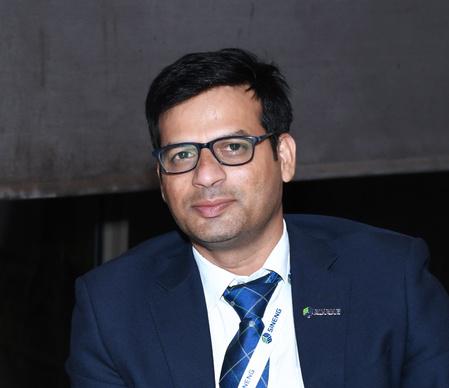












































Government Launches PM-Surya Ghar: Muft Bijli Yojana With New Vendor Rating Programme To Boost Rooftop Solar Adoption
MNRE Grants Provisional Enlistment To Additional Solar PV Module Models, Boosting India’s RE Sector
India’s MNRE Pushes for Solar Growth with New ALMM Guidelines for PV Cells
MNRE Seeks Input On PM Surya Ghar Yojana: Payment Security And CFA For RESCO Models
MNRE Seeks Stakeholder Feedback On Draft Green Hydrogen Certification Scheme For India
MNRE Invites Stakeholder Feedback On Proposed ALMM Amendments For Solar PV Cells, Effective From 01 April 2026
MNRE Expands Vendor Access For Rooftop Solar Installation In Union Territories Under PM Surya Ghar Scheme
MNRE Forms Technical Committee To Finalize Solar Cold Storage Guidelines
Streamlining PM Surya Ghar: Muft Bijli Yojana Implementation Across Rajasthan Discoms
Empowering Rural India: Launch Of Model Solar Village Initiative Under PM Surya Ghar Scheme – MNRE
Assam Electricity Regulatory Commission Introduces Draft Tariff Regulations 2024 For Renewable Energy
India’s PM-Surya Ghar: Muft Bijli Yojana Promotes HighQuality Solar Products For Residential Rooftop Installations
Delhi's Comprehensive Guidelines For Peer-To-Peer (P2P) Renewable Energy Transactions And Advanced Metering Infrastructure
RERC Introduces New Amendments For Grid Interactive Renewable Energy Systems 2024
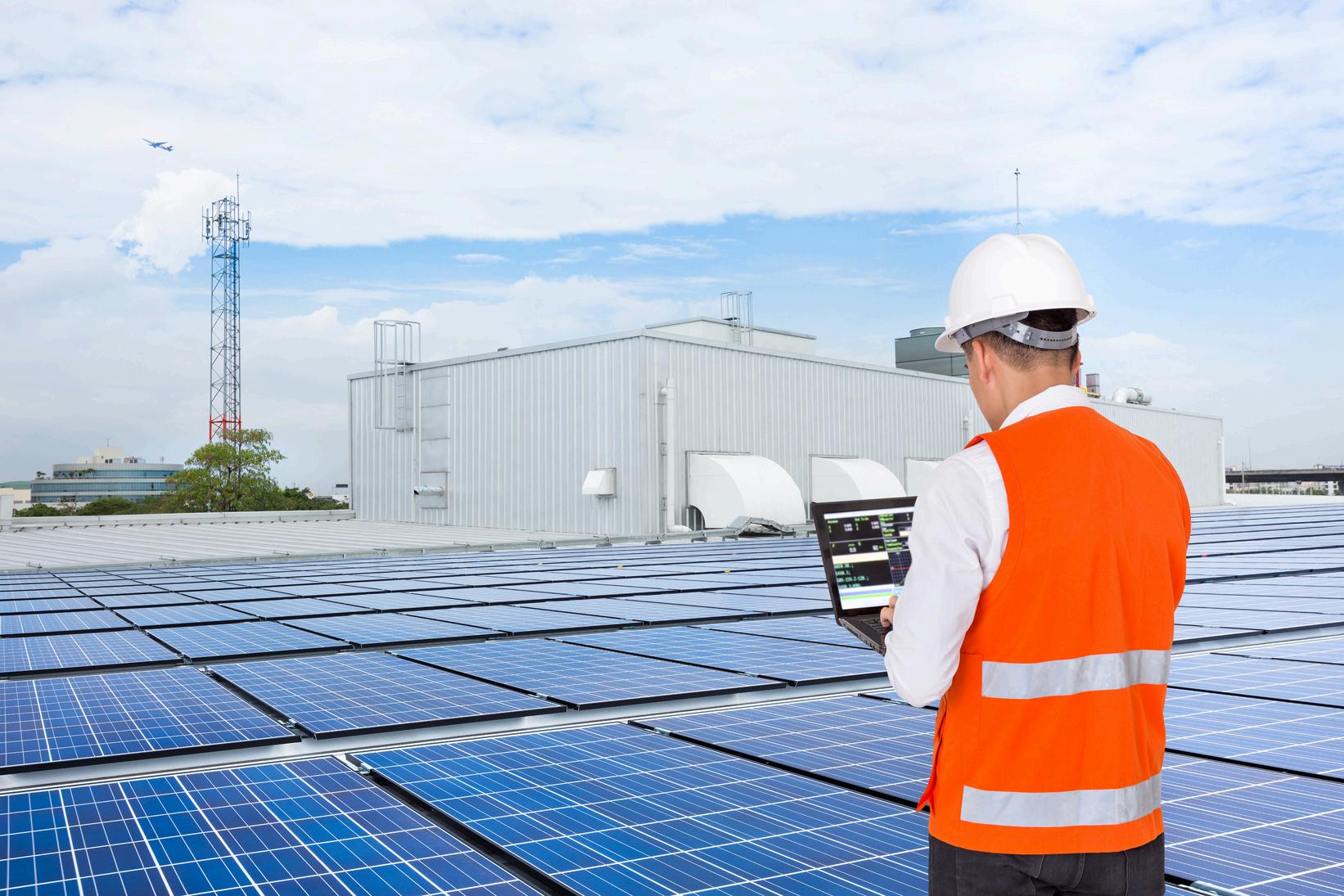
Rajasthan Boosts Agricultural Sustainability With Solar Power: Insights From The PM-KUSUM Scheme
Operational Guidelines And Incentives For Discoms Under The PM Surya Ghar: Muft Bijli Yojana
Gujarat Proposes Fourth Amendment To Net Metering Regulations For Rooftop Solar Systems Up To 100 KW
Kerala’s New Draft Regulation Enhances Forecasting And Scheduling for Wind-Solar Hybrid Projects
Ministry Of Panchayati Raj Urges States To Embrace PM Surya Ghar: Muft Bijli Yojana
RERC Introduces New Amendments For Grid Interactive Renewable Energy Systems 2024
Haryana Simplifies Rooftop Solar Rules With Key Amendments: Faster Approvals And Easier Installations Ahead
Assam Electricity Regulatory Commission Introduces Draft Tariff Regulations 2024 For Renewable Energy
MERC First Amendment Regulations 2024 With Improved Forecasting And Scheduling For Solar And Wind Generation
RERC Approves JVVNL's Competitive Bidding Tariff For 116 33 MW Solar Projects Under PM-KUSUM Scheme
RERC Introduces New Amendments For Grid Interactive Renewable Energy Systems 2024
Government Slashes 7 5% Customs Duty On Solar Capital Goods To Boost Renewable Energy Sector

India’s Renewable Energy Sector Sees 23 7% Job Growth In FY24: Study
Driving Clean Energy: India’s 3.98% Capacity Growth and 23.68% Solar Power Surge in 2022-23
Shaping The Future: Insights From IRENA’s 2024 Renewable Energy Statistics Report
Climate Change And Energy Resilience In Southeast Asia: Navigating Rising Risks And Future Challenges – IEA
Rapid Solar And Storage Deployment Essential To Address India’s Projected 50-80 GW Power Shortages – Report
How India’s New Carbon Market Aims To Cut Emissions And Boost Clean Technology
Driving Clean Energy: India’s 3 98% Capacity Growth And 23.68% Solar Power Surge In 2022-23
India’s Renewable Energy Sector Sees 23 7% Job Growth In FY24: Study
Solar Power Surge: Global Capacity Growth Reaches New Heights In 2024 – Report
India’s Path To Net-Zero: A Comprehensive Roadmap For Green And Transition Finance – Report
Building The Solar System: SBICAPS Report On Funding Revolutions In India’s Solar Growth
Enhancing RPO Effectiveness: Key Takeaways from Prayas Review of India’s Renewable Purchase Obligation Framework.
Hydrogen Strategies Unveiled: A Guide To Meeting 1 5°C Goals And Scaling Up Clean Energy – Report
Ammonia’s Evolution: The Future Of Green And Blue Ammonia Availability From 2030 To 2050- Report
Global Clean Energy Manufacturing Investment Soars 70%: Solar PV and Battery Capacities Near Net-Zero Goals – Report
Achieving $200 Million In Annual Gains: The Financial Impact Of Decarbonization – Report
High Costs And Limited Support Hinder CO2 Utilization As A Decarbonization Tool, Says Report
SJVN Green Energy Announces Tender For Land Acquisition In Punjab For Setting Up Solar Power 200 MW Projects
Power Grid Corporation Of India Invites Bids For Major Solar PV Projects: 1MWp And 600 MWp Plants
KREDL Announces Tender For 100 MW Solar Power Plant In Karnataka
SECI Invites Bids For 7 5 MW Solar PV Power Plant In Rajasthan
North Western Railway’s Jaipur Division Seeks Bids For 2748 kWp Rooftop Solar Power Plant Installation
APGCL Invites Bids For Project Management Consultancy Services For 50 MW Lower Kopili Solar PV Project
NTPC Vidyut Vyapar Nigam Ltd. Announces Tender For 1000 KW Rooftop Solar Project At MIDHANI Hyderabad
NTPC Ltd Announces Tender For 20 MW Ground Mounted Solar PV Project At Vindhyachal
CMPDI Releases Tender For 70 MW Solar Power Plant At Nandan Washery, Maharashtra
North Central Railway Announces Tenders For 7 MWp Rooftop Solar Power Capacity In Prayagraj Division
HPCL Invites Bids For 4.03 MW Solar Power Plants Across Multiple Locations
TCIL Seeks Consortium For 5 MW Solar Power Project At South Eastern Coalfields Limited’s Mines
SECI Plans To Launch The Milestone Tender For 500 MW Solar Thermal Power Storage Project By Year’s End
NTPC Vidyut Vyapar Nigam Limited Invites Bids For 100 MW ISTS-Connected Wind-Solar Hybrid Projects
REIL Invites Bids For 10 MWp Solar PV Projects On Government Buildings In Rajasthan
SECI Invites Bids For 7.5 MW Solar PV Power Plant In Rajasthan
HPPCL Invites Bids For 6 MW Solar Power Project At Tihra Khas I, Una In Himachal Pradesh























































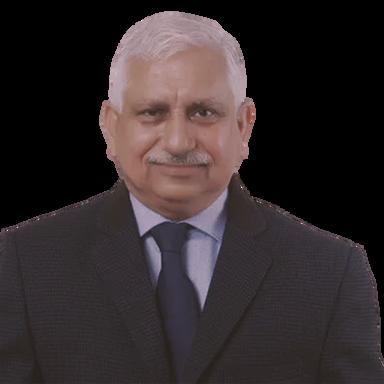


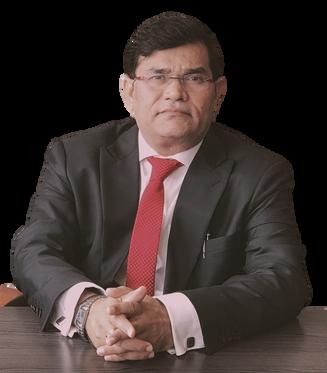





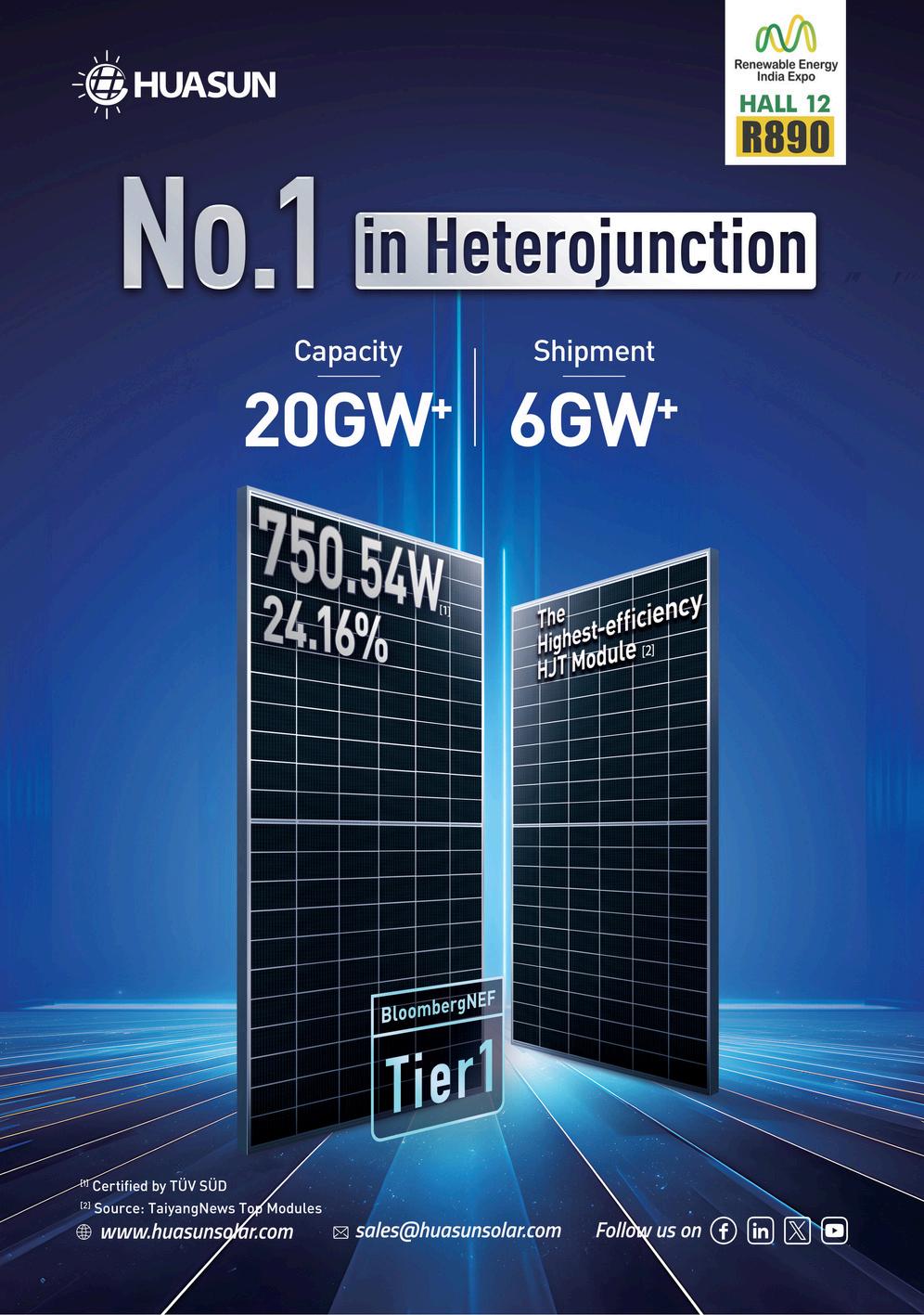





ECE(India)GroupofCompanies
“Leadership is about empowering and inspiring others to grow and develop, regardless of title or position”
About Amit Arokar
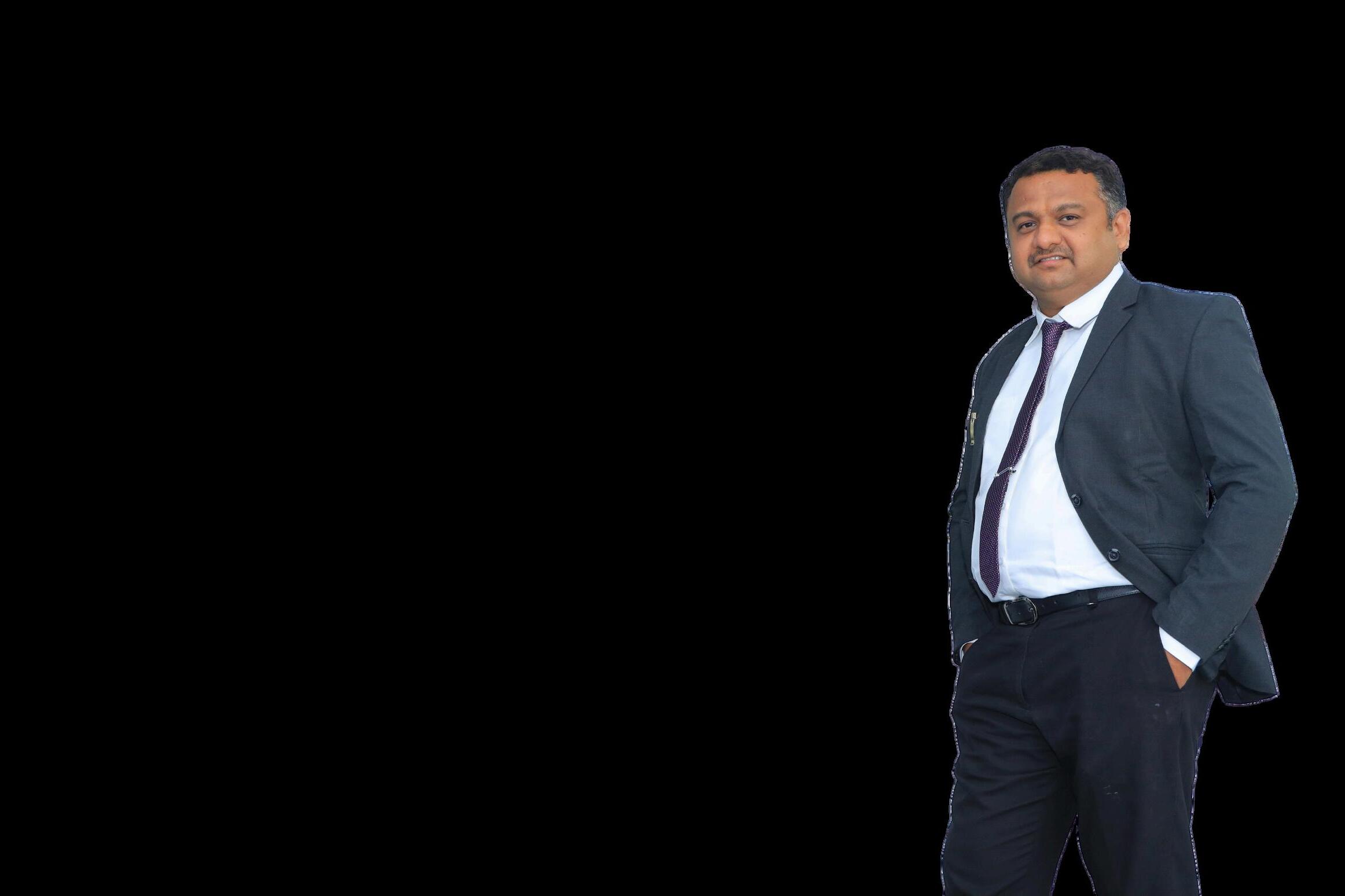

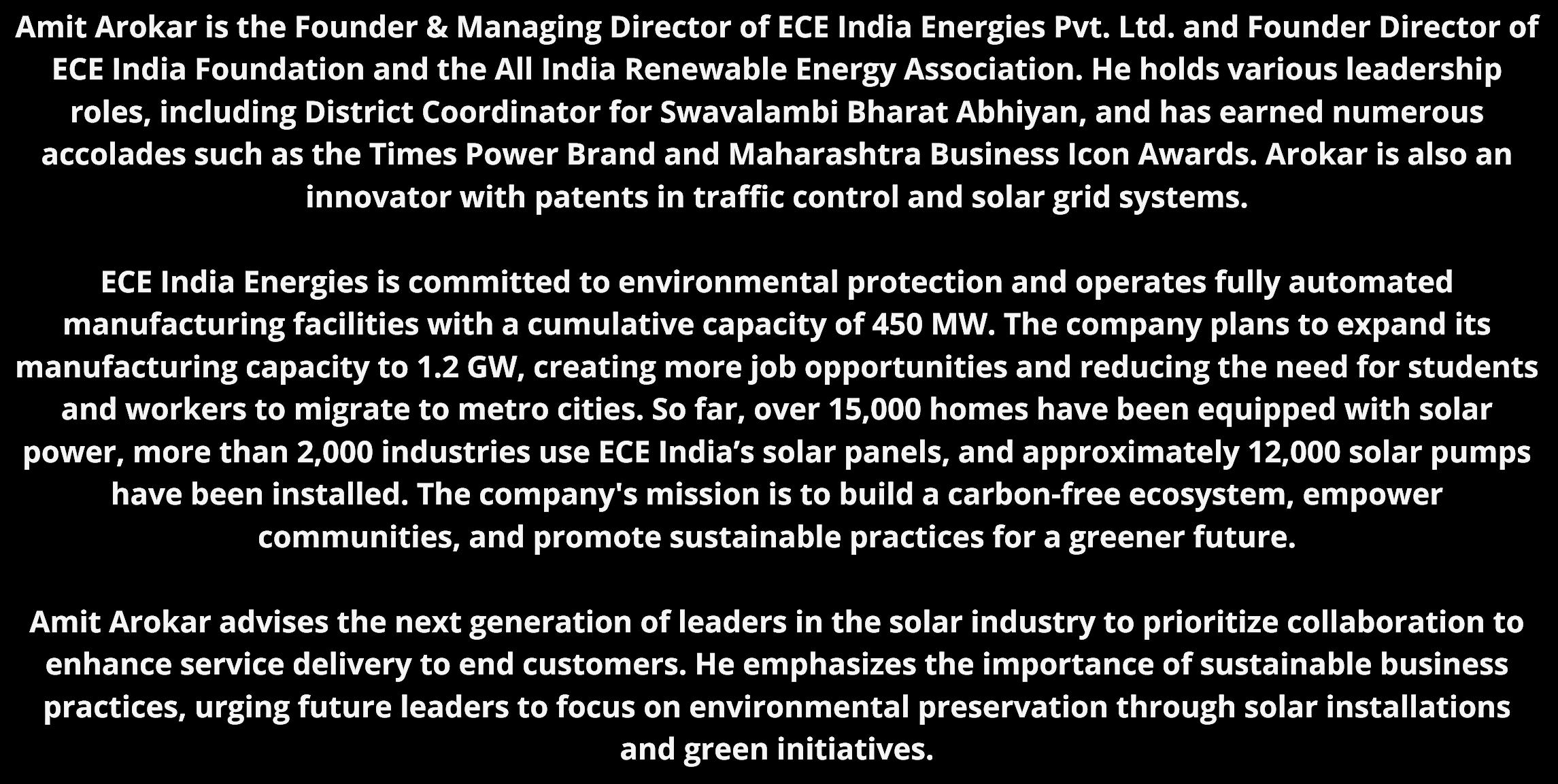





MD&CEO
SunPower&ConsultantsPvtLtd

“Mass adaption of Solar on Rooftop as well as on Water bodies is the need of hour"

About Ajay Chaturvedi
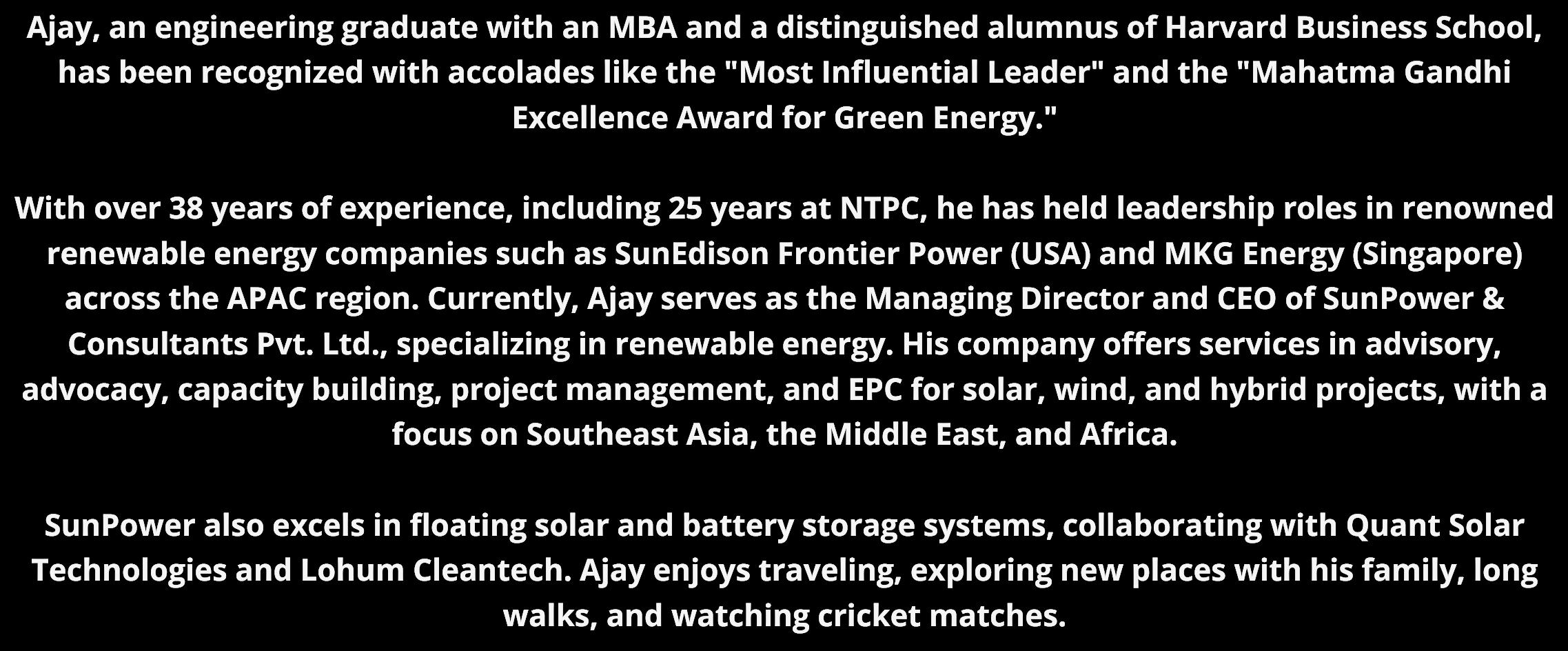
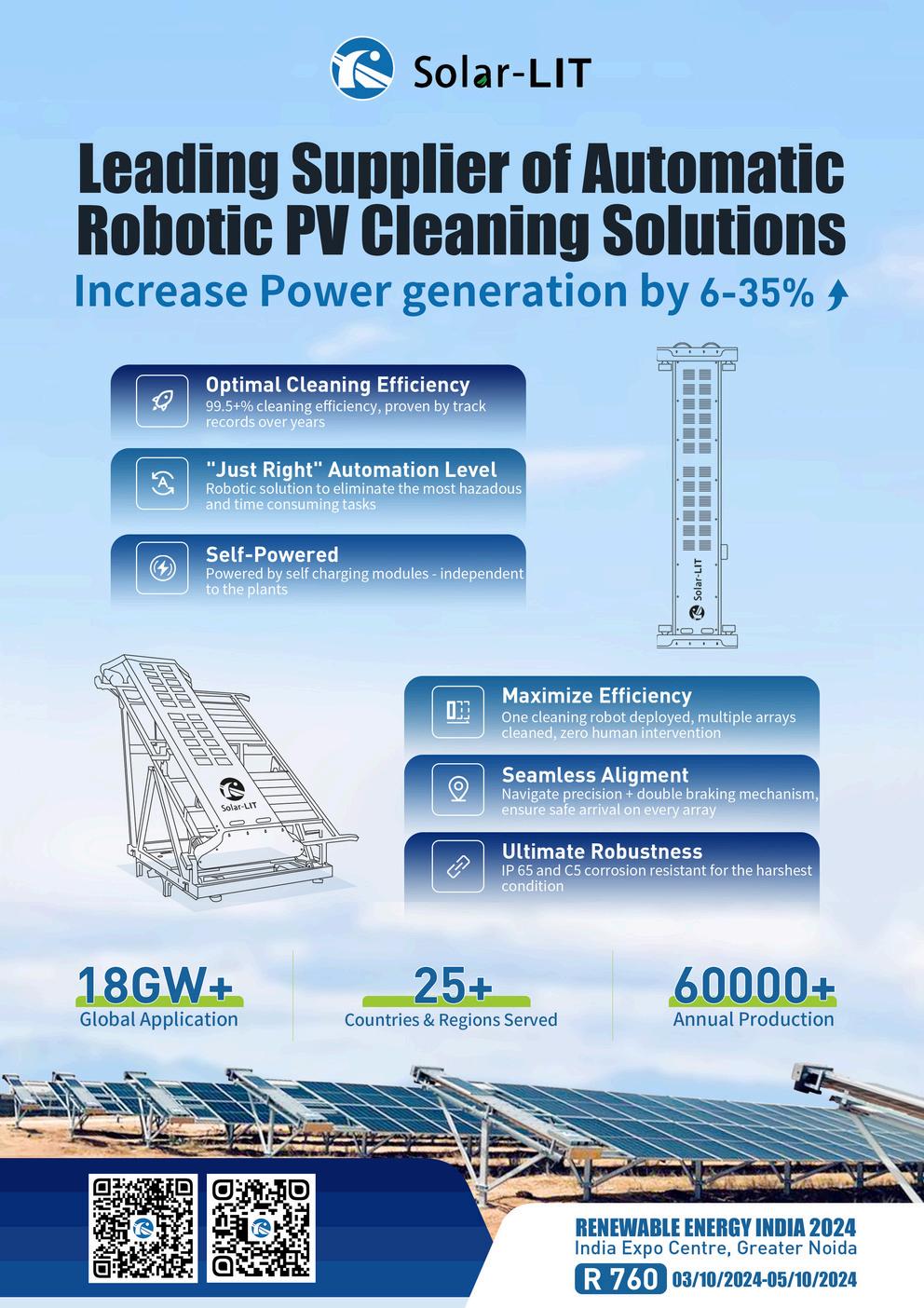






“With



Leadership plays a crucial role in shaping the success of businesses, especially in sectors as dynamic and impactful as energy In India, where the push for energy independence has gained significant momentum, effective leadership is vital to navigating the challenges and opportunities presented by this transformation. As the country strives to reduce its reliance on imported fossil fuels and embrace renewable energy sources, the role of leaders in driving business success and achieving energy independence cannot be overstated
India's energy landscape is undergoing a dramatic shift, with solar, wind, and other renewable energy sources becoming central to the nation's strategy for achieving energy security This shift has been fueled by ambitious government policies, technological advancements, and a growing awareness of the need for sustainable energy solutions However, the journey towards energy independence is complex, requiring visionary leadership at every level of the business ecosystem
One of the primary responsibilities of leaders in the energy sector is to align their businesses with the broader national goals of energy independence This requires a deep understanding of the government's energy policies and a commitment to supporting the country's renewable energy targets Leaders who can effectively navigate the regulatory landscape, secure the necessary permits and approvals, and engage with policymakers are better positioned to drive their businesses forward By aligning their strategies with national priorities, these leaders not only contribute to the success of their businesses but also play a key role in advancing India's energy independence
In addition to navigating the regulatory environment, leaders in the energy sector must also focus on innovation and technological advancement The transition to renewable energy sources requires the adoption of new technologies, from advanced solar panels to energy storage solutions Leaders who prioritize research and development and encourage their teams to explore new ideas are more likely to stay ahead of the competition By fostering a culture of innovation, these leaders can drive the development of cutting-edge solutions that enhance the efficiency and effectiveness of renewable energy projects
Financial acumen is another critical aspect of leadership in the energy sector The shift towards renewable energy often involves significant upfront investments, whether in the form of solar panels, wind turbines, or other infrastructure Leaders who can effectively manage the financial aspects of their businesses, secure funding from investors, and maintain a healthy
balance sheet are better equipped to sustain their operations and achieve long-term success Additionally, by exploring innovative financing models such as power purchase agreements (PPAs) and green bonds, leaders can unlock new sources of capital to fund their renewable energy projects
The ability to build and maintain strong partnerships is also essential for leadership success in the energy sector The complexity of renewable energy projects often requires collaboration with a wide range of stakeholders, including government agencies, technology providers, financial institutions, and local communities. Leaders who can forge strong partnerships and foster open communication with these stakeholders are more likely to overcome the challenges that arise during project development and implementation. Moreover, by engaging with local communities and ensuring that their needs and concerns are addressed, leaders can build trust and support for their projects, which is critical to their long-term success
Another key aspect of leadership in the energy sector is the ability to inspire and motivate teams The transition to renewable energy is a challenging and often uncertain process, requiring employees to adapt to new technologies, regulations, and business models Leaders who can clearly communicate their vision, provide the necessary training and support, and recognize and reward their teams' efforts are more likely to build a committed and resilient workforce By fostering a positive work environment and promoting a sense of purpose, these leaders can drive their teams to achieve their full potential and contribute to the success of the business.
Finally, leaders in the energy sector must be forward-thinking and adaptable The energy landscape is constantly evolving, with new technologies, market dynamics, and regulatory changes emerging regularly Leaders who can anticipate these changes and adjust their strategies accordingly are more likely to thrive in this rapidly changing environment By staying informed about industry trends, engaging in continuous learning, and being open to new ideas, leaders can position their businesses to succeed in the long term
Leadership is a critical factor in the success of businesses and the achievement of energy independence in India By aligning their strategies with national goals, fostering innovation, managing finances effectively, building strong partnerships, inspiring teams, and staying adaptable, leaders can navigate the complexities of the energy sector and drive their businesses to success As India continues its journey towards energy independence, the role of effective leadership will become even more important in shaping the future of the country's energy landscape





CEO WaareeEnergiesLtd.



“Leadership for us at Waaree Energies lies in bringing together exceptional talent, fostering a cohesive and motivating environment, and aligning everyone towards a common goal with passion and purpose. It’s about consistently driving results through a shared commitment to excellence.”
About Dr. Amit Paithankar


Ningbo, China – September 6, 2024 – Solis, a global leader in solar inverter technology, proudly announces that it has surpassed the 100GW mark in cumulative shipments This significant milestone underscores Solis’ commitment to driving innovation and excellence in the renewable energy sector
Established in 2005, Solis has rapidly ascended to become one of the world's foremost manufacturers of solar inverters As the third-largest PV inverter manufacturer globally, Solis has maintained a strong presence in the industry through its dedication to quality and customer satisfaction The company, a subsidiary of Ginlong Technologies, has earned recognition for its innovative approach and reliable products, which have been key to expanding solar adoption worldwide
“We are thrilled to achieve this remarkable milestone,” stated Yiming Wang, Founder and Chairman of Ginlong Technologies “Reaching over 100GW in cumulative shipments is a testament to the trust our customers place in our products and the hard work of our dedicated team. This accomplishment reflects our relentless pursuit of excellence in delivering reliable, high-performance solar solutions ”
Looking ahead, Solis remains focused on expanding its global footprint and advancing the transition to clean energy. The company plans to enhance its research and development efforts to bring new, cutting-edge technologies to market, driving down the cost of solar energy and making it more accessible worldwide
“Our journey is just beginning,” Wang continued “We will continue to innovate and set new standards in the solar industry, helping our customers and partners achieve their sustainability goals and contribute to a greener planet ”
Solis extends its gratitude to its partners, customers, and employees for their invaluable support in reaching this milestone. Together, they are not only delivering clean energy solutions but also paving the way for a more sustainable future
Ginlong (Solis) Technologies (Stock Code: 300763 SZ) is one of the most experienced and largest manufacturers of PV string inverters. Under the Solis brand, the company’s portfolio employs innovative string inverter technology to deliver first-class reliability, validated by the most stringent international certifications With a global supply chain, world-class R&D, and manufacturing capabilities, Ginlong optimizes its inverters for each regional market, servicing and supporting its customers with a team of local experts
For more information, visit:www.solisinverters.com









CEO OorjanCleantech
“Renewable Energy is commercially viable and Environmentally Responsible to fuel sustainable economic and social growth.”
About Gautam Das
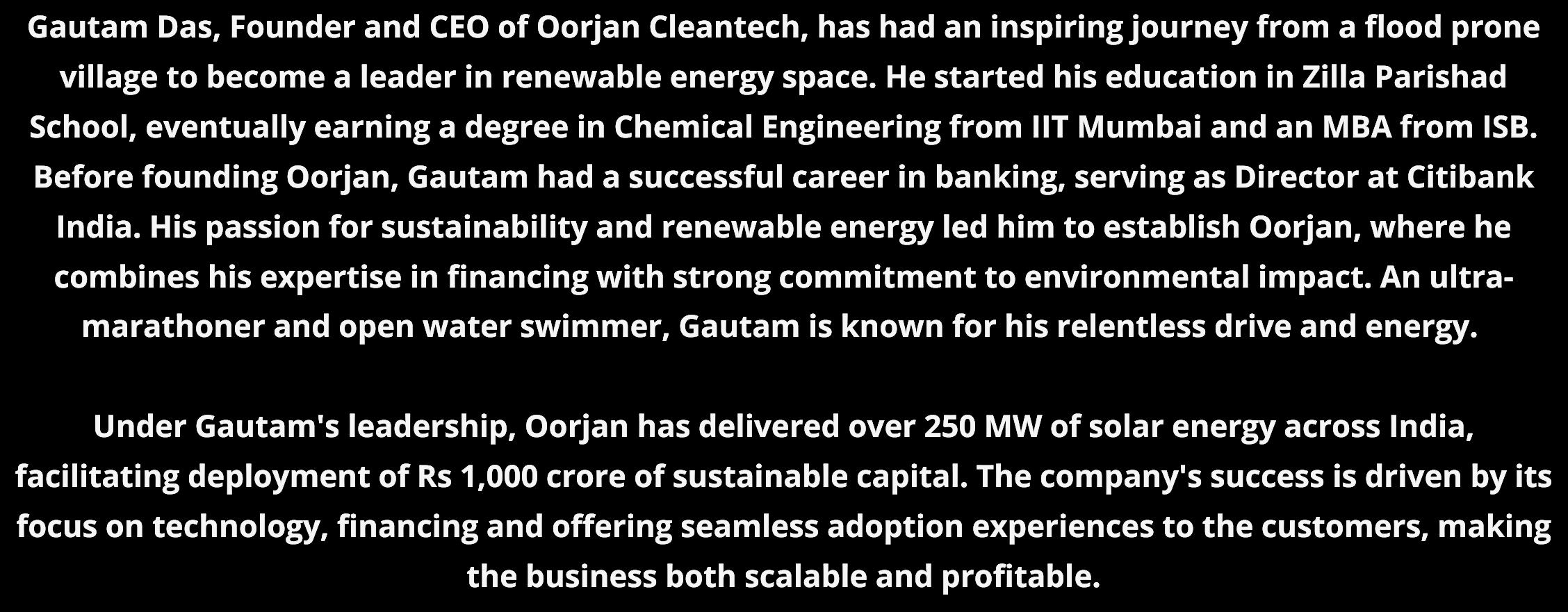

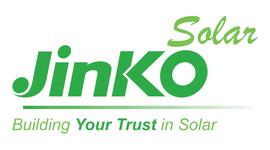
JinkoSolar, the global leading PV and ESS supplier, today announced a new global partnership with Manchester City The new partnership will allow JinkoSolar to accelerate its market presence to a global audience and to support the Club’s effort to become one of the largest producers of renewable energy in world football
JinkoSolar is a globally renowned and highly innovative solar technology company Embracing the mission of "changing the energy portfolio and taking responsibility for enabling a sustainable future", JinkoSolar has maintained its position as the global leader in module shipments for five years.
As of the first quarter of 2024, Jinko Solar has delivered a total of more than 230 GW of module shipments globally, with 1 out of every 8 solar panels installed on earth coming from JinkoSolar
Through the partnership, JinkoSolar will connect and engage with Man City fans globally to jointly promote the use of solar energy through their innovative and award-winning solar products and further educate fans on how they can play a part towards a sustainable future
Jinko will also support the club’s plans to make its training facility, City Football Academy, one of the largest producers of renewable energy in world football Announced earlier this year, the project forms a key part of Manchester City’s goal of becoming carbon net zero by 2030
As leaders in renewable energy and sports, this partnership will set a powerful example of the transition to sustainable energy solutions and as the JinkoSolar brand continues to grow globally, will further accelerate its market presence to both businesses and consumers around the world
Kaitlyn Beale, Vice-President of Global Partnerships Sales at City Football Group, said: “We are delighted to announce this new global partnership with JinkoSolar Manchester City and JinkoSolar are two leading organisations that put an emphasis on innovation in our respective fields Both organisations are committed to creating a lasting change and empowering better lives, and we look forward to JinkoSolar joining our journey as we aim to create a more sustainable future.”
Gener Miao, Chief Marketing Officer at JinkoSolar, said: “We are excited to announce a landmark partnership between JinkoSolar and Manchester City Football Club, uniting two champions in their respective fields. This "champion to champion" collaboration celebrates excellence in sports and renewable energy, paving the way for a brighter, more sustainable future
“Together with Manchester City, we are dedicated to advancing sustainability and showcasing how renewable energy can lead to a healthier planet We eagerly anticipate the positive impact we will create on this exciting journey ”

Manchester City FC was initially founded in 1880 as St Mark’s West Gorton and officially became Manchester City FC in 1894 Situated on the wider Etihad Campus, the Club’s footprint includes the 53,500 capacity Etihad Stadium, the 7,000 capacity Joie Stadium and City Football Academy, a state-of-the-art performance, training and youth development facility home to the Club’s men’s, women’s and academy teams
Ranked as the Most Valuable Football Club Brand in the world by Brand Finance, Manchester City FC is currently developing a best-in-class fan experience and year-round entertainment and leisure destination at the Etihad Campus The Club is committed to operating in a sustainable and socially responsible manner and ensures that equality, diversity, and inclusion is embedded into its decision-making processes, culture, and practices
For more information, please visit www.mancity.com
Jinko Solar Co Ltd (referred to as "JinkoSolar" stock code: 688223) is a globally renowned and highly innovative solar technology company Embracing the mission of "changing the energy portfolio and taking responsibility for enabling a sustainable future "
JinkoSolar's products serve over 190 countries and regions worldwide, catering to more than 3,000 customers As of the first quarter of 2024, JinkoSolar has maintained its position as the global leader in module shipments for five years, with a cumulative total of more than 230 GW of module shipments The company is an industry opinion leader in various international frameworks, including the B20, and joined the RE100 green initiative in 2019
Jinko Solar was listed on the STAR Board of the Shanghai Stock Exchange in 2022, and JinkoSolar Holding Co Ltd , its indirect controlling shareholder, was listed on the New York Stock Exchange in 2010
For more information, please visit https://www jinkosolar com/en






VPofInternationalBusiness,CEOofArctech India,andDirector&CEOofJashEnergy
"True leadership empowers teams to explore new markets, embrace diverse cultures, and drive sustainable growth for a greener future."



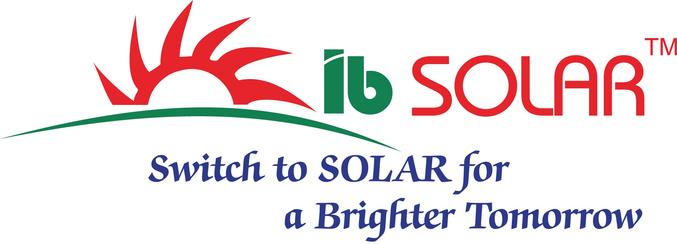
IB Solar, one of the leaders in India's solar industry, combines over three decades of expertise with cutting-edge technology to deliver high-quality, ALMM-listed solar panels With a stateof-the-art facility in Noida and a focus on sustainable energy, IB Solar drives India’s clean energy future with precision and innovation.
Below are the words of appreciation from Dignitaries invited to the grand event hosted at Aerocity, New Delhi on the occasion of the 10GW virtual factory inauguration which will continue to motivate team Sungrow to aim and achieve new milestones-

Abhay Mahajan
Proprietor Abhay Enterprises
We take immense pride in being IB Solar’s distribution partner for Punjab and Himachal Pradesh since 2015 IB Solar has consistently set the standard for excellence, delivering not only top-tier product quality and timely deliveries but also impressive power generation results The exceptional feedback from our customers underscores the trust and satisfaction they have in IB Solar's offerings This trust has empowered us to build a robust network of 100-170 channel partners who rely on IB Solar for all their EPC needs, driving consistent and successful business growth

Proprietor Sach Collection Point
Our association with IB Solar over the past five years has been nothing short of exceptional For all our solar power plants, rooftop subsidy, and C&I projects, IB Solar has been our unwavering partner of choice The satisfaction of our customers has led to a substantial number of repeat orders, which in turn has significantly expanded our business reach. With such consistent success, we see no reason to look elsewhere for our solar needs

Director Static Energy M. Srinivasa Reddy
Over the past 7-8 years, our collaboration with IB Solar has been pivotal in executing some of the most prestigious projects across Jharkhand and Orissa, including solar installations for railways, power plants, and street lighting The consistent quality of their products, coupled with exceptional power generation performance, has not only met but exceeded our expectations. With installations ranging from 3 kW to 10 MW, our clients have repeatedly expressed their satisfaction Recognizing the unparalleled reliability of IB Solar, we have now extended our partnership to include IB Energy Lithium-ion solutions for standalone applications under JREDA and OREDA. This strategic move reinforces our commitment to delivering innovative and sustainable energy solutions in the region

At Supaasi Solar, our choice to exclusively use IB Solar's Mono PERC Half-Cut panels for all our subsidy and PM KUSUM projects in Uttarakhand and Uttar Pradesh speaks volumes about their unparalleled quality, exceptional power generation, and prompt delivery. However, what truly sets IB Solar apart is their remarkable management and team Their friendly, responsive, and highly effective approach to project execution consistently exceeds our expectations, ensuring seamless collaboration and outstanding results It is this combination of superior products and a dedicated, professional team that makes IB Solar an invaluable partner in the Indian solar industry


Hitaksh Sachar
Director
Asun Solar Power
At Asun Solar Power, our collaboration with IB Solar has been more than just a business partnership it has been a journey marked by trust and friendship, particularly with Mr Abhinav Mahajan, whose industry expertise is matched by his remarkable character We have consistently chosen IB Solar’s Mono PERC Half-Cut panels, crafted with the latest technology, for our rooftop subsidy projects, including the prestigious Club Mahindra project in Himachal Pradesh With installations ranging from 2 kW to 500 KW, the feedback from Club Mahindra and our other clients has been overwhelmingly positive, further solidifying IB Solar's reputation for excellence in the industry
Learn more about IB Solar by visiting: www ibsolar com




(AMemberoftheShellGroup)
“Dream big and have the courage to follow - your journey will be the reward.”
About Gaurav Sood


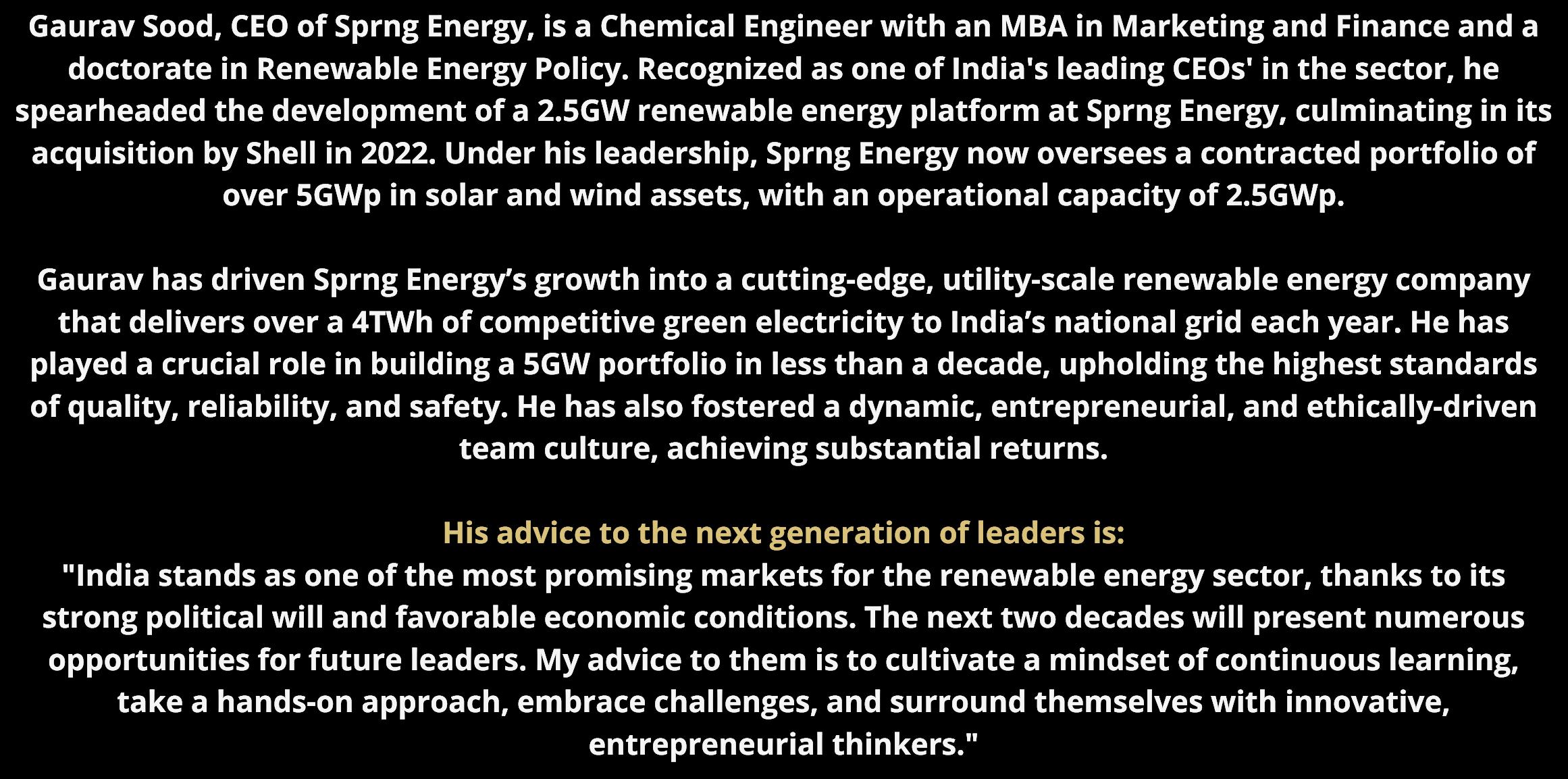


From October 3rd to 5th, SMA India will showcase its innovative energy solutions at REI 2024, Hall 15, Booth R1020, at the India Expo Centre in Greater Noida As a leader in the renewable energy sector, SMA offers comprehensive solutions for both commercial and large-scale applications, enabling seamless project implementation and efficient energy management
The SMA Commercial Energy Solution opens up flexible options for you: Depending on the needs of your customers, you can implement individual applications from PV power generation and use to holistic energy systems including battery storage, electromobility and heat pumps With compatible hardware, intelligent software, and supporting services, you'll have plenty of configuration options at your fingertips. For long-term customer relationships – and new business opportunities again and again Discover your options at REI
SMA’s Large Scale Energy Solutions are tailored for power plant owners, investors, and grid operators, offering robust support for clean and stable utility grids The company’s commitment to innovation and excellence is evident in its diverse range of products and services that empower the renewable energy community
Explore how SMA is leading the charge in ensuring grid stability and energy-system resilience in the face of growing renewable energy demands Did you know SMA's advanced grid-forming capabilities and innovative inverter technology are key to maintaining a robust and reliable energy supply? As the world shifts toward a sustainable future, SMA's solutions are crucial in preventing blackouts and supporting a cleaner, greener grid
Discover more about how SMA is securing the energy systems of tomorrow.
Visitors to the booth can engage with SMA’s team of experts, explore cutting-edge technologies, and participate in in-booth events designed to foster collaboration and knowledge sharing. The event presents a unique opportunity to become part of a global movement towards a sustainable energy transition
Join SMA India at REI 2024 and be a part of the change towards a greener tomorrow Whether you are looking for energy solutions for your commercial enterprise or large-scale projects, SMA provides the e T









Novasys Greenergy Pvt Ltd is a Nagpur based Solar Panel manufacturing company which was started in 2016 with a vision to promote renewable energy products With this vision, when we found policies framed by the government. for the promotion of Solar Energy very supportive & we started with Roof-Top EPC work for residential, private companies & govt projects In the process, we found quality solar panels are very important to justify the benefits of solarisation
With a team of well qualified & well experienced people having more than 20+ years of Solar Experience, we started working on setting up a Solar Panel manufacturing unit starting with 100MW/year capacity in the year-2018 Today, with increasing demands of solar & very friendly govt. policies to promote solar energy, we have expanded our capacity to 1 2GW in the last 6years We are further expanding to 3 5GW by 2026
Our manufacturing Set-up is fully automated of world class & we produce almost all ranges of Solar modules which are in demand like Mono-Perc half cut upto 550Wp in P-type and now introducing N-type TopCone modules with range upto 650Wp We have all required certifications as per global standard and we are in the list of ALMM as well which is very much required in India

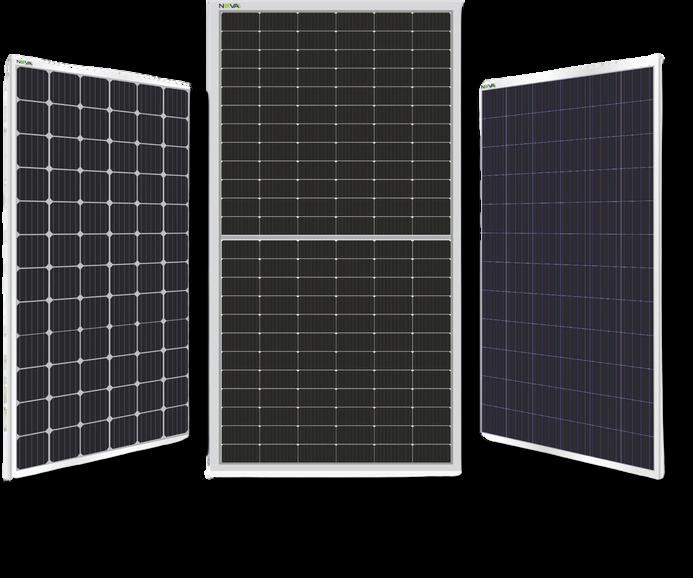
We do have presence in EPC with present cumulative experience of 50MW+ projects & we are now developing Solar Park wherein we can sell power to private as well as govt. companies as per their requirements under Open Access- PPA mode
India’s solar industry faces its share of challenges, particularly in securing essential raw materials like silicon, which often leads to price fluctuations and technological uncertainties. Despite these hurdles, we remain optimistic about the future.
As we all know that govt is targeting to achieve 450GW Solar Installations by 2030, we all solar companies are geared up to meet the targets and ready to face challenges which may come as we progress India presently has limited resources of required components mainly silicon due to which major requirements are getting fulfilled from China. Due to which we face frequent price & technology variation challenges We are hopeful that India will have its own ecosystem very soon which will help us in overcoming these challenges









“Leadership is not just about steering a company; it's about inspiring a team to innovate and excel. At WAACAB, we transform challenges into opportunities and vision into reality”
About Ketan Vora
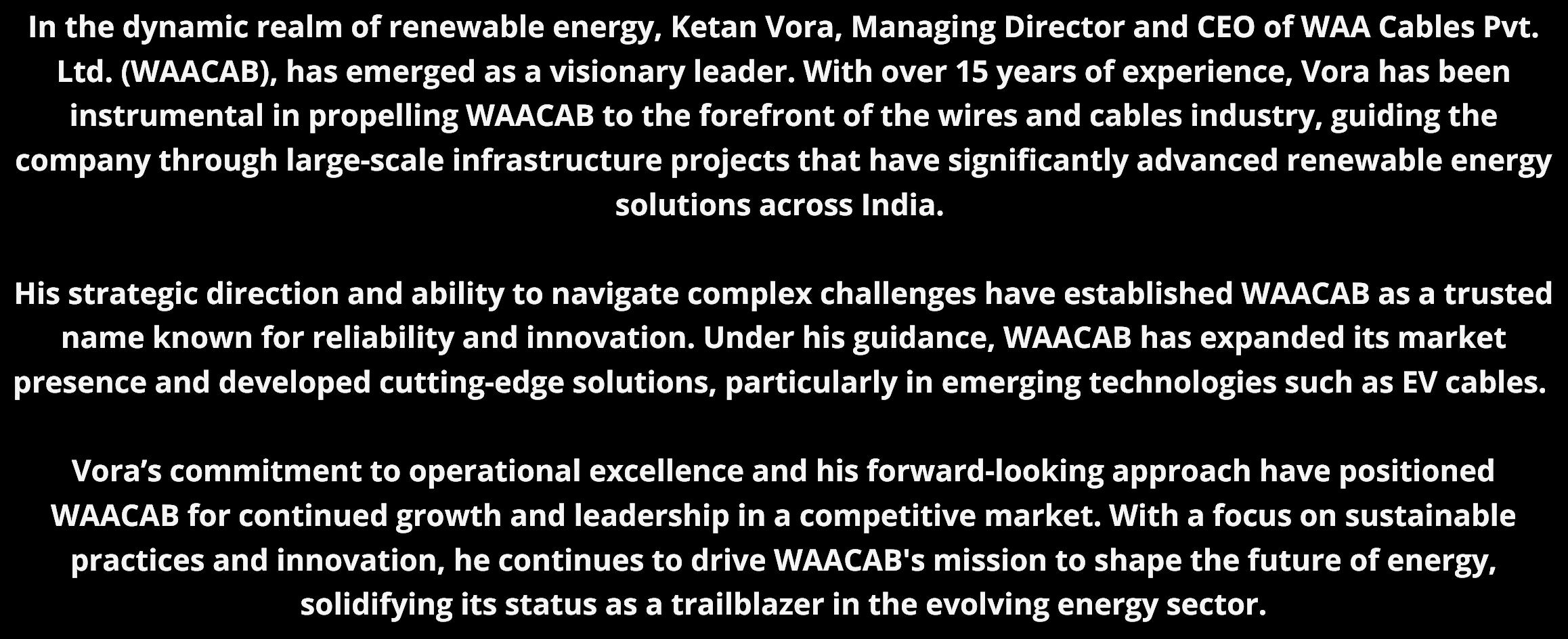


In the rapidly advancing world of solar energy, selecting the right partner can significantly impact the success of your project At Purshotam Profiles Pvt Ltd , we take pride in being India’s leading manufacturer of Module Mounting Structures (MMS), with an impressive manufacturing capacity of over 35,000 metric tons per month Our expertise and dedication have made us a trusted name in the solar industry, and here’s why we should be your first choice for solar solutions
Your Preferred Partner
With extensive experience and a proven track record, Purshotam Profiles has established itself as the preferred partner for countless solar projects across India We work closely with our clients, offering tailored solutions that meet specific project needs while adhering to international standards Our goal is to support your success with superior products and exceptional service.
With a production capacity of over 35,000 metric tons per month, we have the infrastructure to meet the demands of projects of any scale Whether large or small, we ensure timely delivery without compromising on quality, thanks to our efficient and robust manufacturing processes.
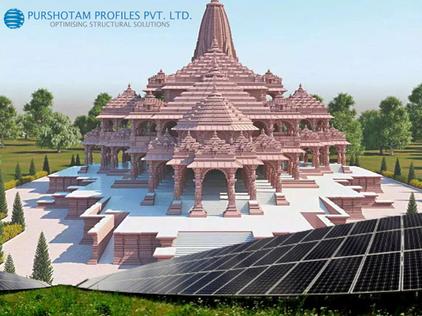
Unmatched Manufacturing Capacity Proven Track Record
Our impressive portfolio includes 35 GW of MMS supply, making us a reliable partner for many of India’s leading Solar EPC players and developers Our consistent performance across numerous projects is a testament to our commitment to excellence and reliability, solidifying our reputation in the industry.
Quality You Can Trust
At Purshotam Profiles, quality is our top priority We recognize the critical role that module mounting and tracker structures play in solar power systems To guarantee long-lasting performance, we implement stringent quality control measures at every stage of production. Our focus on delivering top-tier products ensures you receive durable, highperformance solutions that stand the test of time
By choosing Purshotam Profiles Pvt Ltd , you are aligning with a leader in solar solutions who is committed to driving your project forward with excellence
We are thrilled to share some exciting news from Ayodhya, Uttar Pradesh, a city steeped in history and now embracing the future of sustainable energy. Purshotam Profiles is proud to be part of a landmark solar project at the Ram Mandir, a symbol of cultural heritage and a beacon for renewable energy
In collaboration with Jakson and NTPC, we have been entrusted with the opportunity to contribute to this transformative initiative. We extend our heartfelt thanks to both organizations for their confidence in us and their shared commitment to making Ayodhya a model solar city
As Ayodhya transitions towards a sustainable future, this project is a reflection of Prime Minister Shri Narendra Modi's vision for a greener India It not only represents a significant step towards clean energy but also serves as an inspiration for communities across the nation to follow in the footsteps of renewable energy solar energy in India and remain committed to driving sustainability through innovative solutions

At Purshotam Profiles Pvt. Ltd., we are excited about the future of solar energy in India and remain committed to driving sustainability through innovative solutions.







CEO v.m
“Accelerating solarization - Making solar energy accessible through simplicity, agility, and optimization to empower a brighter future for everyone.”

About L K Verma
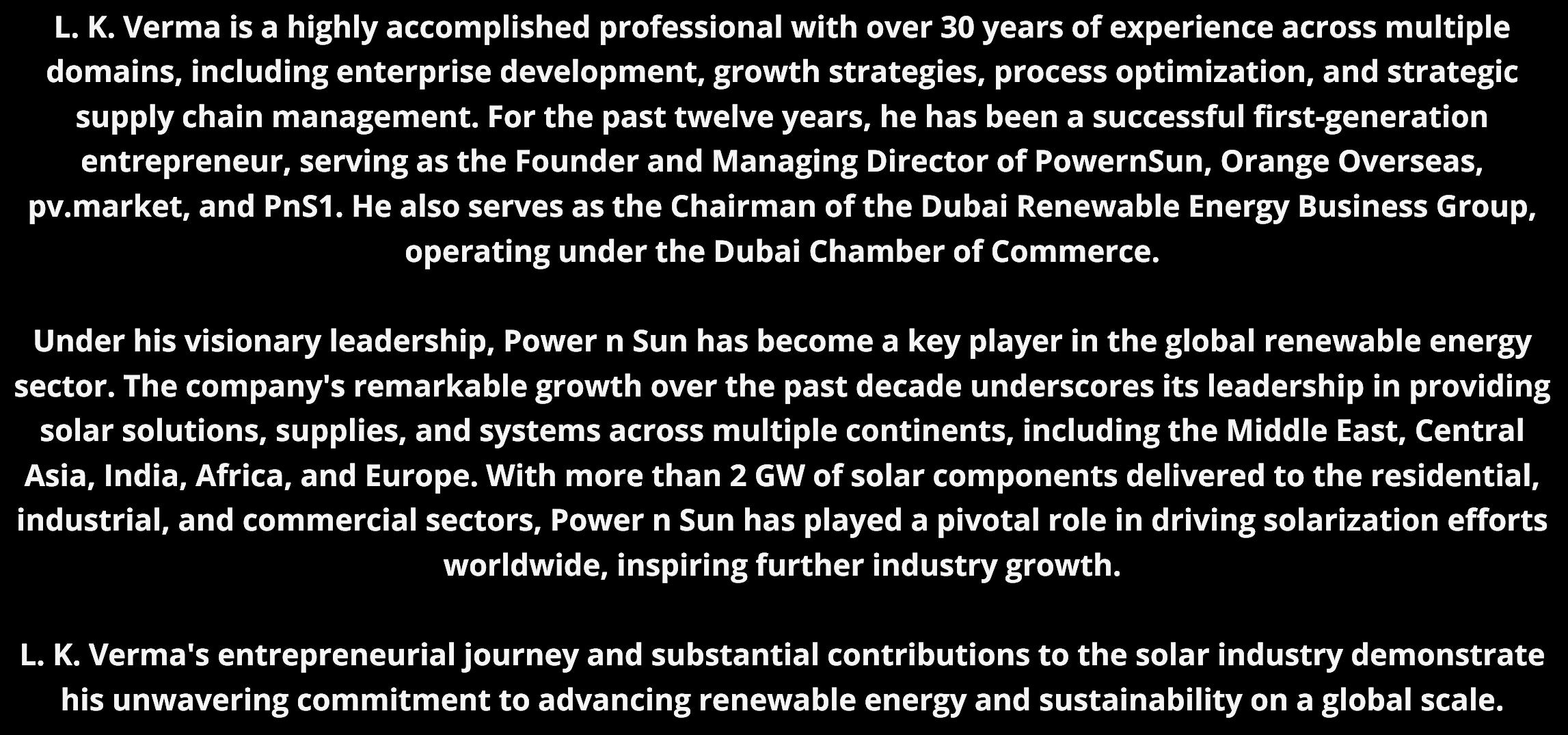
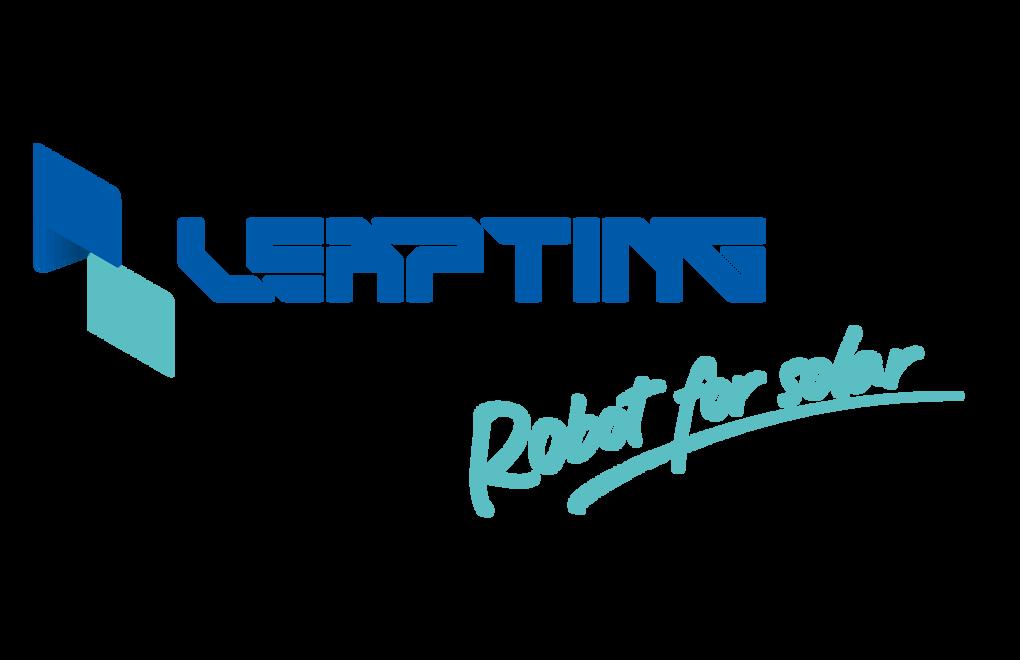
LEAPTING G2 Automatic Navigation Vehicle-mounted Cleaning Robot has been fully equipped and delivered, would be demonstrating at the REI exhibition in October!
In this scorching summer season, LEAPTING Technology (LEAPTING) has delivering the first full release of the G2 automatic navigation vehicle-mounted cleaning robot (G2 cleaning robot) commercial project, making it a highly anticipated release! To ensure prompt delivery to our valued customers, all employees from the R&D, sales, purchasing, and logistics departments are dedicatedly working on the production line, exerting their efforts in their respective roles to guarantee timely product delivery
Since its establishment, LEAPTING has been committed to the intelligent operation and maintenance application throughout the entire life cycle of photovoltaic power stations By deeply integrating artificial intelligence technology, we have independently developed a series of unmanned intelligent robots specifically designed for the field of photovoltaic power plants These robots provide high-efficiency and cost-effective operation and maintenance solutions, thereby reducing operational expenses and enhancing system power generation. So far, LEAPTING intelligent robots have surpassed 10,000 units in global shipments!
At the delivery site, four state-of-the-art G2 automatic navigation vehiclemounted cleaning robots were prepared for dispatch and will soon be deployed overseas to perform fully automated cleaning of PV modules at PV power plant The G2 cleaning robot, representing the flagship product of LEAPTING Cleaning's portfolio, are optimally designed to meet the cleaning requirements of large-scale solar power plants They feature advanced high-precision autonomous navigation systems and employ multi-sensor fusion technology to facilitate environmental perception and positioning, thereby enabling seamless autonomous navigation and movement The self-engineered high-speed brush is capable of swiftly and effectively eliminating dust and debris from the surface of PV modules, achieving a remarkable cleaning efficiency! Furthermore, when encountering obstacles between the PV module tables, the mechanical arm can identify and manipulate the G1 cleaning robot to execute cross-obstacle operations, thereby offering a more flexible and intelligent cleaning solution
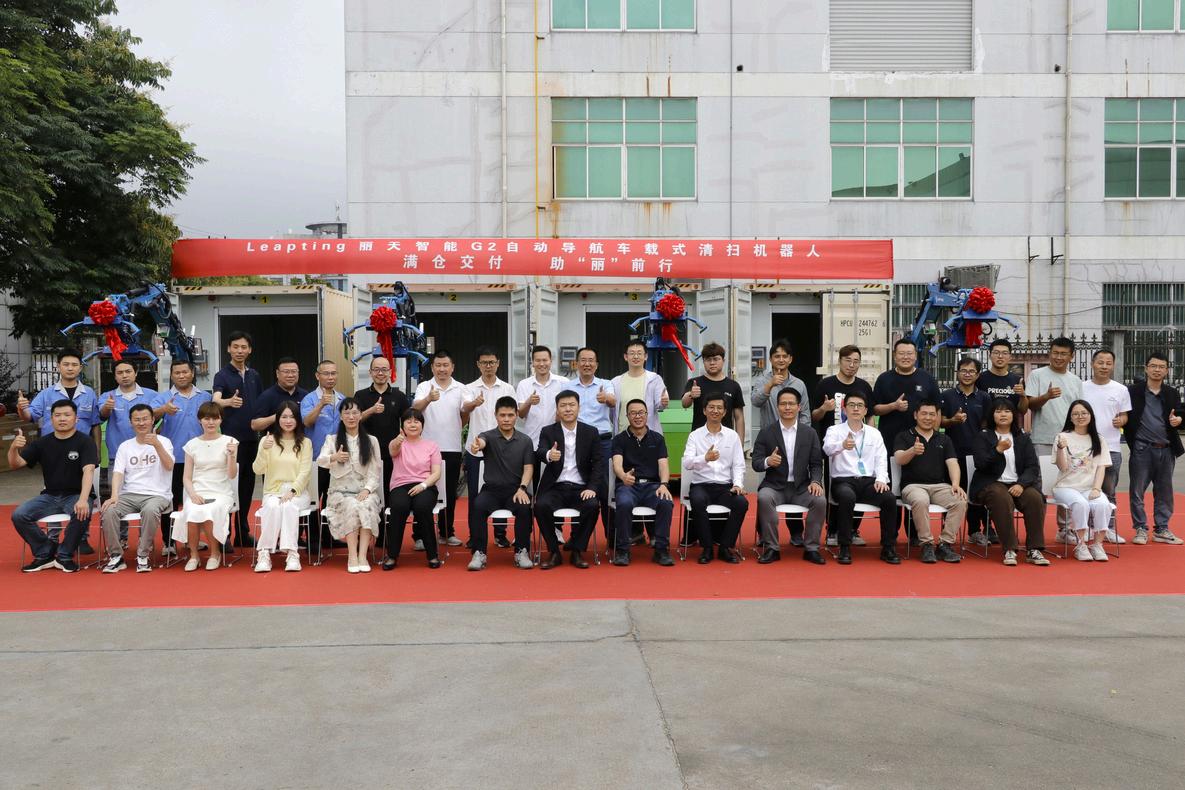
Bruce Wang, the Founder and CEO of LEAPTING, addressed the audience at present, stating, “The G2 cleaning robot represents a truly mobile, AIdriven autonomous navigation solution that significantly reduces manual maintenance efforts and costs for large ground-mounted photovoltaic power plants This innovative approach not only liberates human labor but also enhances cleaning efficiency twofold, thereby offering limitless possibilities for addressing the cleaning needs of photovoltaic power plants!”
As the deadline approached, we received a picture from the overseas project site team showcasing the arrival of the G2 cleaning robot The unboxing of the G2 cleaning robot not only sparked expectations among all Leaptingers but also heralded the dawn of a new era in solar power station cleaning.
What is particularly exciting is that we will have the opportunity to experience the technology and capabilities of G2 cleaning robot firsthand at the REI exhibition in 2024 From October 3rd to 5th, we invite you to visit us at booth R592 in Hall 11 of the Greater Noida India Expo Centre in New Delhi, India We warmly welcome you visit and communication!

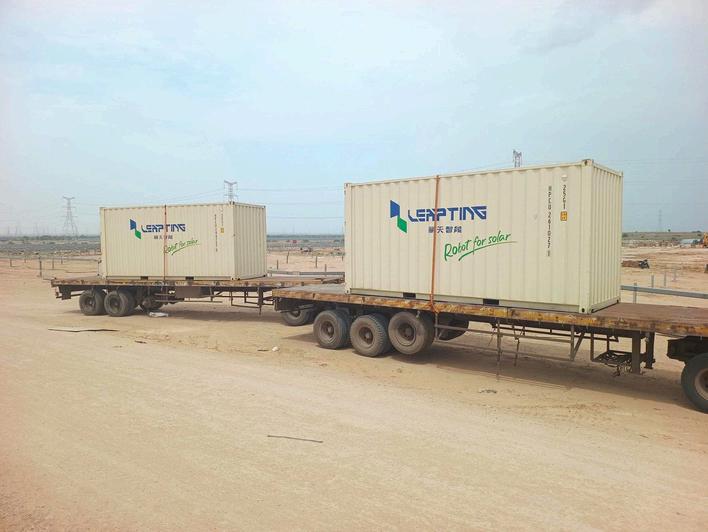






“We’re redefining the future of energy by leading decarbonization efforts with transformative solutions, driving a sustainable and resilient global energy transition.”
About Manan Thakkar
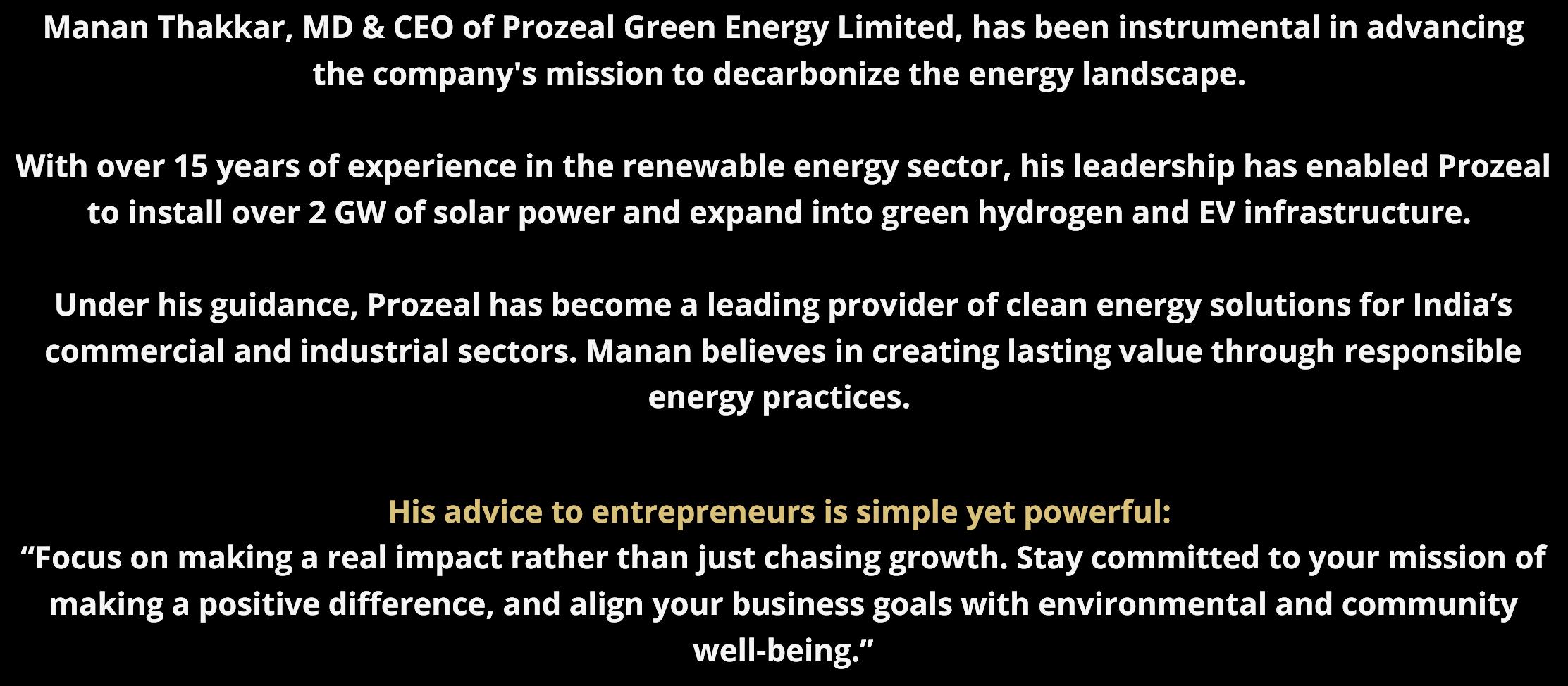


Director Sunora Solar)
SUNORA SOLAR, is among the leading manufacturers of HighPerformance and Premium quality Solar Panels, With more than 8 years of impeccable solar segment records & a current manufacturing capacity of 800MW (with plans of expansion up to 2 GW by 2024-25 end SUNORA SOLAR has made it amongst the Top Solar Companies in India as per ALMM List w.e.f 24/02/2024. A rich history of successful operations in the industry, the company boasts an impressive record of more than 5000 clients, more than 300 completed projects, & a strong network of more than 200 Channel Partners across 70+ Districts
Our Products TOPCon PV Modules, Mono H /C Faical/ Bifaical PV Modules, DCR PV Modules SUNORA Solar brand ranging 630Wp will be available in the market All the products of the company are ALMM-approved and are recognized by national and international standards like, BIS, IEC, etc. SUNORA SOLAR promotes the Make in India mission by participating in the country’s leading schemes like Jal Jeevan Mission, Pradhan Mantri Kusum Yojana, Surya Ghar Yojana, and Solar Park
The current Scenario of India's solar PV panel market size was estimated to be USD 7.31 billion in 2023 and is projected to grow at a CAGR of 9 4% from 2024 to 2030 The solar PV market in India is experiencing significant growth driven by a combination of factors It includes supportive government policies such as the Jawaharlal Nehru National Solar Mission (JNNSM) and state-level initiatives, decreasing solar panel costs due to technological advancements /economies of scale and we at SUNORA SOLAR for this mission by increasing the capacity of solar Panels with the latest’s technologies
Initiatives such as the Jawaharlal Nehru National Solar Mission (JNNSM) and various state-level policies offer subsidies, tax benefits, and incentives to promote solar energy adoption JNNSM in India aims to promote solar energy adoption through initiatives such as pre-registration of solar power projects ranging from 100 KW to 2 MW capacity under the mission, facilitated by the Renewable Energy Development) as a Competent Authority
As we all know, India has implemented ambitious renewable energy targets and supportive policies to encourage solar energy adoption These policies include feed-in tariffs, renewable portfolio standards, and subsidies for solar installations Strong government support and stable policy frameworks have created a conducive environment for the region's solar energy market growth.

We foresee an India powered by Renewable Energy, with a national/ Global Presence of High-quality sustainable energy & we strive to render the best quality designs tailored-made after considering the requirements of our valued customers and providing them with the best after-sales services to let them enjoy their routine seamlessly
Finally We are Proud of SUNORA SOLAR COMPLETE MAKE-ININDIA PRODUCT
SUNORA SOLAR's dedication to the Make in India mission is reflected in every aspect of our business. From our top-of-the-line solar products to our meticulous attention to quality, we are proud to deliver solutions that meet the highest national and international standards.






“India aims for 500 GW of non-fossil fuel energy by 2030, driven by solar, wind, and battery storage investments. Innovation and private sector support will boost sustainability, jobs, and economic growth.”



As global energy demand continues to rise, the world is transitioning toward renewable energy sources, with solar energy playing a significant role However, the scarcity of land for solar installations has prompted innovators to explore alternative solutions Floating solar technology, which utilizes water bodies like reservoirs and lakes for solar panel installations, has gained traction in recent years Among the pioneers in this field, Floatex, India's largest manufacturer and supplier of floating solar pontoons, is at the forefront of this revolution The company has already completed 600 MW of floating solar installations and has another 400 MW under execution
Founded in 2019, Floatex Solar is part of the larger trend of harnessing renewable energy by using water surfaces for solar power generation The company's floating pontoons enable the installation of solar panels on reservoirs, lakes, or other water bodies, addressing the challenges of land acquisition for large-scale solar farms. By reducing the reliance on land and maximizing the use of otherwise underutilized water bodies, Floatex plays a crucial role in enhancing solar energy production efficiency in India
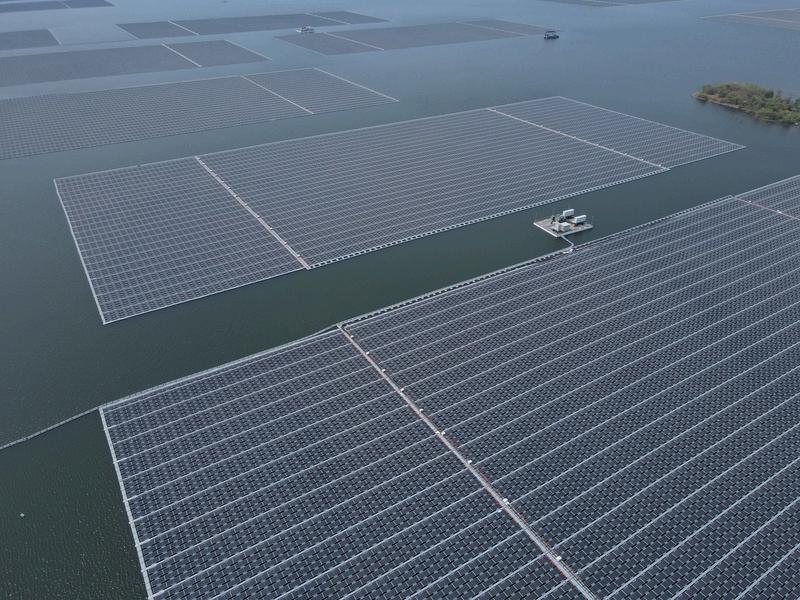
India, with its ambitious renewable energy goals, has set its sights on achieving 500 GW of installed renewable capacity by 2030 Solar energy is central to this strategy, and floating solar projects are emerging as a promising solution Floatex’s installations have been a game changer in this regard, making significant strides toward addressing the country's renewable energy demands while conserving valuable land resources
Major Projects and Collaborations
Floatex has collaborated with key industry leaders and institutions to bring its vision of sustainable solar energy to fruition Some of its major projects include collaborations with organizations such as NTPC, L&T, TATA Power, AMP Energy and Vikram Solar These partnerships have allowed Floatex to scale its operations and contribute to India’s green energy goals effectively
The completion of 600 MW of floating solar installations is a testament to Floatex's expertise and dedication With an additional 400 MW under execution, the company is not only leading the market in India but also positioning itself as a global player in floating solar technology
At the core of Floatex's technology is its innovative floating pontoon system These pontoons provide the structural support for solar panels to float on water while ensuring stability and durability in varying water and weather conditions The floating structures are designed to withstand environmental stresses such as strong winds, waves, and temperature fluctuations, making them ideal for deployment in diverse geographic locations
Floatex's pontoons are not only robust but also cost-effective, enabling scalable installations across large water bodies. The company's use of high-quality materials ensures the longevity and reliability of these systems, making them a preferred choice for large-scale solar projects
While floating solar technology is gaining popularity, it is not without its challenges The complexity of installing and maintaining solar panels on water bodies can be higher than traditional land-based systems Factors such as water depth, local weather conditions, and the potential impact on aquatic ecosystems must be carefully considered. However, Floatex has addressed many of these challenges through innovative design and engineering solutions
The future looks promising for Floatex, as the demand for renewable energy continues to grow The company is well-positioned to expand its reach not only in India but also internationally. With advancements in floating solar technology and increasing government support for renewable energy, Floatex is expected to play a critical role in the global transition to clean energy
By focusing on floating solar pontoons, Floatex addresses the challenges of land scarcity and offers an efficient, eco-friendly alternative to traditional solar farms Floatex is helping to shape the future of renewable energy in India and beyond














“We are witnessing a significant shift in the commercial and industrial sectors, where private entities are showing growing interest in developing green energy portfolios. This heightened demand for renewable energy is driven by a desire for sustainability, cost efficiency, and carbon neutrality. By integrating green power into their operations, the private players are reducing their environmental footprint as well as contributing to a faster energy transition, which had previously been driven primarily by public sector initiatives. This shift is playing a crucial role in shaping a cleaner, more resilient energy future.”


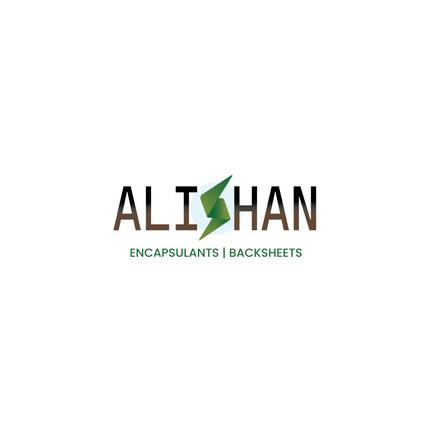
Alishan Green Energy is a leading manufacturer in the renewable energy sector, specializing in high-quality solar encapsulants and backsheets with production capacities of 3 GW each Based in Raipur, India, the company is part of the esteemed Alishan Group and is renowned for its state-of-the-art manufacturing facility, strong technical support, and commitment to environmental sustainability The company's state-of-the-art manufacturing facilities are equipped to handle M10 and G12 modules with widths up to 1305 mm Having acquired the stable customer base, the company has planned to ramp up the encapsulants facility to 4 2 GW by end of this year
The company’s mission is to anticipate and satisfy customer needs by providing high-quality products and managing a smooth supply chain Alishan Green Energy has introduced advanced manufacturing equipment and cutting-edge processes to produce top-tier encapsulants and backsheets for photovoltaic (PV) modules These products are designed to ensure the safety and durability of solar modules, making them a reliable choice in the industry
Alishan EPE encapsulants are co-extruded POE films specially designed to offer benefits of traditional EVA and advanced POE This cost-effective encapsulant is suitable for all types of solar modules, providing benefits such as anti-PID and anti-corrosion Alishan EPE can withstand harsh DH and UV testing as per the latest IEC 62788 standards. In-house testing has confirmed no delamination or yellowing even after extensive UV exposure of 3X65 kWh and 3000h for DH
Anti-PID Performance: By carefully selecting the ratio of EVA to POE, Alishan EPE achieves exceptional anti-PID performance, particularly for glass-glass modules Its inherent volume resistivity is significantly higher than conventional EVA, ensuring minimal degradation in highly PIDsensitive solar cells.
Peel Strength: Alishan EPE offers excellent adhesion with glass and backsheet, overcoming one of the primary bottlenecks of POE The adhesion properties remain robust even after prolonged exposure to damp heat and UV, exceeding standard requirements.
Flexibility: Designed to accommodate thermal expansion and contraction, Alishan EPE reduces the risk of delamination or cracking, maintaining the integrity of the encapsulation layer under varying temperature conditions
Thermal Management: Alishan EPE provides effective thermal management within the module and does not leach out acidic gases, safeguarding backsheets even if they are non-breathable
Alishan POE encapsulants guarantee superior performance and durability, making them ideal for high-efficiency solar modules Despite challenges with lamination and compatibility with existing production processes, POE encapsulants are valued for their exceptional safety features.
Superior Performance: Alishan POE encapsulants maintain the day-one performance of solar modules by being inherently acid-free, ensuring longterm reliability and efficiency
Compatibility: While POE has faced challenges in integration, Alishan's research and innovation efforts have led to improved compatibility with current production processes, making it a more viable option for manufacturers
Reliability: Alishan POE encapsulants provide excellent protection against environmental factors such as moisture, UV radiation, and mechanical stress, enhancing the longevity and performance of solar modules
Market Adaptability: With the increasing demand for n-type technology, Alishan POE encapsulants are positioned to meet the evolving needs of the solar industry, ensuring stability in BOM materials and supply chains.
Alishan EVA and Backsheets: Alishan EVA is a gem in encapsulants category, enjoying the benefits of most trusted and reliable product during the lamination of modules Alishan offers a wide range of backsheets including laminated and coated versions. Alishan is pioneer in development of coated backsheets in India and their CPC-T which is both side coated transparent backsheet is tested for new standards like IEC 62788-2 and IEC 61730 For all product details please visit: www.Alishangreenenergy.com
With the surging demand for high-efficiency modules and warranties exceeding 25 years, the encapsulant market is witnessing a clear shift from conventional EVA to advanced EPE and POE materials Alishan Green Energy recognizes the importance of aligning BOM materials with cell technologies to ensure sustainable growth and develop innovative strategies to counteract degradation mechanisms
At Alishan Green Energy, our emphasis on research and innovation drives the development of cutting-edge encapsulants that meet the highest industry standards. With a robust production capacity of 3 GW for both EPE and POE encapsulants, Alishan is well-positioned to support the growing demand for high-performance solar modules As the industry continues to evolve, Alishan Green Energy remains committed to delivering reliable, innovative, and sustainable solutions that drive the future of solar energy
Innovation, creativity, and technical expertise are at the heart of Alishan Green Energy’s strategy. The company prides itself on its ability to foresee market needs and deliver effective solutions Their dedicated team ensures a seamless experience for customers and suppliers, reinforcing their position as a trusted industry partner
Alishan Green Energy provides exceptional value to its clients through toptier products and innovative solutions Their commitment to sustainability is evident in their focus on environmentally friendly manufacturing practices and the development of products that contribute to a greener future
Alishan Green Energy is a pioneer in the renewable energy industry, known for its high-quality products and commitment to sustainability With their advanced manufacturing processes and innovative solutions, they are wellpositioned to lead the industry toward a more sustainable future, ensuring the safety, durability, and performance of solar modules worldwide.







Founder,MD&CEO
AMPINEnergyTransition
“This is the best time for renewable energy as it has evolved from being an alternative to becoming a central force in driving the global transition towards a more sustainable future. As we embrace this shift, it is crucial to integrate innovation and local manufacturing to meet the energy needs while reducing our carbon footprint and ensuring energy security. At AMPIN Energy Transition, our mission is to empower customers in their journey to becoming 100% renewable energy-powered, by providing end to end clean energy solutions that deliver long-term environmental and economic benefits.”

About Pinaki Bhattacharyya
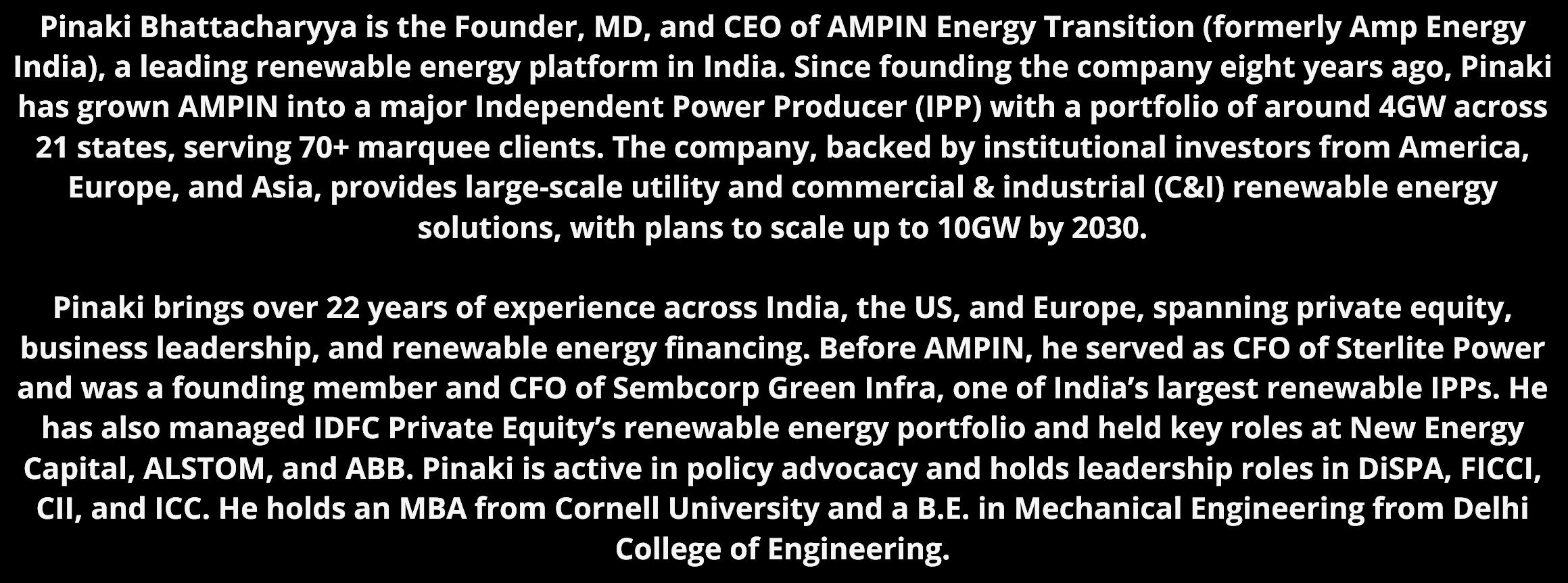

Shiva Enterprises has established itself as a leading force in the Engineering, Procurement, and Construction (EPC) sector, specializing in delivering cutting-edge solutions across multiple domains, including solar power generation and clean drinking water supply With a global footprint and a reputation for excellence, Shiva Enterprises is recognized as a trusted partner in providing innovative infrastructure solutions that cater to the diverse needs of communities and industries worldwide The company has achieved significant growth, with its revenue rising to around INR 250 crore, reflecting its expanding influence and impact in the industry.
Shiva Enterprises started with a mission to harness solar energy to meet global energy demands sustainably Over the years, they've developed a comprehensive service portfolio that includes feasibility studies, design, engineering, procurement, construction, and maintenance of solar projects. Their holistic approach ensures each project meets the highest standards of quality and efficiency Backed by a team of motivated professionals with deep expertise, Shiva Enterprises excels in designing and implementing tailored solar solutions for commercial, industrial, and residential clients
While Shiva Enterprises is firmly rooted in India, the company has successfully extended its expertise to international markets, including the Maldives, Southeast Asia, and both Western and Eastern Africa To enhance project execution in these regions, Shiva Enterprises strategically collaborates with local partners and employs a multi-lingual in-house team to ensure optimal performance. By prioritizing local hiring and leveraging regional expertise, the company can deliver tailored support and achieve successful project outcomes
In India, Shiva Enterprises has successfully implemented a wide array of solar projects across residential, commercial, and industrial sectors Their impressive track record spans over 12 states, with each project designed to meet the specific energy needs of their clients, maximizing both efficiency and cost savings
Some of Key Achievements include:
Installation of 60 MWp of solar rooftop and ground-mounted systems
Deployment of 5,500 solar pumps across various Indian states.
Distribution of 7,500 solar home lighting systems as part of corporate social responsibility (CSR) initiatives
Installation of 2,500 solar street lights to illuminate communities
Drilling and development of 200 tube wells to support local water needs.
Construction of over 80 pumping stations, complete with chlorination rooms
Erection of more than 50 overhead water tanks, with capacities ranging from 50KL to 400KL, and staging heights of 12M-16M
Implementation of an HDPE network pipeline extending over 1,000 kilometers.
Provision of clean drinking water to more than 50,000 households

Shiva Enterprises is dedicated to ensuring the continuous supply of clean and safe drinking water, a vital resource that significantly enhances health outcomes, supports economic development, and improves the overall quality of life. Their comprehensive water supply solutions include borewell drilling and development, using compressed air for dynamic cleansing, and the construction of overhead water tanks for secure storage Additionally, they implement extensive HDPE pipeline networks for efficient water distribution and employ advanced automation and IoT technology to streamline water supply operations.
In response to the growing demand for residential solar solutions, Shiva Enterprises has launched Greams Solar, a new vertical specifically targeting the residential rooftop segment This strategic move reflects a broader trend within the solar energy sector, where companies are increasingly focusing on harnessing solar power for individual homes Greams Solar aims to empower homeowners by providing access to cutting-edge solar technology, enabling them to reduce reliance on traditional energy sources, lower electricity bills, and contribute to environmental sustainability
Looking ahead, Shiva Enterprises envisions a future where they lead the charge in utility-scale solar projects and IoT-integrated water supply solutions By prioritizing meticulous planning, hiring top talent, and employing robust project management frameworks, the company is wellpositioned to meet the growing global demand for renewable energy Through continuous investment in research and development and proactive risk management, Shiva Enterprises remains committed to advancing the renewable energy revolution and expanding their service offerings to meet evolving market needs
Shiva Enterprises stands as a beacon of innovation and excellence in the EPC sector, driving progress in solar energy and clean water supply solutions both in India and across the globe







FounderandCEO
IBSolar
“Leadership is about building a legacy that fuels progress. In solar energy, we don't just power today—we lay the foundation for a sustainable, brighter future for generations to come."
About S.K. Mahajan



Founded with a vision to revolutionize the solar energy sector in India, DhaSh PV Technologies Ltd. has rapidly emerged as a front runner in the global photovoltaic (PV) industry Headquartered in India, DhaSh PV is recognized as the largest integrated manufacturers of PV junction boxes and complete DC solar components, contributing significantly to the country’s renewable energy mission
Uncompromising Quality and Innovation
At DhaSh PV, innovation is at the core of our business. Our state-of-the-art manufacturing facilities, equipped with advanced machinery and strict quality control systems, ensure that each product meets international standards of excellence From robust PV connectors to cutting-edge junction boxes, our products are engineered to deliver superior performance, durability, and safety, ensuring the reliability of solar power systems worldwide
Expanding Footprint: 50GW Manufacturing Capability
With a deep commitment to scaling renewable energy infrastructure, DhaSh PV is in the process of expanding its PV Junction box production capacity to an impressive 50GW per anum This expansion positions us as a key player in supporting India’s vision of becoming a global solar manufacturing hub. Our large-scale operations enable us to cater to the increasing global demand for high-quality solar components while fostering sustainable energy solutions for the future
A Vision for Sustainability
Sustainability is embedded in every aspect of DhaSh PV’s operation We strive to not only meet the needs of today but to lay the foundation for a greener and more sustainable future Through our comprehensive research and development (R&D) initiatives, we continuously explore innovative solutions that enhance energy efficiency and reduce environmental impact, contributing to India’s ambitious renewable energy goals
quality, and sustainability, and they pave the way for even greater accomplishments in the years to come
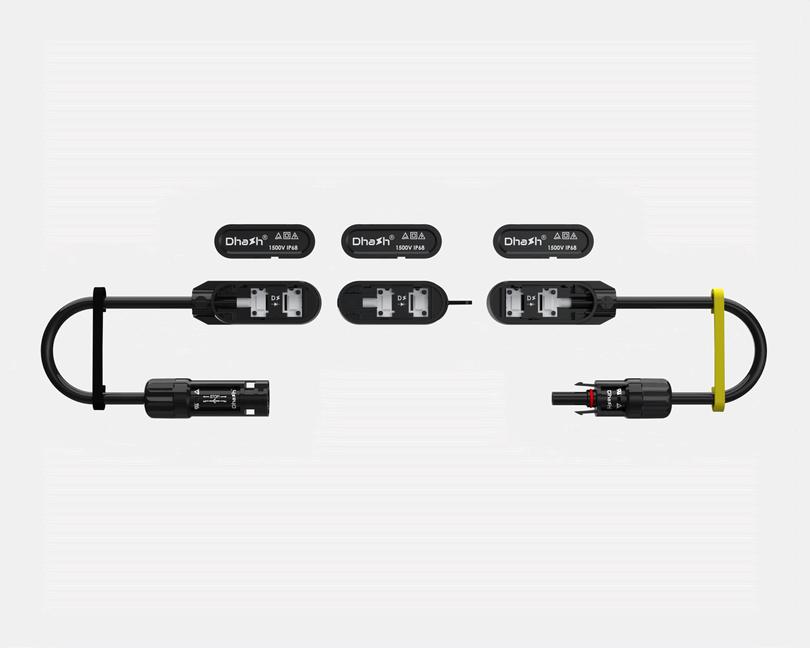
In 2024, DhaSh PV was honored with the Best Renewable Company of the Year under the Dr. APJ Abdul Kalam Inspiration Awards, underscoring our leadership in renewable energy innovation
Top three technological advancements to watch out for from DhaSh PV in 2024 Global Reach, Local Commitment
Though rooted in India, DhaSh PV has a global presence, exporting its world-class solar components to more than 200+ countries Our strategic partnerships with industry leaders worldwide underline our commitment to expanding solar technology and promoting clean energy across the globe
Key Achievements and Milestones
One of the most notable achievements is becoming the world’s largest nonChinese solar PV company, a remarkable feat that speaks to the company’s relentless pursuit of excellence. We have supplied more than 20GW PV Junction box and exporting over 20+ Countries, a testament to the company’s commitment to supporting the nation’s Make in India initiative This achievement not only strengthens India’s manufacturing capabilities but also positions DhaSh as a key player in the global renewable energy landscape These milestones reflect DhaSh’s dedication to innovation,
As DhaSh PV continues to innovate and push the boundaries of solar technology, there are three key technological advancements to watch out for in 2024:
Next-Generation TRIO Junction Box& Connectors:
Building on the success of its flagship product, DhaSh is set to introduce an enhanced version of the TRIO Junction Box integrated with the advanced version of PV Connectors, designed to offer even greater resilience in extreme environmental conditions while improving overall efficiency and longevity. The next generation Trio Junction Box will be designed for a system voltage of 2000V and a rated current of 35A, while the advanced version of the connector will be rated for 2000V & 45A, helping to optimise the LCOE & BOS costs
Advanced Solar DC Cables:
DhaSh is gearing up for further backward integration steps through the onset in manufacturing of e-beam cross-linked xlpo Solar DC cables having low contact resistance, superior conductivity and weatherability properties, which will not only boost the performance of Solar PV systems but also extend their operational life These cables are expected to set new industry standards when it comes to durability and efficiency
Diode Manufacturing in India:
DhaSh is taking a significant step towards self-reliance by catering to the diode manufacturing needs within India This move not only supports the Make in India initiative but also ensures that DhaSh has complete control over the quality and supply chain of critical components, further enhancing the reliability and performance of its Junction Boxes & accessories
These advancements are poised to strengthen DhaSh PV’s position as a leader in the solar industry and offer customers cutting-edge solutions that meet the evolving demands of the renewable energy sector.

India's solar market has made significant strides, reaching a cumulative installed capacity of 87.207 GW by July 2024. This achievement underscores the nation's commitment to renewable energy, as solar power now contributes 58 03% of the total renewable energy capacity This is a substantial portion of the 150 276 GW of renewable energy capacity added to the grid, reflecting the rapid pace at which solar energy is becoming a cornerstone of India's energy landscape.
Over the years, India has emerged as a global leader in solar energy deployment The government's ambitious renewable energy targets, favorable policies, and incentives have driven this growth One of the key factors behind this success is the National Solar Mission, launched in 2010, which set the tone for India's solar journey The mission aimed to establish India as a global leader in solar energy, and the progress made so far indicates that the country is well on its way to achieving this goal
The state-wise distribution of solar capacity highlights the leadership of states like Rajasthan, Gujarat, and Karnataka, which have significantly contributed to the overall capacity Rajasthan, with its vast arid lands, leads the pack, taking advantage of its geographical advantages Gujarat follows closely, with its strong policy support and favorable investment climate for solar power projects Karnataka, known for its innovative approaches to renewable energy, has also played a crucial role in the solar sector's growth.

India's solar market has also witnessed diversification in terms of technology and scale The country has seen a surge in large-scale solar parks, rooftop solar installations, and floating solar projects The development of solar parks, particularly, has been instrumental in aggregating solar capacity in a single location, making it easier for developers to set up projects and for the grid to absorb the power generated

Despite these achievements, challenges remain Land acquisition, grid integration, and financing are some of the hurdles that need to be addressed to sustain the growth momentum. The government's continuous support through policy interventions, such as the Production-Linked Incentive (PLI) scheme for solar manufacturing, is expected to drive further growth and innovation in the sector
India's solar market is poised for continued expansion, with the potential to become a major global player in the renewable energy arena As the country works towards its ambitious target of 500 GW of renewable energy by 2030, solar energy will undoubtedly play a pivotal role in shaping India's clean energy future.

Falling storage costs and advanced technologies boost grid stability and support India's 82GW solar capacity.
Trina Storage's Tier 1 BloombergNEF status highlights its leadership in energy storage and cutting-edge technology
Trina Storage’s flexible storage solutions tackle India's supply chain and safety challenges
What emerging technologies in the solar and energy storage sectors are you most excited about, and how do you see them impacting the Indian market?
We have seen rapid advancements in battery and cell technology, resulting in lower levelized cost of storage (LCOS). Lithium iron phosphate (LFP) batteries are increasingly dominating the lithium-ion battery market due to their superior energy density, longer lifespan, and cost-effectiveness compared with other types of lithium-ion batteries. One major factor is the production of larger prismatic cells for utility-scale energy storage applications, enhancing the available energy storage capacity per unit Standardized shipping containers measuring 20 feet like Trina Storage’s latest Elementa 2 can now attain a capacity of 5MWh and even more, by incorporating larger battery cells of 300Ah or above, marking a 34% rise from the earlier capacity of 3.72MWh achieved with cells around 280Ah This is in line with an industry trend for higher energy density products
In India, the cost of energy storage has significantly declined, with the LCOS dropping to INR 6-7 per kWh in 2023, down from INR 8-9 per kWh in 2022 These technologies can complement India’s 82GW of solar capacity by significantly improving grid stability and ensuring a reliable power supply
We see LFP battery technology moving towards advanced battery management systems (BMS) integrated with AI and machine learning Advanced BMS with AI and ML capabilities enhance the efficiency and
longevity of battery systems by optimizing charge and discharge cycles and predicting maintenance needs, providing a compelling choice for ESS systems
How do you foster a culture of innovation within your team, and what leadership qualities do you believe are essential for driving technological advancements?
At Trinasolar, we foster a culture of innovation through a robust investment in R&D Leadership in our context requires vision, adaptability, and a deep understanding of both technological advancements and market dynamics. Trina Storage started almost a decade ago in 2015-16 We did some small projects, like a commercial and industrial (C&I) project in the Maldives, across 27 different islands, and gained some understanding The company also started own cell technology in R&D and in-house testing facilities very early on
In the last four years, we started to increase our investment in cell manufacturing, eventually mass producing our very own Trina Storage Cell in 2023, because we realised with all the solar being deployed in the world, now is definitely a time for energy storage.
Our recent recognition as a Tier 1 energy storage supplier by Bloomberg New Energy Finance (BNEF) for three consecutive quarters underscores our commitment to excellence. This status reflects our strong financial health, cutting-edge technology, and extensive project portfolio, further solidifying our position as a trusted leader in the energy storage industry
What unique challenges does Trinasolar face in the Indian solar + storage market, and how are you addressing these challenges to stay competitive?
In the Indian market, there is strong interes our Trina Storage Cell Large manufactur companies, for instance those in the tex industry, with their own grid use BESS to of the high cost of electricity at night. They uti their preferred power conversion system (P and integrators So while Trina Storage has capabilities as system integrator, we also off
BESS products at rack and pack level, giving them the options to put the batteries in containers and cabinets themselves
Safety and performance are critical for BESS, so having an in-house developed and manufactured cell enables quality control. It also gives us control over the supply chain, which is increasingly important given the industry uncertainty over lithium battery supply due to the demand from EVs
In India, Trinasolar has an established track record of providing cutting edge high power and high efficiency solar modules due to our ability to manufacture at scale, delivering to the customer a product that meets their needs We bring this same confidence to our customers with our storage products In addition, we are the only player in the industry offering these solutions – modules, tracker and storage – so other benefits include product compatibility, bankability, streamlined logistics, and unified after-sales support
What is your vision for the future of energy storage in India, and how do you see Trinasolar playing a pivotal role in shaping this future?
India's commitment to a sustainable energy future is evident through initiatives like the National Framework for Promoting Energy Storage Systems and the Scheme for Viability Gap Funding, which covers up to 40% of the capital cost for developing 4,000 MWh of BESS by 2030-31. Such strategic efforts complement India’s rapid growth in renewable energy capacity As a global leader in smart PV and energy storage solutions, Trinasolar’s customers can count on our established 27-year track
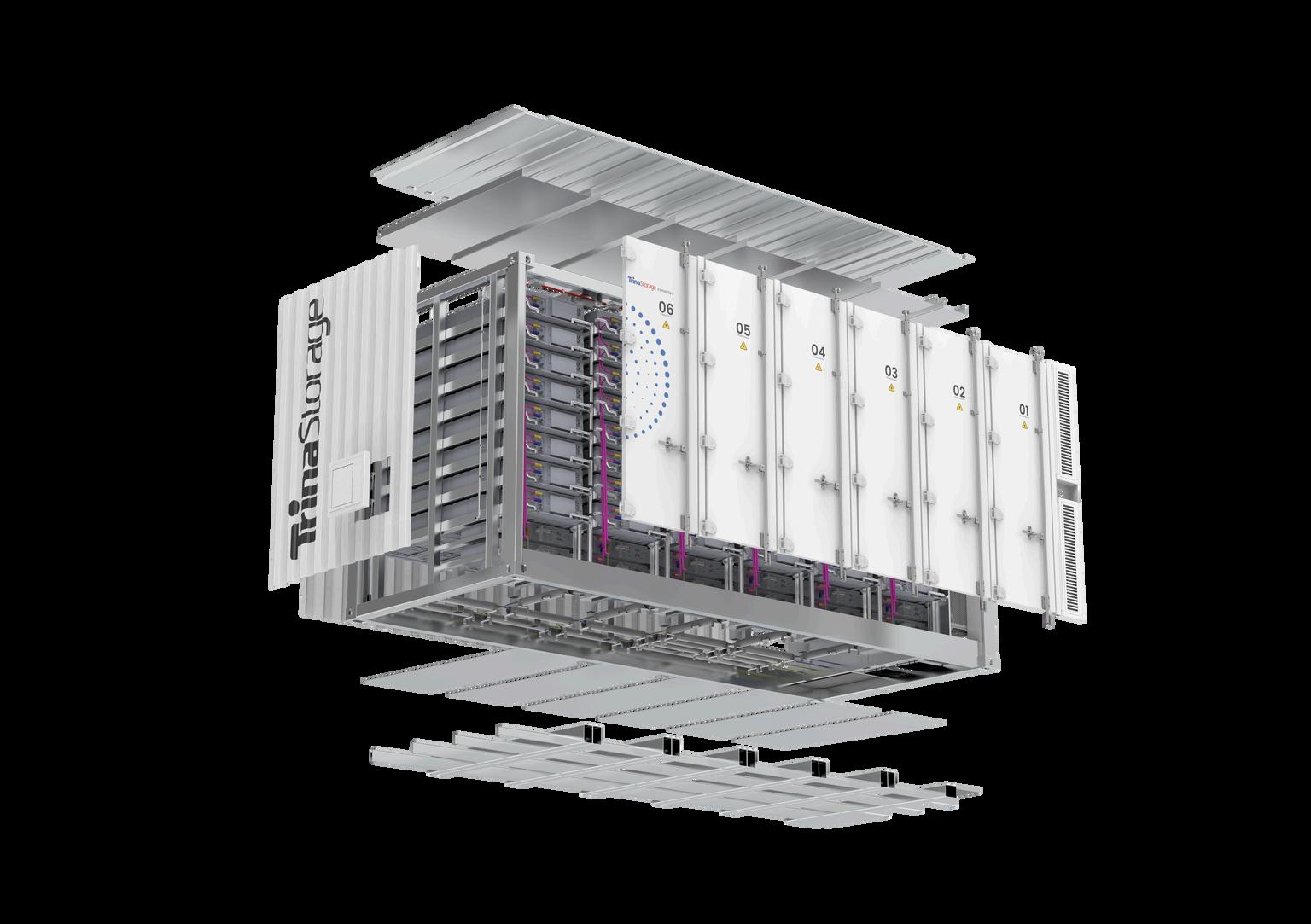

India's solar market is often referred to as a "sunrise sector," reflecting its rapid growth and potential as a key driver of the country’s renewable energy transition With the government’s ambitious targets and favorable policies, solar energy has attracted significant attention from investors, both domestic and international However, while the opportunities are vast, there are also challenges that investors must navigate to achieve successful outcomes in this dynamic market
India’s commitment to expanding its solar capacity is one of the strongest signals for potential investors. The country aims to achieve 280 GW of installed solar capacity by 2030, with solar playing a central role in meeting its climate goals and reducing reliance on fossil fuels This commitment is supported by a range of government initiatives, including the National Solar Mission, which offers incentives, subsidies, and regulatory support for solar projects For investors, this policy framework provides a relatively stable and predictable environment, making solar a viable long-term investment
One of the most attractive aspects of investing in India’s solar market is the declining cost of solar power Technological advancements, economies of scale, and competitive bidding processes have driven down the cost of solar energy to the point where it is now cheaper than coal-based power in many regions This cost advantage makes solar projects more financially viable and enhances their appeal to investors looking for sustainable and profitable ventures. As the cost of solar panels and other components continues to fall, the return on investment for solar projects is expected to improve further
Another promising area for investment is the expansion of solar energy infrastructure, particularly in rural and underserved areas India’s vast and diverse geography means that millions of people still lack access to reliable electricity This presents a significant opportunity for investors to fund decentralized solar solutions such as microgrids and solar home systems These projects not only provide essential services to rural communities but also offer attractive returns, especially when supported by government schemes aimed at promoting rural electrification.
Despite the positive outlook, investors in India’s solar market must also be aware of the challenges that could impact their returns One of the key challenges is the availability and cost of financing While the sector has attracted considerable interest, securing affordable and long-term financing remains a hurdle, particularly for smaller players High-interest rates and stringent lending conditions can increase the overall cost of solar projects, affecting their profitability Moreover, the long payback periods associated with solar investments may deter some investors, especially in a market where policy and regulatory changes can introduce uncertainty
Land acquisition is another significant challenge in India’s solar market. Large-scale solar projects require vast tracts of land, and acquiring suitable land at reasonable prices can be difficult. Land disputes, regulatory delays, and resistance from local communities can slow down project development and increase costs Investors need to be aware of these risks and factor them into their project planning and financial projections




Sungrow has integrated Si-C devices and AI-based safety features into their inverters, along with AC and DC coupled BESS solutions
Their utility-scale inverters operate efficiently at high temperatures (up to 51°C) and adapt to various grid conditions
Sungrow's central inverters support DC coupled BESS for higher efficiency, with goals to innovate for India's carbon reduction targets and future grid needs
What recent innovations in solar inverter technology is Sungrow excited about for the Indian market?
Since its inception, Sungrow has been the forerunner implementing new technologies
As the versatility of wide band gap devices is gaining acceptance across power electronic devices, Sungrow has implemented the use of Si-C devices in the inverters to offer features like higher power density, better thermal characteristics and higher efficiency.
As Fixed Dispatchable RE power tenders are becoming prevalent, we are coming up with AC and DC coupled BESS solutions
Sungrow inverters are certified to operate in weak grid, which aids the process of RE adoption in the far-flung areas with limited access to quality grid
We have added a combination of hardware and AI based approaches towards diagnosis and protection as an additional safety layer
Sungrow has also incorporated design improvements to ease the O&M for both string and central inverters
How does Sungrow adapt its solar inverters to the unique climatic and grid conditions in India?
The Summer season this year has been particularly harsh on the Indian geography This includes high ambient temperatures exceeding 50°C and a consistent and sustained increase in the peak electricity demand, which put additional stress on the Indian grid
Sungrow’s utility scale inverters come with nameplate power ratings at 51°C This allows for inverters to maintain the rated power capability at higher ambient conditions and support the grid dispatch efficiently.
Sungrow Inverters with DC coupling allow to provide output power during different times of the day, easing the load on grid while saving on the AC side BoS.
Sungrow inverters adapt well to different grid conditions which allows for connecting inverters in different locations
What technical challenges does Sungrow face in the Indian solar market, and what solutions have been implemented?
As the population of Inverter Based resources increases, the inverters are required to support the grid in terms of power quality and other dynamic supports Sungrow is continuously improving its inverters to cater to these requirements.
Adoption of higher Watt-peak solar modules has picked up pace Sungrow has released new generation inverters to suit the new requirements.
Sungrow has made many protection features like AFCI, Type I+II SPD as a standard in C&I inverters to install solar plants on critical infrastructure.

How is Sungrow integrating solar inverters with energy storage to improve efficiency and reliability in India?
Sungrow has devised strategies towards energy storage integration with Solar PV plants.
Sungrow has developed PCS in lines of the existing utility scale Central inverters (1+X series) to share the spares inventory up to 90% of common components
Sungrow Central inverters can support DC coupled BESS, which results in higher round trip efficiency while increasing the PV plant capacity utilization
What are Sungrow's long-term goals for the Indian market, and how do you see solar inverters evolving over the next decade?
Sungrow is very optimistic about the growth of the Indian RE market It is our endeavor to keep innovating and provide the best power conversion equipment to India in line with India's targets to reduce carbon emissions
In the coming decade, with the growth of electricity demand, we may see a trend towards de-centralization of the grid The solar inverters are poised to gain features like grid forming capabilities, higher DC input voltages, smart grid adaptation, direct MV integration, etc.



The Union Budget 2024 has been well-received across the energy sector, reflecting a strong commitment to advancing India’s energy security and sustainability goals The government’s focus on energy security as one of its top priorities aims to build a solid foundation for a developed India by 2047 Significant measures include the expansion of exemptions for capital goods used in domestic solar cell and panel manufacturing, which will support the goal of achieving 280 GW of solar power by 2030 Additionally, the proposed policy framework for pumped storage projects is expected to enhance the integration of renewable energy and ensure round-the-clock electricity availability.
The budget also introduces a taxonomy for climate finance, which will provide clarity on financing renewable energy programs and support climate adaptation projects This is seen as a crucial step toward addressing the challenges of climate change and energy security, particularly for rural communities. The emphasis on integrating AI-enabled Virtual Power Plants to manage decentralized energy resources is also highlighted as a key component for achieving India’s net-zero targets by 2070
Another notable aspect of the budget is the substantial subsidy allocated for homeowners adopting solar energy This initiative, along with other incentives, aims to facilitate a swift transition to solar power and supports the broader goal of reaching 500 GW of renewable power by 2030 The budget also addresses the need for improved grid infrastructure to support the growing solar sector and ensure efficient distribution of renewable energy.
The expansion of the list of exempted capital goods for solar equipment manufacturing and the removal of customs duties on critical minerals are set to boost the domestic solar industry and promote advancements in battery storage The focus on energy efficiency investments for micro and small enterprises is expected to enhance their competitiveness and support the transition to greener technologies.
Overall, the budget’s strategic focus on renewable energy, climate finance, and infrastructure development underscores the government’s commitment to fostering a sustainable energy future for India These initiatives are anticipated to drive significant progress in achieving India’s climate goals and enhancing energy security across the country.


Nextracker's NX Horizon-XTR™ and AgriPV solutions are tailored to optmise land usage requirementsforsolarprojectsinIndia
Nextracker’s Center for Solar Excellence advances R&D and testing, driving innovation and reliability in India’s renewable energysector.
With 95% locally manufactured components, Nextracker provides enhanced supply chain reliability and reduced lead times for customers
How has Nextracker’s solar tracker tech evolved, and what recent innovations set it apart?
Nextracker’s journey in solar tracker technology has been one of continuous evolution, always with a focus on making utility-scale solar power generation lower cost and highly reliable for our customers Over the years, we’ve incorporated EPC and developer customer feedback to help continually improve our product cycles and new innovations. Some of these innovations include:
Our NX Horizon™ smart solar tracker platform is the world’s most deployed solar tracker, now installed on over 100 gigawatts in over 40 countries, delivering best-in-class performance, reliability, and the lowest levelized cost of energy (LCOE).
The NX Horizon-XTR terrain-following tracker breaks the paradigm of “straightline row” design constraints by conforming to natural terrain This generates multiple benefits such as eliminating cut and fill earthworks, reducing pier lengths, and easing permitting, ultimately accelerating project construction schedules and saving time and money The latest version, XTR1 5, doubles XTR’s ability to conform to sloping terrain, further expanding opportunities for solar development on challenging sites
VP & MD
TrueCapture™ is an adaptive energy optimization software that helps utility-scale solar power plants improve yield by up to 4% by adjusting the tracking algorithm of each individual row in response to site features and changing weather conditions Its smart algorithm adjusts the tilt angle of each tracker row in the array to avoid any loss due to diffused lighting or shading.
In conclusion, Nextracker solutionsdeliver greater flexibility to reliably configure systems on project sites for premium performance and maximum energy output across a broad range of site, soil, and weather conditions
How does Nextracker enhance solar efficiency across various climates and terrains?
Solar trackers play an integral role in bolstering PV system resilience in the face of wind and other extreme weather conditions We continue to invest in and develop key product differentiators that provide stability in the wake of extreme climate events Our balanced, rapidmoving architecture allows us to “out-run” rapidly forming thunderstorms, and our engineered lock bolt fasteners are vibrationproof, skipping costly and labour-intensive requirements to re-torque thousands of nuts and bolts on an annual basis further reducing the operations and maintenance of a given plant
Nextracker’s NX Horizon-XTR™, conforms to the natural terrain, minimizing extensive earthworks, reducing steel pile lengths, and minimizing soil disturbance, ensuring environmental sustainability and costeffectiveness. This innovation significantly accelerates project construction, essential for the region’s growing energy demands
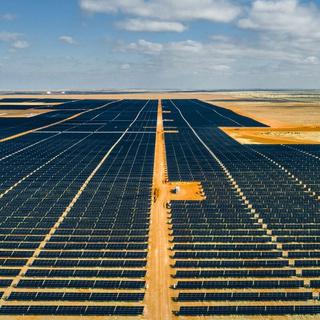
How has Nextracker’s tech impacted solar project costs and performance in India?
Projects utilizing solar trackers can achieve a 20%-30% higher energy output when paired with bifacial solar modules By collaborating with the world’s leading module manufacturers, we make sure we test, and then test again Nextracker’s focus on innovation and technological advancements with our supply and technical OEM partners positions it well to support the rapid growth of solar energy in India.
We are expanding our partnerships with local manufacturers to ensure lower costs and minimize logistics impact by locating component production near project sites. We make 95% of our tracker components domestically for utilityscale power generation projects
What is Nextracker showcasing at REI Expo, and how does it align with their solar energy vision?
At REI 2024, we’re showcasing several innovations, pushing the technology envelope:
Terrain-following tracker: NX Horizon-XTR™ is designed for projects with challenging terrains, adapting to land contours, reducing environmental impact, and lowering costs for developers
Agrivoltaics: Our AgriPV solutions highlight the growing developer and landowner demand for dual-use, integrating solar with cash crop agriculture all while generating clean energy and generating additional income
R&D and testing: We are excited to talk to our customers about the Nextracker Center for Solar Excellence, a new R&D and testing hub in Hyderabad This center will spearhead advanced research and testing to enhance the functionality, reliability, and integration of components for bringing in new features and improved performance of our solar projects.
Drawing from our installations in Khavda, we've developed deep expertise in designing resilient tracker systems specifically tailored to withstand the region's corrosive soil conditions.

SVG technology enhances voltage stability, reduces losses, and improves power quality in APAC and MENA grids
TBEA leverages global experience to integrate SVGs into existing infrastructure, providing tailored solutions that meet regional grid codes
TBEA focuses on high-capacity inverters, modular designs, and compliance with global standards to support renewable energy growth in these regions
Can you explain the role and importance of Static VAR Generator (SVG) technology in modern power grids, particularly in the context of the APAC and MENA regions?
Certainly The TBEA SVG solution represents the most advanced power quality and reactive power compensation technology available today As an IGBT-based, thirdgeneration reactive power solution, it offers numerous advantages, including enhanced reactive power capability, faster response times, and low harmonic distortion.
Voltage Stabilization and Grid Efficiency:
SVGs excel at stabilizing power grid voltage, reducing system losses, increasing transmission capacity, and enhancing the transient voltage limit of the grid
Rapid Response:
They offer faster response times compared to traditional solutions, ensuring timely compensation for reactive power fluctuations.
- India TBEA
Harmonic Suppression:
SVGs have robust harmonic suppression capabilities, improving overall power quality.
Wide Operating Voltage Range: his feature contributes to grid stability by accommodating a broad spectrum of voltage conditions.
Low Power Losses:
SVGs are designed to operate efficiently, minimizing power losses during operation
Power Quality Improvement: SVG offer harmonics & flicker suppression features that significantly enhance power quality
Voltage Support during Transients: SVGs provide critical voltage support during grid transient conditions like Low Voltage Ride Through (LVRT) and High Voltage Ride Through (HVRT), aiding in grid stability
Dedicated Reactive Power Resource: By reducing the reactive load on inverters and wind turbine generators (WTGs), SVGs help extend the lifespan of these equipment
Adaptability to Harsh Environments:
As an SVG manufacturer, TBEA offers water-cooled solutions capable of operating at rated power in ambient temperatures up to 55°C
Flicker Suppression: They also provide options for flicker suppression enhancing power quality
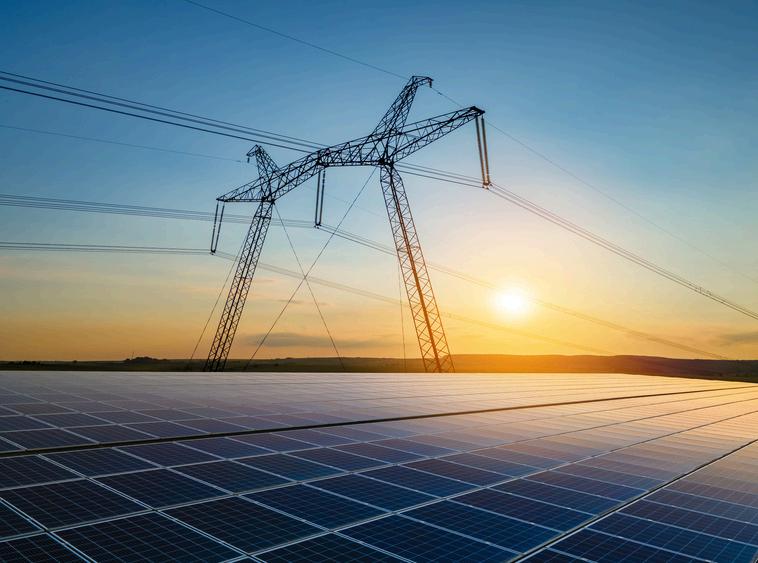
The integration of SVG technology into existing power infrastructure presents a unique opportunity to elevate grid performance, leveraging TBEA’s expertise to overcome potential challenges and optimize renewable energy integration.”
What are the specific challenges and opportunities associated with integrating SVG technology into the existing power infrastructure in these regions?
In fact, there are no significant challenges hindering the installation of SVGs in existing plants TBEA leverages its extensive expertise in SVG technology, with over 50 GVAr installations worldwide. Our experience enables us to overcome challenges related to grid stability We actively educate solar and wind developers, as well as grid authorities, about the benefits of implementing SVGs in renewable energy plants. Our product designs are tailored to meet or exceed grid code requirements TBEA's proactive approach, based on rich global experience, assists solar project developers in completing projects on time while maintaining highquality standards We offer training facilities for site teams and have a well-diversified service network Additionally, we provide a complete range of products suitable for the utility-scale market.
What advancements in solar PV inverter technology are you currently focusing on to address the unique energy needs of the APAC and MENA regions?
We are concentrating on several key areas:
Higher Capacity Inverters:
Developing the largest capacity string and central inverters to reduce overall Balance of System (BOS) costs
Modular and Reliable Products:
Focusing on modular, redundant designs for enhanced reliability
Compatibility with High-Capacity PV Modules:
Upgrading fuse and switchgear sizes to match larger block sizes in high-capacity PV modules
Universal Product Development:
Ensuring compliance with the latest global grid code requirements, including LVRT, HVRT, FRT, and ZVRT for transient conditions
Testing in Low SCR Ratios:
Ensuring inverter compatibility with weak grid conditions by testing in low Short Circuit Ratio (SCR) scenarios
Enhanced Thermal Handling:
Our inverters have a maximum temperature limit of 62°C, which is higher than the industry standard, indicating better thermal stability
Level IV Certification:
Achieving Level IV certification for string inverters, placing us among the few to have passed this rigorous standard
Use of Tier 1 Components:
Utilizing top-quality components like Infineon IGBTs in the main conversion circuits of our inverters
Optimized Auxiliary Consumption:
Reducing losses through optimized auxiliary power consumption
Plug-and-Play Solutions:
Providing easy installation with reduced construction costs and a smaller footprint.
Superior Fault Current Rating:
Our ACBs have better Ics and Icu ratings than other central inverters on the market, enhancing safety and protection
Robust Component Sizing:
Ensuring stable and reliable operation by allowing higher current and voltage margins in IGBTs, reducing stress and extending lifespan
Support for Higher DC/AC Ratios:
Accommodating higher DC to AC ratios for improved efficiency
What are the key factors driving the adoption of SVG technology in the renewable energy sector, and how is TBEA positioning itself to meet the growing demand?
Several factors are driving SVG adoption:
Dynamic Compensation Ability: TBEA's SVGs can deliver up to 110% of their rated reactive power capacity
Redundant Design:
Ensuring uninterrupted operation and reliability
Real-Time Monitoring:
Individual IGBT temperature monitoring facilitates effective operation and maintenance.
Reduced Electromagnetic Interference:
Optical coupling isolated driving techniques minimize network interference
Environmental Adaptability:
IP55 design enhances adaptability to various environmental conditions
Temperature Control:
Closed-loop temperature control ensures optimal system performance and reduces auxiliary consumption
Frequency Modulation Technique: Controls harmonic output, reduces IGBT switching frequency, and lowers power losses
Faster Response Time:
Less than 5 milliseconds, providing immediate reactive power compensation
Compliance with Market Requirements: Products are tested and compliant with new market guidelines and requirements
TBEA is positioning itself by continuously innovating and updating our products to meet these demands Our global experience and comprehensive product range enable us to support the renewable energy sector effectively
What innovations or developments in SVG and solar PV inverter technologies do you foresee, and how is TBEA preparing to stay ahead in this rapidly evolving market?
We anticipate several key developments:
Continuous Product Development:
Advancing product features and technologies in line with market and grid agency requirements.
Utility-Scale Solutions:
Offering a complete range of products suitable for utility-scale markets
Regulatory Compliance:
Maintaining ongoing interactions with grid agencies and government operators to meet grid requirements and update product certifications
Long-Term Reliability:
Designing redundant and reliable products with a 25-year life span.
Adoption of Latest Technologies:
Integrating the most recent technological advancements available in the market
High-Capacity Products:
Providing the highest capacity SVGs and inverters to help customers reduce BOS costs
Strong Service Network:
Developing a robust service network across regions and ensuring spare parts availability for 25 years
Advanced Grid Studies Support:
Supplying PSSE/PSCAD models for grid studies, along with bench marking reports and timely updates as needed.
Advanced Testing Platforms:
Utilizing cutting-edge testing facilities to produce high-quality products and ensure customer trust.
By focusing on these areas, TBEA is wellprepared to remain at the forefront of technological advancements in SVG and solar PV inverter technologies, meeting the evolving needs of the market
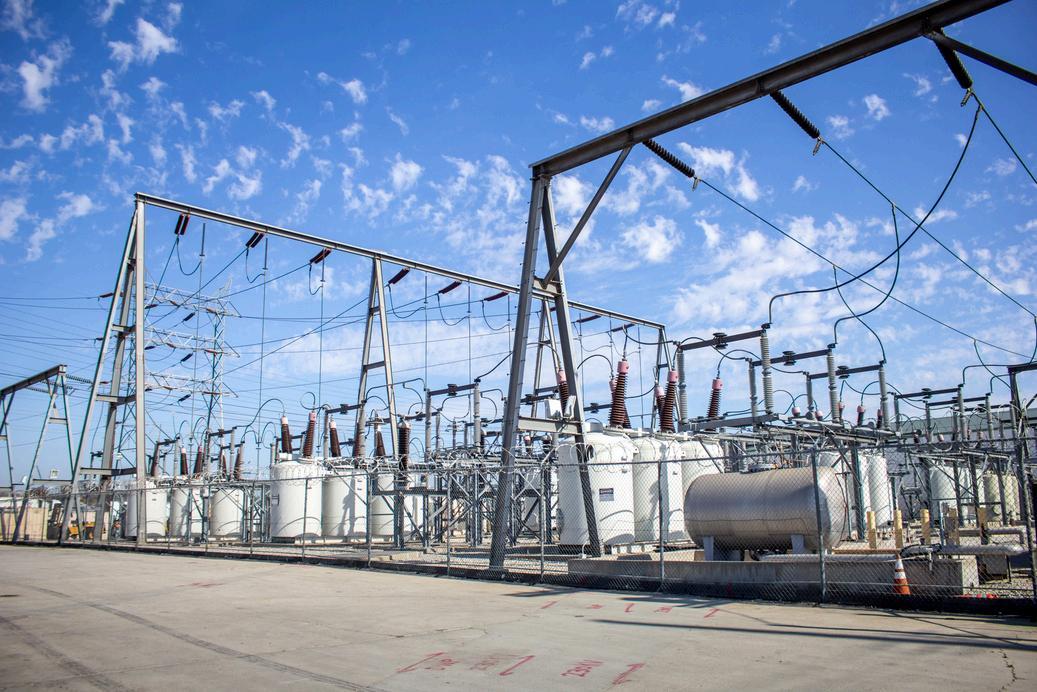

Huasun’s zero busbar (0BB) heterojunction (HJT) modules enhance solar efficiency by eliminating busbars, reducing shading losses, and lowering production costs
The Everest G12R Series modules, with a maximum power output of 640W, are ideal for utility-scale and commercial solar projects, offering higher efficiency and reduced Balance of System (BOS) costs
With 20GW of HJT production capacity, Huasun is well-positioned to meet the growing global demand for highefficiency solar modules, particularly from major enterprises and international investors
Can you provide an overview of Huasun’s latest innovation, the zero busbar (0BB) heterojunction (HJT) modules? What makes this technology a game-changer in the solar industry?
Huasun’s latest innovation, the zero busbar (0BB) heterojunction (HJT) modules, represents a significant advancement in solar technology Unlike traditional HJT modules that use multiple busbars, the 0BB design eliminates these busbars entirely. This innovation enhances the efficiency of the modules by reducing shading losses, increasing the light-absorbing area and improving the overall cell performance The 0BB technology also contributes to lower production costs due to reduced material usage and simpler manufacturing processes This makes the technology a game-changer as it not only improves module efficiency and performance but also drives down costs, making high-efficiency solar power more accessible
Director South Asia
Huasun Energy
As Huasun continues to lead in HJT mass production, how has the integration of 0BB technology enhanced the market competitiveness of your products, particularly in terms of reliability and lower LCOE?
The integration of 0BB technology has significantly enhanced the market competitiveness of Huasun’s products by addressing key factors such as efficiency, reliability, and cost-effectiveness The absence of busbars reduces shading losses and improves energy conversion efficiency, leading to higher power output per module This increased efficiency contributes to a lower Levelized Cost of Electricity (LCOE) as more energy is produced at a lower cost Additionally, the 0BB technology improves reliability by reducing the risk of hot spots and other possible cause areas associated with traditional busbar designs Overall, these advancements position Huasun’s products as highly competitive in the market, offering superior performance and cost advantages.
Huasun is consistently recognized as a Tier I solar manufacturer. How does this status influence your approach to innovation, production quality, and market trust?
We are proud to be in the BNEF Tier I listing consistently as it demonstrates the trust and faith our customers have shown in us and we assure all our stakeholders to continue putting strong efforts in the R&D initiatives to bring innovation to the forefront, improve production quality as well as bring down the costs in the process Tier I status not only enables Huasun to be eligible for various bids / tenders but also helps in building confidence amongst the project developers, lenders, investors and other stakeholders This status drives the company to always maintain very high standards in each and
every aspect of its operations This focus on quality and innovation builds market trust, reinforcing Huasun’s reputation as a reliable and leading solar manufacturer It also motivates the company to continue pushing the boundaries of solar technology to deliver superior products.
Huasun has achieved significant efficiency milestones with the Himalaya and Everest G12 Series HJT modules. Could you share more details about the technological improvements that have led to champion efficiencies of 26.5% and 26.41%, in mass production, respectively?
The significant efficiency milestones achieved with the Himalaya and Everest G12 Series HJT modules are the result of several technological improvements:
Advanced Cell Design: Innovations in cell design, including the integration of 0BB technology and optimized cell structure, have contributed to higher efficiency.
Enhanced Light Absorption: Improved light absorption techniques and the use of high-quality materials help capture and convert more sunlight into electricity.
Reduced Losses: Minimization of electrical losses through advanced contact and interconnection technologies enhances overall cell performance.
Precision Manufacturing: Enhanced manufacturing processes, such as twostep single printing (SP) technology, ensure higher accuracy and better cell performance
These advancements have enabled Huasun to achieve champion efficiencies of 26 5% for the Himalaya series and 26.41% for the Everest G12 series, setting new standards in the solar industry
Could you elaborate on the specific manufacturing processes, such as welding before lamination and twostep single printing (SP) technology, used in the production of 0BB cells? How do these processes ensure superior product quality and performance?
In the production of 0BB cells, Huasun employs several advanced manufacturing processes:
Welding Before Lamination:
This process involves welding the cells before they are laminated, which helps in achieving a more uniform and reliable connection between cells This method reduces the risk of defects and enhances the overall durability of the module
Two-Step Single Printing (SP) Technology:
This technique involves printing the cell’s front and back contacts in two separate steps, which allows for more precise control over the cell’s electrical properties The improved accuracy in printing contributes to higher efficiency and better performance of the modules
These processes ensure superior product quality by minimizing defects, enhancing cell performance, and improving the overall reliability and longevity of the modules.
With the introduction of the Everest G12R Series modules, what key benefits do these rectangular cells offer over traditional square wafers, and how do they enhance the overall performance of photovoltaic projects?
The Everest G12R Series modules offer several key benefits over traditional square wafers:
Higher Power Output:
The larger rectangular wafers allow for increased power output per module, which can significantly enhance the overall energy production of a photovoltaic system.
Reduced Module Count:
The higher power output means fewer modules are needed to achieve the same energy production, leading to lower installation and material costs.

With fewer modules required, Balance of System (BOS) costs, such as mounting structures and wiring, are reduced.
Enhanced Performance: The rectangular design and advanced technology of the Everest G12R Series contribute to better efficiency and performance, optimizing the overall performance of photovoltaic projects
The Everest G12R modules boast a maximum power output of 640W, surpassing other rectangular modules by 20W. What specific applications and scenarios are these modules best suited for, and how do they contribute to reducing Balance of System (BOS) costs and LCOE?
The Everest G12R module, is also a very special product in the Huasun’s product portfolio, with their maximum power output reaching upto 640W however maintaining the smaller dimensions, these modules are well-suited for almost all types of solar installations where high power density is crucial These modules are ideal for utility-scale solar farms, commercial solar installations as well as large residential systems Currently all project developers who had anticipated their projects with 540/580w modules can take advantage of our G12R Everest modules and increase 40-60w additional output per panel and almost negligible change in the structure designs By providing higher power output per module, the Everest G12R series reduces the number of modules needed for a given project size This reduction in the number of modules lowers Balance of System (BOS) costs, including costs for mounting, wiring and inverters. Additionally, the increased efficiency and power output contribute to a lower Levelized Cost of Electricity (LCOE) by maximizing energy production and minimizing installation and operational costs.
With 20GW of HJT production capacity, how does Huasun plan to meet the anticipated surge in global demand for HJT modules, especially from Chinese state-owned enterprises, international investors, and project developers?
To meet the anticipated surge in global demand for HJT modules, Huasun has been strategically expanding its production capacity since establishment The company has scaled up its HJT production to 20GW with four manufacturing bases being established in Xuancheng, Hefei, Wuxi and Dali in China As the world’s largest HJT manufacturer, Huasun is in full swing to meet the increasing demand from various market segments, including Chinese state-owned enterprises, international investors and project developers By investing in advanced manufacturing facilities and technology, Huasun aims to ensure a steady supply of high-quality HJT modules to support global solar projects and maintain its competitive edge in the market
With a robust 20GW HJT production capacity and strategic manufacturing bases, Huasun is fully equipped to meet the growing global demand, particularly from key players across the globe.

India's solar market is experiencing a significant transformation with evolving solar policies aimed at enhancing business opportunities and driving growth in the renewable energy sector Recent developments in solar policies reflect a focus on improving the business environment, boosting investments, and addressing various challenges that have emerged as the sector expands
One of the most notable policies is the revised National Solar Mission framework, which outlines ambitious targets and provides clear guidelines for implementation. The updated framework emphasizes increasing solar capacity by setting a target of 500 GW of renewable energy capacity by 2030, with a significant share allocated to solar energy This policy aims to create a robust market for solar power by setting long-term goals and offering incentives for achieving these targets
Additionally, the Government of India has introduced several state-specific policies to support solar growth For instance, states like Gujarat, Maharashtra, and Rajasthan have implemented their own solar policies, providing tailored incentives and support to attract solar developers These policies often include subsidies, tax benefits, and streamlined approval processes to make it easier for businesses to invest in solar projects
The introduction of the PM-KUSUM scheme is another key policy aimed at promoting solar power in the agricultural sector This scheme provides financial assistance to farmers for installing solar panels on their land, helping them generate electricity for their own use and sell any excess power to the grid By supporting farmers, the scheme not only increases solar power capacity but also provides an additional source of income for the agricultural community
The government has also focused on enhancing the regulatory framework to facilitate solar installations Recent updates include measures to simplify the process of obtaining permits and approvals for solar projects. This includes reducing bureaucratic hurdles, streamlining documentation requirements, and implementing online platforms for faster processing of applications These improvements aim to reduce the time and cost associated with setting up solar projects, making it more attractive for businesses to invest in solar energy.
Furthermore, the introduction of net metering regulations has been a significant step in supporting solar adoption. Net metering allows solar power generators to sell excess electricity back to the grid, providing
an additional revenue stream for businesses and individuals who invest in solar panels This policy has been adopted by various states, with each implementing its own net metering guidelines to suit local needs and conditions
In addition to these policies, the government has also introduced tax benefits and incentives for solar investments For example, businesses investing in solar projects can benefit from accelerated depreciation on solar assets, which allows them to recover their investment more quickly This financial incentive encourages companies to invest in solar technology and helps them achieve long-term savings on energy costs.
The evolving solar policies are not only aimed at increasing solar capacity but also at ensuring that the benefits of solar power are widely distributed By providing support to different sectors, including agriculture and industry, and implementing measures to simplify the regulatory process, these policies are designed to create a more inclusive and sustainable solar market
The impact of these policies on the solar industry has been significant Businesses are now more confident in investing in solar projects, knowing that there are clear guidelines and financial incentives to support their efforts The improved regulatory framework and financial incentives have led to increased investments in solar technology, resulting in a growing number of solar installations across the country.
Moreover, the focus on state-specific policies and tailored support has allowed for a more localized approach to solar development This has enabled states to address their unique energy needs and harness the potential of solar power in a way that aligns with their specific goals and conditions
Overall, the evolving solar policies in India represent a positive shift towards a more business-friendly and supportive environment for solar energy development By setting ambitious targets, providing financial incentives, and simplifying regulatory processes, these policies are driving growth in the solar sector and contributing to India's broader renewable energy goals. As the solar market continues to expand, these policy improvements will play a crucial role in shaping the future of solar energy in India



The solar PV inverter market in India is focusing on improving efficiency and reliability, with a growing trend towards local manufacturing to reduce dependence on imports.
Sineng Electric adapts to regulatory changes by integrating advanced features and technologies, ensuring their products meet evolving market demands
Sineng differentiates its inverters through innovative cooling technologies, lower LCOE, and rigorous testing to ensure high performance and reliability
Could you provide an overview of the current trends and challenges within the solar PV inverter market, specifically focusing on India?
The solar PV inverter market in India is dynamic and evolving, with a clear trend toward advanced and efficient solutions However, manufacturers and stakeholders must navigate regulatory complexities and technical challenges to capitalize on the growth opportunities in this market
Focus on Efficiency and Reliability:
Inverter manufacturers are continuously working on improving the efficiency and reliability of inverters High-efficiency models with lower power losses are in demand to maximize energy output from solar installations
Quality and Reliability: Ensuring the quality and reliability of inverters in India’s diverse and often harsh climatic conditions is a challenge Manufacturers need to invest in robust design and testing.
Local Manufacturing: There is a growing trend towards local manufacturing of solar PV inverters to reduce dependence on imports, lower costs, and comply with government policies promoting local content
Head - Product Application - North India Sineng Electric (India) Pvt. Ltd.
Regulatory Compliance and Certification:
Compliance with the latest Central Electricity Authority (CEA) guidelines and other regional standards is becoming increasingly important. Certifications ensure product reliability and safety, which are critical for large-scale solar projects
Integrating large amounts of solar power into the grid poses challenges such as voltage fluctuations, grid stability, and frequency control Inverters must comply with grid codes and support functions like Low Voltage Ride Through (LVRT) and High Voltage Ride Through (HVRT).
What strategies has Sineng Electric adopted to navigate regulatory changes and market dynamics in the Indian solar sector?
Sineng’s team closely monitors changes in Indian energy policies and standards, ensuring that all our products comply with the latest guidelines issued by CEA and MNRE.
Weintegrate advanced features into inverters, such as multiple maximum power point trackers (MPPTs), high-efficiency designs, and robust grid-support functionalities like LVRT and HVRT. These features enhance the performance and reliability of our inverters under varying grid conditions Additionally, Sineng Electric invests heavily in research and development to stay ahead of technological advancements. By continuously innovating and expanding our product offerings, we ensure that we can meet future market demands and regulatory requirements effectively
How does Sineng Electric differentiate its solar PV inverters from competitors in terms of technology and performance?
Sineng Electric differentiates its solar PV inverters from competitors through the integration of advanced technologies Our inverters are engineered to deliver high efficiency, maximizing energy conversion and reducing losses This is achieved through advanced innovative design We employ
advanced cooling technologies such as the twophase heat dissipation method and forced air cooling to ensure optimal thermal management with no derating till 51°C. Our R&D team has designed inverters to achieve lower LCOE These inverters are compatible with various PV module technologies and are tested and proven using top-tier components
How is the adoption of string inverters versus central inverters progressing in the Indian market, and what is Sineng Electric doing to support this trend?
Sineng Electric offers a comprehensive range of both string and central inverters to cater to different market segments and project sizes This includes high-efficiency models designed to meet the specific needs of the Indian market Central inverters remain the preferred choice for large-scale utility projects due to their costeffectiveness in high-capacity installations and system design Sineng Electric's string inverters come with advanced features like multiple MPPTs, higher efficiency, and robust grid support functionalities. We integrate smart technologies into inverters, providing advanced monitoring, control, and communication that enhance system performance and ease of maintenance
How does innovation drive Sineng Electric’s product development strategy in India, particularly in enhancing efficiency and reliability?
Innovation is central to Sineng Electric’s product development strategy in India, driving enhancements in efficiency and reliability By leveraging advanced technologies, rigorous testing, and a customer-centric approach, Sineng Electric ensures that our products meet the evolving needs of the Indian solar market while contributing to a sustainable future Our string and central inverters can support a weak grid with a short-circuit ratio (SCR) of 1 1 Sineng Electric utilizes state-of-the-art semiconductors and power electronics to enhance inverter efficiency Additionally, our company conducts rigorous testing and quality control processes, including accelerated aging tests and real-world simulations, to ensure the reliability of our inverters

The solar energy sector in India is rapidly becoming a cornerstone of the country’s renewable energy ambitions. With the government’s push towards achieving 280 GW of solar capacity by 2030, businesses in this sector are presented with significant opportunities for profitability and growth. However, navigating the complex landscape of the solar industry requires a strategic approach that focuses on several key factors
Government support has been instrumental in the expansion of solar energy in India. Policies like the National Solar Mission and various statelevel initiatives offer incentives and subsidies that can significantly impact a company’s bottom line Businesses that align their operations with these policies are better positioned to take advantage of these financial benefits Understanding the specific regulations and incentives available in different regions of India allows companies to optimize their strategies for maximum profitability
Managing costs is another crucial aspect of driving profitability in the solar industry As the cost of solar panels and related equipment continues to decline, companies must focus on reducing expenses across the entire value chain This involves optimizing procurement processes, enhancing supply chain efficiency, and investing in technology that improves the performance and durability of solar installations Companies that can effectively manage costs will be better equipped to offer competitive pricing and improve their margins.
Technological innovation plays a vital role in the growth of the solar industry. Companies that invest in research and development to improve solar panel efficiency, battery storage, and smart grid integration will have a competitive edge Emerging technologies such as artificial intelligence and machine learning can be used to optimize energy production and consumption, leading to better financial outcomes Additionally, advancements in solar panel materials, like perovskite cells, have the potential to further reduce costs and increase the efficiency of solar installations, making them more attractive to customers
Diversification of revenue streams is essential for ensuring sustained growth in the solar sector. While the traditional model of selling electricity remains important, companies are increasingly exploring new avenues such as energy storage solutions, electric vehicle charging infrastructure, and energy management services By diversifying their offerings, businesses can tap into additional markets and reduce their reliance on a single revenue source, making them more resilient to market fluctuations

Strategic partnerships and collaborations are also critical to driving growth in the Indian solar market By partnering with technology providers, financial institutions, and government agencies, companies can access the resources and expertise necessary to scale their operations Collaborations with international solar companies can introduce advanced technologies and best practices, while partnerships with local governments can facilitate smoother project implementation Additionally, working with financial institutions can help secure the funding required for large-scale solar projects, which is often a significant barrier to growth in this capital-intensive industry.
The rural market in India presents a vast opportunity for solar companies With millions of people in rural areas still lacking access to reliable electricity, there is a significant demand for decentralized energy solutions Companies that focus on rural electrification can not only contribute to social development but also unlock new growth opportunities Solutions such as microgrids, solar home systems, and community solar projects can be tailored to meet the unique needs of rural populations, providing both economic and social benefits

Sustainability and corporate social responsibility are becoming increasingly important for businesses in the solar sector Companies that integrate environmental, social, and governance principles into their operations can enhance their brand image and attract sociallyconscious investors Moreover, a strong commitment to sustainability can open doors to international markets, where ESG compliance is often a prerequisite for business partnerships By prioritizing sustainability, solar companies can position themselves as leaders in the global renewable energy landscape
Adopting a customer-centric approach is essential for long-term success in the solar industry. Understanding the needs and preferences of customers, whether residential, commercial, or industrial, enables companies to tailor their products and services more effectively. Providing excellent customer service, offering flexible financing options, and ensuring the reliability of solar installations are critical to building customer loyalty and driving repeat business
The solar energy industry in India offers immense potential for profitability and growth By focusing on strategies such as aligning with government policies, managing costs, embracing technological innovation, diversifying revenue streams, forming strategic partnerships, tapping into rural markets, prioritizing sustainability, and adopting a customer-centric approach, businesses can navigate the challenges of this dynamic industry and position themselves for success in the rapidly evolving renewable energy sector.

Astronergy's TOPCon 4 0 technology and ZBB platform distinguish its products with higher power, efficiency, and reliability in the solar industry
The global solar market is expected to grow steadily, with moderate and sustainable demand, despite regional policy uncertainties
Astronergy's globalization strategy emphasizes synchronized global manufacturing and supply chains, aiming to become a world leader in photovoltaic module production
What unique strategies or innovations has Astronergy implemented to differentiate itself from the competition?
Talking about the innovations, the everupdated TOPCon tech of our research and development team makes us stand out in the industry Nowadays, Astronergy TOPCon cell has upgraded to TOPCon 4 0, along with the development and utilization of our ZBB platform technology, which enables ASTRO N series products to have higher power, higher conversion efficiency and higher reliability
How do you see the market evolving over the next five years, and what major trends do you anticipate?
In the long run, the solar market is still growing and escalating, as renewable energy, solar in particular, is defined as a key technology in energy transition period in order to fulfill most countries’ carbon reduction goals
As a player in the industry, if we see it from the short term, the market is dynamic and varies from minute to minute
Take Pakistan as an example One year before, due to some restraints in the country, some businesses cannot be done in the country But now, the restraints have vanished and solar demands in the market have been released and are growing at a surprising speed
I am positive about the market changes although we are facing policy uncertainty in some markets Global demand growth is moderate and sustainable, diversified as well, businesses will have their measures to promote their products to their targeted markets accordingly
What are the key components of Astronergy's globalization plan, and how do you ensure successful implementation across diverse markets?
From a global perspective, our ultimate goal is to be the most competitive photovoltaic module supplier in the world
To achieve this goal, we adhere to the development strategy of globalization and our globalization manifests itself in three important aspects: marketing globalization, manufacturing globalization, and supply chain globalization
At present, Astronergy has finished the development of marketing globalization We’ve established sales offices in some countries, formed global technical service teams in key targeted markets and allocated dedicated marketing colleagues in some key areas
We’ve made some great results
For the next step, the synchronization of the expansion of global manufacturing with global supply chains
In addition to our own development needs and vision for growth, several customer groups in Europe and the US have special requirements for industrial globalization We hope to gradually improve the globalization of our production and supply chain within three to four years, and become a PV manufacturing company with global leadership.
How does Astronergy balance the need for innovation with the demand for cost-effective solutions in different markets?
From my perspective, the two things are not the relations that need to be balanced. But a relation that either side will promote the other side
Take the mainstream solar technology of Astronergy as an example The reason why we choose TOPCon is that this tech is mature and the market is already to accept the technology transition Nowadays, we are enabling the TOPCon cells with higher power and higher efficiency
In this way, a single panel has higher power and efficiency, and any types of customers can enjoy higher power generation based on the original price It is also a kind of cost-effectiveness
Take the new technologies that we are reserving and researching as an example, such as HJT, BC We have capacities to manufacture these kinds of products But the current cost structure certifies that these technologies are still not matured enough to satisfy customer needs for all applications
We keep innovations on next generation technologies and wait for mature outputs after carefully evaluation on mass production That is also a strategy
How do you align Astronergy’s sales, marketing, and product functions to create a cohesive strategy that drives growth and market expansion?
If you asked me years ago, I may have different answers to it
In my opinion, sales, marketing, and product teams need to work as a one team to deliver the best product, best service working to customers meanwhile, they are also work independently and professionally generating market and product information from different perspectives
Previously, things done by the marketing department were mainly for promoting products and bringing businesses for sales. That was due to the expansion and globalization of our company still at the initial stage
Nowadays, Astronergy has formed a huge global team, I think marketing should play a traction role Marketing needs to enhance the ability to stand at the front of the market to collect frontier information, attend or create fabulous events and promote products in popular ways to even find new business opportunities
India witnessed a substantial increase in power demand in the 12 months preceding June 2024 The demand was driven by a particularly severe Indian summer with a prolonged heatwave Temperatures in India’s national capital, New Delhi, soared to 52 degrees Celsius, several degrees higher than “normal” – the highest in 60 years. Peak power demand in India surged to a record high of 250 gigawatts (GW) on 30 May 2024, closing in on the Central Electricity Authority’s projection of a peak demand of 260GW for this year
India’s current projection of peak power demand touching 384GW by fiscal year (FY) 2031-32 could well be revised in the light of recent temperature anomalies To meet that demand, India’s power generation capacity would have to increase to 900GW from nearly 445GW now, including both, thermal and renewable energy sources. As of July 2024, thermal constituted 54% of the total energy capacity and renewable energy (including large hydro), made up 44% Nuclear constituted the remaining 2%
Tracking peak power demand is important as India has set a target to achieve 500GW renewable energy by 2030 and has also set a net-zero emissions goal for 2070 In 2023, the growth of renewable energy in India slowed down Total renewable energy capacity additions fell by 20.3% from 16GW in 2022 to 13GW in 2023 In 2024, in the first seven months itself, India managed to add about 16 4GW, which is quite promising Based on this projection, India is likely to add 25GW this year However, the need of the hour is 45GW per year, for which capacity addition needs to happen at a quicker pace
pricing mechanisms that enable governments and non-state actors to trade greenhouse gas emission credits
The newly established Carbon Credit Trading Scheme (CCTS) under the ICM is aimed at creating a structured carbon market with both compliance and voluntary segments CCTS will cover carbon dioxide and perfluorocarbons emissions from industries, such as cement, iron and steel, and aluminium. The ICM is designed to foster greenhouse gas reduction technologies within the industrial sector It aims to reduce the emission intensity of the GDP by 45% by 2030 against 2005 levels
The transition to the Indian carbon market is a crucial step towards achieving India’s climate goals, aligning with global standards, and enhancing the effectiveness of its carbon reduction strategies
Energy efficiency measures can help consumers make informed decisions
Energy efficiency measures can play a significant role in reducing peak power demand in India Government policies that encourage energy efficiency, renewable energy adoption and demand-side management are the need of the hour Effective regulatory frameworks can ensure compliance with energy efficiency standards and incentivise peak demand reduction
In terms of financing, achieving India’s net-zero goals require investments in the range of $7 2 trillion to $12 1 trillion by 2050 The Reserve Bank of India estimates that India should seek to deploy green financing equalling at least 2 5% of its GDP every year until 2030 to achieve its near-term goal This financing has to come from both domestic and offshore sources, with a focus on the latter, given the other development priorities – infrastructure, health and education – that an emerging economy like India has
Public finance can play a big role in helping India achieve its net zero target. However, most public sector banks have crossed their lending limit to the energy sector and are constrained in terms of lending to renewable energy plants. While renewable energy comes under priority sector lending, the limit for this sector needs to be increased
Multilateral Development Banks reforms are already in the offing and philanthropic money is also being invested in pilot projects to improve their commercial viability and make them scalable
Blended financing, co-lending facilities and government support through fiscal measures like subsidies or viability gap funding can also help unlock private capital Blended finance provides a coordinated and structured model that can bridge the gap between private and public sector finance to help aggregate smaller-scale projects with potential economic, social and economic benefits for millions of people, including those without access to power
Budget 2024 also has provisions to accelerate the transition to clean energy, such as reduced custom duty on solar panels and cells, the introduction of a credit guarantee scheme for MSMEs, and the development of a taxonomy to enhance the availability of climate finance This year, the budget took on a strategic approach to securing critical minerals by focusing not just on the domestic supply chain but also on the overseas acquisition of critical mineral assets
India is transitioning from the Perform, Achieve, and Trade (PAT) scheme to the Indian Carbon Market (ICM) framework, reflecting a significant shift in its approach to reducing greenhouse gas emissions Carbon markets are carbon
When it comes to electrical appliances, efficiency standards should be implemented for air conditioners, refrigerators and lighting Items should be labelled appropriately to help consumers make an informed choice about energy-consuming appliances, which can lead to substantial energy savings A good example of this is the Bureau of Energy Efficiency’s (BEE’s) star rating programme
Grid modernisation, DRE can help in demand shift
Smart grid technology can provide real-time data on energy consumption, enabling consumers to monitor and manage their usage more effectively Encouraging rooftop solar panels and distributed renewable energy (DRE) systems can reduce the load on the grid during peak hours Batteries and other storage technologies can store energy generated during off-peak hours and release it during periods of peak demand Encouraging consumers to shift their energy usage to off-peak hours through differential pricing can also flatten the demand curve
Given that extreme weather events are becoming increasingly common in India, boosting renewable energy has become all the more important A growing population and urbanisation, coupled with increasing income levels, will continue to put pressure on electricity demand growth A recent analysis by IEEFA states that the growing power demand cannot realistically be borne only or even primarily by thermal plants Now operating much closer to peak capacity than in recent years, they have much less headroom to boost generation during heat emergencies.
The Centre and states must both accord higher priority to scaling up renewable energy infrastructure and implementing energy efficiency initiatives India needs to adopt a pathway that is dotted with sustainable energy choices, which will reduce its reliance on imports and help build its energy security in a cost-effective manner


EnerMAN's IoT-based SCADA solution improves solar PV plant efficiency by over 2%, leading to significant CO2 emissions reduction
EnerMAN addresses critical challenges in solar PV plant management through real-time alerts, accurate data, and comprehensive reporting tools.
EnerMAN is pioneering innovations in renewable energy by developing advanced monitoring and analytics for Battery Energy Storage Systems (BESS)
How does EnerMAN's IoT-based AI/ML-driven SCADA and digital products improve the efficiency and performance of solar PV plants, and what impact does this have on sustainability?
EnerMAN IoT SCADA (ETi-SOL), a web application software runs on cloud platform with CMS / RMS capabilities, supports monitoring & control of performance of key equipment 24/7 with sampling frequency of 1 minute and notify the alerts / alarms on breakdown of equipment in few seconds This will help Engineers/Technicians to attend the breakdown to reduce the generation loss
ETi-SOL SCADA provides report analysis on Inverter performance ranking and Inverter downtime loss, this will help Engineers / Technicians to take corrective action to improve the performance of low performing Inverters and take preventive action to reduce the Inverter down time
These features will help improve the plan energy generation by more than 2% The 2 % increase in energy generation is equivalent
to 69 million units per year from 2 3+GW Solar PV plants which are using EnerMAN’s SCADA This will translate into CO2 emissions reduction by 28 3 Metric tons per year, which is equivalent of nurturing 1 3 million mature trees
What are the key challenges currently faced by solar PV plant operators in India, and how does EnerMAN's innovative solutions address these challenges?
Solar PV Asset owners and operators faces the following challenges in managing performance of the plants, when number of plants and total capacity growing faster year after year
Getting accurate information on performance of each plant, the energy generation from total plants and each inverter
Real time alerts or alarms of any equipment breakdown or grid down etc Details of Loss due to break down of inverters or other equipment or grid
Getting accurate and reliable daily and monthly generation and key metrics reports for analysis
All required plant performance and plant equipment data available at one place for the entire lifetime of the plant 24/7 remote access to live data, alerts, reports, performance through web app or/and mobiles apps
Un-interrupted and accurate data sharing with SLDC and Forecasting agencies etc Easy to use, accurate, reliable software /product to address all above challenges
EnerMAN products/solutions addresses all of the above challenges faced by Developers, owners and operators.
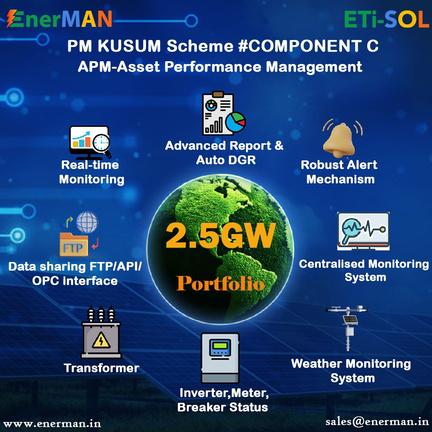
What trends and innovations do you anticipate shaping the future of the renewable energy industry, and how is EnerMAN preparing to lead in this space?
Energy Storage is becoming part of Renewable Energy, many solar PV plants integrated with energy storage to improve the grid stability and 24/7 stable power guarantee
EnerMAN is developing monitoring, control and analysis products for BESS (Battery Energy Storage System) This will support utilizing renewable energy 24/7 in future
EnerMAN is planning to develop advance features and analytics to reduce the losses and improve the performance of the Solar PV assets
EnerMAN tackles solar PV challenges with innovative solutions, offering precise data, timely alerts, and better plant management.”
Urbanization in India is taking place at an exponential rate As per Auguste Tano Kouamé - the World Bank's Country Director for Indiathe people living in cities will rise from over 360 million in 2011 to over 600 million by 2036 He further projects that urban areas will contribute 70% of the GDP in 2036. This needs uninterrupted energy supply. The real challenge lies in ensuring the energy supply while resorting to sustainability agenda It is pertinent to highlight that while cities globally consume over 70% of the energy they also contribute over 50% of the greenhouse gases The source these have been lighting, cooking, appliances, heating & cooling and vehicles. The situation catches serious attention as 17 of the top 20 fastest growing cities in the world are based in India As per 2019 report of Oxford Economics Surat, Agra, Bengaluru, Hyderabad, Nagpur, Tirupur, Rajkot, Tiruchirappalli, Chennai and Vijayawada would grow relative faster than others.
The answer to energy sustainability lies in the urban planning The energy system being planned now shall meet the twin objective of resilience and optimal use. The infrastructure being created now shall also be congruent to future growth, technology agnostic investment The regenerative building not only includes the green roof and skin but also cleans the ambient air and sequester carbon One need not imagine some far-off utopia because it is really quite close one city away. But the benefits of such an approach go far beyond the environment though these alone should be enough By shifting radically away from fossil fuels, we could reduce our carbon footprint enough to curb the worst effects of climate change Integration of renewable energy into urban design can help make our cities stronger The built spaces need to imagine beyond net zero to be regenerative i e being energy surplus
The approach needs to go beyond embracement of renewable energy to smart grids, e-vehicle adoption including its charging infrastructure, to exploring adopting District Energy System (DES) DES includes various technologies like combined heat and power (CHP), thermal storage, heat pumps and decentralised energy that develop collaborations between production and supply of electricity; heating, ventilation and air conditioning (HVAC). A decentralized power network is more robust, particularly in times of increasing uncertainty around the climate and its ever more frequent and violent wea fluctuations It is less susceptible to large-scale blackouts and recover from disruptions more rapidly
This should offer enormous space for innovation in cities. Char stations for electric cars that run on solar energy could poten change the way cities move and breathe, decreasing emissions and
pollution New advanced power grids would be able to distribute smartly, not wasting one resource and therefore increasing the work efficiency The crucial aspect of it will be to integrate others infrastructure like power supply, water supply, sanitation, public transport, sewage management, solid waste management.
The economic benefits could also be huge On one hand, there could be a large amount of money invested upfront; on the other, the longterm saving in energy costs might also be huge Furthermore, millions of jobs could be provided with renewable energies in installation, maintenance, and related industries There is, however, a need for policymakers to design appropriate regulatory frameworks that would allow and promote this kind of innovation in an urban setup What is important is for developers and construction companies to embrace this new paradigm. They should consider the use of renewable energy in their development project at hand, rather than another addition that would result in added costs
Naturally, the change would not come without challenges A section of experts can also argue that the transformation is too expensive or too complex They can point to the many renewable sources of energy that are inherently intermittent and the trickiness of retrofitting existing urban areas In fact, the cost of doing nothing far exceeds this simple transition The long-term costs of climate change are deep and wide, as it is depleting and will continue to deplete the remaining resources of fossil fuels In contrast, the investment in renewable energy today might help diminish this future cost through the kind of urban environments that are created more livable and sustainable in the long run
Moreover, many of the challenges involved in using renewable energies are surmounting by swift technological development. More effective and cheaper solutions for energy storage could even out the peak and trough of supply We stand at the threshold of a new era in urban development, and it is up to us to decide We should choose this moment to reshape our cities into sustainable powerhouses beacons of the innovation that will help light the way to a cleaner, greener future


SOFAR stands out with a comprehensive portfolio of PV and energy storage solutions, supported by advanced R&D and automation technologies, ensuring high reliability and quality.
Overcoming challenges in launching inverters and storage systems in India involved robust training, technical support, and stringent quality control measures
SOFAR is expanding solar adoption in rural India with innovative products like the 350kW PowerMega inverter, designed for efficiency and durability in harsh environments.
Can you highlight SOFAR's latest inverter technologies in India and how they stand out from competitors?
SOFAR offers one of the most comprehensive portfolios of PV and energy storage solutions in the industry. This includes microinverter systems, PV inverters ranging from 1 to 350 kW, hybrid inverters from 5 to 20 kW, and a variety of battery storage systems, all supported by our SOFAR Cloud platform for remote monitoring.
What sets us apart is our commitment to reliability and innovation, driven by independent R&D We've established ourselves as a trusted partner not only in India but globally We've also just completed the first stage of our new production base, which is designed to meet net-zero standards This facility uses state-of-the-art robotization and automation technologies to ensure top-quality products
What challenges did you face in launching Solar Grid-Tied Inverters, Hybrid Inverters, and Lithium-ion storage in India, and how did you overcome them?
Launching these products in India came with its share of challenges, particularly in ensuring proper installation and maintaining high quality We tackled this by offering comprehensive training and technical support to our distributors and installers Additionally, we've implemented strict quality control measures to ensure that every product meets our rigorous standards before it leaves the factory
How does SOFAR Solar ensure high levels of service and after-sales support in India?
We’ve established local branches, storage centers, sales offices, and service centers across India to ensure that we can provide quick and efficient service Our extensive and innovative product portfolio is tailored to the local market, and we’re proud to say that we’ve shipped over 4GW to India Moving forward, we’ll continue to innovate and optimize our services to meet the growing demand for localized support
What are SOFAR Solar's future plans for innovation and market penetration in India? How is SOFAR expanding its presence in India's rural areas for solar adoption?
We’re taking a dual approach: actively innovating new products through R&D and strategically entering markets In fact, SOFAR has been recognized by industry partners in India for our contributions For instance, our new 350kW PowerMega string inverter, which we launched at REI 2023, addresses key challenges like efficiency and safety while being highly user-friendly. It’s designed to survive harsh rural environments, making it ideal for broader adoption in these areas
What recent initiatives has SOFAR Solar taken to strengthen its market position in India?
Recognizing the potential in the storage segment, we’ve expanded into battery storage solutions which are now being applied across utility, C&I, and residential projects For large-scale PV stations, storage helps to shave peaks and improve power quality, while for C&I projects, it enhances off-grid utilization This has allowed us to provide more reliable and flexible solutions, which is crucial for strengthening our market position in India.
We’re not just focusing on solar inverters anymore; we’re expanding into all-scenario energy storage solutions, including the PowerMaster for utilities and PowerMagic for C&I applications The storage market has great potential, and we’re committed to driving innovation here These technologies are crucial for enhancing power quality and making renewable energy more user-friendly, which aligns with our long-term strategy for India
SOFAR’s focus on reliability and innovation, backed by independent R&D, ensures top-quality inverters from our net-zero production facilities.”
India has witnessed remarkable growth in the solar sector over the last decade According to the Ministry of New and Renewable Energy, the overall installed capacity has increased from 2 82 GW in March 2014 to 87.2 GW in July 2024. This can be attributed to aggressive government targets, supportive policy frameworks, decreasing technology costs, and increasing awareness about climate change While the sector is attracting significant investments from foreign and domestic sources, it also has inherent risks Contrasting views prevail regarding the future of


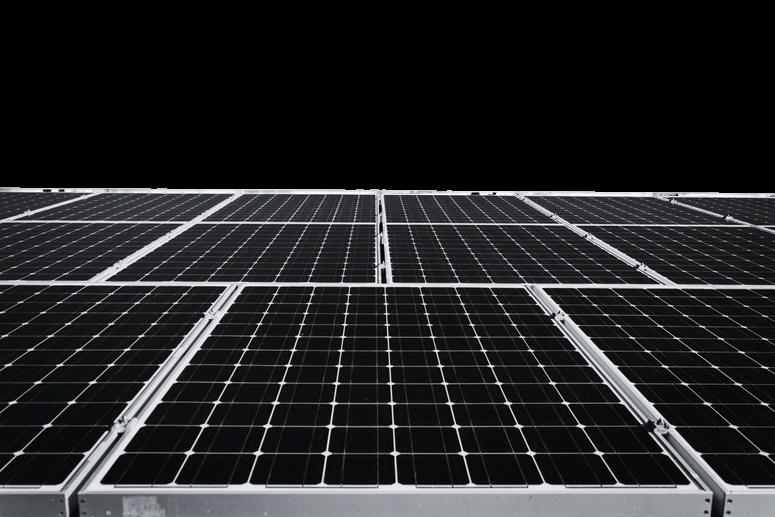
Government target and support:
The solar sector will play a crucial role in achieving India’s revised target of 500 GW of renewable capacity by 2030 With the launch of the PM Surya Ghar: Muft Bijli Yojana with a target of 1 crore households and the mandate for government buildings across India to achieve 100% rooftop solar saturation there is vast potential for investments in solar projects. Land-neutral technologies, such as floating PV, are becoming increasingly viable in states with land constraints
Domestic manufacturing:
With emphasis on domestic manufacturing through the reinstatement of the approved list of models and manufacturers (ALMM), there is an increased demand for domestic cells and modules Associated equipment, such as floating structures for floating PV, also opens doors for manufacturing in India.
Energy demand:
To deliver a sustained GDP growth rate of 8% until the year 2031–32, there is a need to increase installed electricity capacity by six to seven times Solar power can address these rising energy needs by reducing dependence on coal and mitigating environmental impacts.
Infrastructure limitations:
To accommodate increased capacity, substantial government funding is required for upgrading grid infrastructure and developing energy storage capabilities
Policy ambiguity:
Regulatory changes and policy shifts can considerably impact investor confidence Variability in state-level policies can disrupt investment plans and project timelines
Economic viability:
Solar projects require considerable upfront investment, making viable long-term financing options and the financial health of power purchasing entities critical factors. The lack of tariff revisions in longterm power purchase agreements and delay in payments from power purchasing entities or delay in receiving central financial assistance can pose risks to project viability
Land procurement and environmental concerns:
Acquiring land for large-scale solar projects is riddled with challenges, including competing land uses, regulatory barriers, and the potential for social and environmental conflicts that can escalate costs and timelines
Despite these challenges, India's solar market continues to attract investments because of its long-term growth potential. Over the past decade, the solar energy sector has observed an incredible compound annual growth rate of 35% The sector generated a revenue of USD 10 4 billion in 2023 and is expected to reach approximately USD 25 billion by 2030 Innovative solar applications, such as agrivoltaics, buildingintegrated PV, and floating PV, can unlock fresh investment avenues and mitigate land-use conflicts Although there are short-term uncertainties, the potential for long-term investment is encouraging Cost optimisation, effective risk management, and securing profitable power purchase agreements can define success for investors


Saatvik Solar has expanded its production capacity to 3 8GW and plans to establish a new integrated cell and module plant with 2GW cell and 4GW module capacity by FY 2024-25
The company introduced award-winning N-TOPCon technology, enhancing module efficiency and securing significant orders from industry leaders like L&T and SJVN
Saatvik Solar is launching the N-TopCon G12 R modules at the upcoming REI Expo, further advancing their commitment to high-efficiency solar solutions
What recent milestones has Saatvik Solar achieved in the past year?
Saatvik Solar in recent years have grown remarkably by adding extended manufacturing capacity and now strongly stands out at 3.8GW of production capacity per annum Saatvik Solar also announced its expansion plans to establish an integrated cell and module manufacturing plant in northern India The plant is set to have a cell production capacity of 2GW and a module production capacity of 4GW annually by the end of FY 2024-25 This expansion will further strengthen their manufacturing capabilities
Saatvik has also accomplished marquee EPC projects domestically with a strong installed capacity portfolio of Upto 50MW in Kusum, utility and rooftop projects Our latest innovated technology N-TOPCon has been an award winning introduction in the market securing major supply order’s in C&I utility and commercial segment. Some big order secured by Saatvik Solar from L&T, SJVN, Blupine, Shree Cements and many more in the list describes our commitment for the sustainable future
has Saatvik Solar introduced to boost module efficiency?
Saatvik Solar's recent launch of N-type TopCon modules in India marks a significant step in solar technology N-type TopCon (Tunnel Oxide Passivated Contact) modules offer several advantages over traditional Ptype modules with unique features such as Higher efficiency, The newly launched aligns with Saatvik Solar's commitment to adopting advanced technologies for higher module efficiency and improved project outcomes in India’s solar market.
Can you discuss any new product launches or upcoming projects that Saatvik Solar is particularly excited about?
Saatvik Solar is coming with a new technology in the market named “N-Topcon G-12 R and launching the same in the coming REI Expo These modules has been built in with deep research, focusing on offering the best quality and high efficiency output The introduction of this advanced technology reflects Saatvik’s continuous effort to lead in innovative solar solutions, providing enhanced energy generation for various applications
How does Saatvik Solar plan to address the growing demand for high-efficiency solar modules in the Indian market?
To address the growing demand for highefficiency solar modules in the Indian market, Saatvik Solar has several strategic initiatives in place, such as expanding manufacturing capacity, Introducing new technology modules ( N-TopCon and N-TopCon G-12 R), Saatvik Solar is focusing on the development and introduction of advanced, highefficiency solar modules A notable step in this direction is the recent launch of N-type

TopCon modules, which offer superior performance compared to traditional PERC (Passivated Emitter and Rear Cell) technology These modules provide higher energy yields and better temperature performance, making them ideal for both utility-scale and rooftop solar projects
What are Saatvik Solar's future plans for expanding market presence and advancing technology?
Saatvik Solar is set to establish a new integrated cell and module manufacturing plant in northern India by the end of FY 202425 This plant will have a cell production capacity of 2GW per annum and a module production capacity of 4GW per annum, enabling the company to meet growing demand and support large-scale projects To stay at the forefront of innovation, Saatvik Solar is investing in the development of nextgeneration solar technologies
By enhancing their EPC (Engineering, Procurement, and Construction) services for turnkey solar projects, Saatvik aims to offer comprehensive solutions to clients Saatvik Solar is heavily investing in its R&D infrastructure to enhance product quality, efficiency, and durability With plans to scale their operations and product offerings, Saatvik is targeting both domestic and international markets Their growing participation in utility-scale projects in India, alongside future plans to expand export markets, reflects a clear vision to broaden their market presence



Smart monitoring enables real time data analysis and remote management
What recent initiatives has Hopewind undertaken to strengthen its market position in India?
Hopewind focuses on R&D, launching new products like the 150kW String Inverter, and sustainability. key initiatives to strengthen our presence in the Indian market. One of the most important steps we've taken is forming partnerships with local manufacturers and installers These alliances have not only enhanced our local presence but also improved supply chain efficiencies, ensuring quicker and more effective product distribution
Can you highlight Hopewind's latest inverter technologies in India and how they differentiate from competitors?
Hopewind has been making significant strides in the Indian solar inverter market, leveraging innovative technologies to differentiate itself from competitors One of the key advancements is the introduction of inverters with efficiency rates that often exceed 98%, significantly enhancing energy conversion and minimizing losses This high efficiency makes Hopewind’s inverters appealing to both commercial and residential users
Additionally, our inverters are equipped with advanced smart monitoring systems, which enable real-time data analysis and remote management This feature sets us apart, as it helps users optimize the performance of their systems while simplifying maintenance processes
Another crucial aspect of Hopewind's offerings is our modular inverter design, which allows for easy scalability and maintenance This flexibility is especially beneficial for large-scale solar projects, where users can adapt capacity as their energy requirements evolve Through these technological innovations, we aim to provide highly reliable, efficient, and flexible solutions for the growing solar market in India
Additionally, we’ve introduced comprehensive training and support programs for local engineers and technicians. These initiatives are designed to equip them with the necessary skills to install and maintain Hopewind products efficiently, ensuring seamless performance in the long run
Our commitment to sustainability is another core focus Hopewind adheres to sustainable practices throughout our production processes, which aligns with the growing environmental consciousness among Indian consumers This commitment has resonated well with the market, as more people are looking for eco-friendly solutions.
What are Hopewind's future plans for innovation and market expansion in India?
Our plans for innovation and expansion in India are quite ambitious. First, we are significantly increasing our investment in research and development to create new products specifically tailored for the Indian market, with a focus on energy storage solutions Geographically, we aim to expand our reach into emerging markets, particularly in rural areas where solar adoption is still in its early stages
Additionally, we are working on developing customized inverter solutions for sectors like agriculture and micro grids, which will allow us to tap into niche markets and better serve the unique needs of the region.

What new products or technologies is Hopewind launching at the REI Expo 2024, and how will they impact the solar industry in India?
At the REI Expo 2024, we are excited to launch our 150kW String Inverter, designed specifically for the Commercial and Industrial (C&I) segment This product is set to be a game changer, especially for large-scale rooftop projects The innovations we are showcasing at the Expo are poised to set new benchmarks in the solar inverter market. With a strong focus on smart technology and sustainability, these advancements align seamlessly with India’s renewable energy goals and have the potential to significantly accelerate the adoption of solar technologies across various sectors
By leveraging cutting-edge technology and strategic initiatives, Hopewind is positioning itself as a key player in India's rapidly evolving solar landscape, and we are poised for substantial growth in the years ahead





Skyfri Energy uses predictive maintenance and robotic cleaning to optimize solar asset performance
Outsourcing O&M helps Indian Developers and IPPs focus on core tasks while ensuring expert solar management
Skyfri Energy ensures regulatory compliance with a dedicated team, regular audits, and advanced monitoring systems
Skyfri Energy has been a leader in solar asset management. Could you share the latest advancements in O&M practices and technologies that Skyfri Energy is adopting to maintain its leadership in 2024?
At Skyfri Energy, we are committed to staying ahead of the curve in Operations and Maintenance (O&M) practices In 2024, we are focusing on several key areas that highlight our innovation in solar asset management One of the significant advancements is the integration of predictive maintenance. By leveraging advanced data analytics, we can now predict equipment failures before they happen, allowing for timely interventions, which reduces unexpected down times and lowers maintenance costs.
We also offer comprehensive O&M services, including performance monitoring, root cause analysis, and preventive maintenance. Our integrated Computerized Maintenance Management System (CMMS) dynamically generates incident reports and helps prioritize tickets for site teams, enabling faster response times In addition, we have introduced robotic cleaning solutions that use dry cleaning methods for solar modules, minimizing the need for water and aligning with our sustainability goals
G S Venkatesh
Director & CEO
Skyfri Energy Pvt Limited
Furthermore, we are also focusing on sustainability initiatives within our O&M operations For example, we are increasingly adopting electric vehicles for site visits to further reduce our carbon footprint These advancements collectively position Skyfri Energy at the forefront of solar asset management, ensuring optimal performance and reliability for our clients
What is your perspective on the outsourcing of solar O&M by Indian Developers and Independent Power Producers (IPPs)?
Outsourcing O&M for solar projects has become an increasingly viable option for Indian Developers and IPPs, and there are multiple benefits to this approach. One of the primary advantages is that outsourcing allows developers and IPPs to focus on their core competencies Managing O&M in-house often requires significant resource allocation, which could otherwise be better invested in their primary business activities
Additionally, outsourcing to a specialist O&M contractor like Skyfri ensures that the PV systems are managed by experts whose primary focus is on asset management This ensures high system availability and quick response times, which are critical for maintaining performance Large-scale solar plants, in particular, have complex needs that are often better addressed by a dedicated O&M provider Handling the intricate paperwork, managing long-term contracts, and ensuring adequate staffing levels are tasks that a specialized contractor can execute more efficiently
Moreover, making accurate predictions about future O&M requirements can be challenging without the necessary expertise O&M specialists are better equipped to make strategic evaluations and provide performance guarantees, helping to ensure the long-term success of solar projects
How does Skyfri Energy ensure compliance with local and international regulations, especially given the stringent reporting requirements for solar projects in India?
Compliance with regulations is a critical component of our operations, and we have developed a multi-layered strategy to ensure that we meet both local and international standards. To begin with, Skyfri Energy has a dedicated compliance team that monitors regulatory updates and ensures that all our assets adhere to the latest laws and guidelines This team also ensures that we meet our contractual obligations to off-takers and lenders, providing a strong foundation of trust and accountability
We also conduct regular audits and inspections of our sites to ensure compliance with operational standards and safety regulations This proactive approach allows us to identify and rectify potential issues before they escalate Additionally, we have integrated compliance metrics into our Skyfri Intelligence platform, which not only monitors asset performance but also tracks compliance-related data. This helps us streamline our reporting processes and ensures that all necessary documentation is readily available for stakeholders
To maintain high standards, we also invest heavily in staff training and development Continuous training ensures that all team members are up-to-date with the latest regulations and best practices in solar asset management. Lastly, we actively engage with regulatory bodies at both local and international levels, contributing to industry discussions and staying ahead of legislative changes
How does Skyfri Energy ensure compliance with Environmental, Health, and Safety (EHS) standards to mitigate accidents and ensure workforce safety?
Skyfri Energy places significant emphasis on Environmental, Health, and Safety (EHS) standards, particularly given the risks associated with solar O&M We have implemented a robust EHS management system that is compliant with ISO 14001:2015 and ISO 45001:2018 standards This system focuses on a commitment to environmental protection, occupational health and safety, and continuous improvement in these areas
We also prioritize training and awareness across all levels of our workforce Regular safety drills and toolbox talks are conducted to ensure that all personnel are well-versed in potential hazards and best safety practices Furthermore, site-specific risk assessments, such as Hazard Identification and Risk Assessments (HIRA) and Environmental Impact Assessments (EIA), are carried out to identify and mitigate risks associated with solar O&M activities
In terms of preventive measures, we enforce the use of Personal Protective Equipment (PPE) and implement Lock Out Tag Out (LOTO) procedures to safeguard our personnel during maintenance activities Regular internal audits and reviews of our Quality Management and EHS systems also help us identify areas for improvement and ensure ongoing compliance.
Our ultimate goal is to prevent any workrelated injuries or fatalities With this in mind, our EHS mission is centered on achieving zero fatalities at the workplace, and we continuously strive to provide a safe and secure environment for all our employees and contractors




What are Skyfri Energy’s future strategic business goals for Solar O&M in India and overseas?
Looking ahead, Skyfri Energy has ambitious goals for the future, both in India and internationally One of our key focus areas is the further integration of technology into our operations We plan to continue enhancing our Skyfri Intelligence platform to provide real-time monitoring and predictive maintenance solutions. This will allow us to further optimize solar asset performance while reducing downtime
We are also looking to expand our service offerings to include advanced analytics and comprehensive maintenance solutions This will enable us to cater to a broader range of solar projects, including substations and new market segments
In line with global sustainability trends, we are committed to incorporating greener practices into our operations This includes increasing
our use of electric vehicles for site visits and adopting energy-efficient technologies wherever possible We believe that these initiatives will help us further align with global sustainability goals and strengthen our market position
Additionally, we are focusing on market penetration in emerging regions. While India remains our primary market, we are actively seeking to expand our footprint in other parts of Asia and beyond Our expertise in solar O&M positions us well to capture new opportunities in these regions.
Lastly, we are working on building strategic partnerships with technology providers and other key stakeholders in the industry By collaborating with these partners, we aim to drive innovation in solar O&M and stay ahead of the curve in this rapidly evolving sector These goals reflect our commitment to leading the solar O&M industry through innovation, operational excellence, and sustainability.
We empower our workforce through regular training, safety drills, and toolbox talks, ensuring everyone is aware of potential hazards and the best safety practices.”


WAA Cables connects solar power with the grid through R&D, sustainability, and partnerships.
Their products boost solar efficiency and reliability
Quality is ensured through rigorous testing, advanced materials, and automation.
How does WAA Cables reflect the motto “Connecting the Sun to the Grid” in its products and strategy?
Incorporating our motto, 'Connecting the Sun to the Grid,' into our product development and business strategy is pivotal at WAA Cables Pvt Ltd It's not just a tagline; it's a guiding principle that defines our approach Firstly, our R&D efforts are laser-focused on creating innovative cable and connectivity solutions specifically designed for solar energy systems. We're constantly pushing the boundaries to ensure our products seamlessly integrate solar power into the grid, enhancing efficiency and reliability
Moreover, sustainability is at the heart of everything we do. From sourcing materials to manufacturing processes, we prioritize ecofriendly practices By doing so, we contribute to the larger goal of making solar energy a cornerstone of our sustainable future Our commitment to community empowerment sets us apart. Whether it's supporting residential installations or large-scale projects, we're dedicated to enabling individuals and organizations to harness solar power and connect it to the grid, reducing reliance on nonrenewable sources
Collaboration is key in this journey We actively engage with industry partners to co-create solutions that streamline the connection process and amplify the impact of solar energy on the grid. Above all, our customer-centric approach drives us. We understand the diverse needs of our clients, and we're committed to delivering personalized solutions that make connecting the sun to the grid a seamless experience In essence, at WAA Cables Pvt Ltd, our motto isn't just a statement it's a commitment to driving the solar revolution forward, one connection at a time
How do WAA Cables' products improve efficiency and reliability in solar energy systems?
Our cables are meticulously designed to optimize the performance of solar energy systems By ensuring minimal energy loss during transmission, we help maximize the efficiency of the entire system This means that more of the energy generated by solar panels reaches its intended destination, whether it's a residential home or a large-scale utility grid, contributing to overall energy savings and environmental sustainability
Reliability is another cornerstone of our product philosophy. We understand the importance of uninterrupted power supply, especially in renewable energy systems where consistency is key That's why our cables undergo rigorous testing and quality control measures to ensure they can withstand harsh environmental conditions, temperature fluctuations, and other challenges commonly encountered in solar energy applications This reliability not only enhances the performance of solar installations but also minimizes downtime and maintenance costs, ultimately providing peace of mind to our customers
In essence, our products play a crucial role in enhancing the efficiency and reliability of renewable energy systems, making solar energy more accessible and dependable for communities and businesses alike
How does WAA Cables ensure quality and introduce manufacturing innovations?
At WAA Cables, we prioritize the quality and durability of our cable and wire products, recognizing their critical role, especially in vital areas like renewable energy systems
To uphold these standards, we've established a robust quality assurance process that spans every stage of manufacturing. This involves careful selection of raw materials, thorough testing, and ongoing monitoring to ensure adherence to industry benchmarks such as ISO 9001 By maintaining these rigorous protocols, we guarantee that every product bearing the WAACAB brand name meets or surpasses customer expectations for performance and reliability
In terms of innovation, we're continuously exploring new technologies and manufacturing methods to enhance product quality and longevity For instance, we've invested in advanced materials that offer improved resistance to environmental factors like ensuring durability
even in challenging outdoor conditions. Additionally, we're integrating innovative design features such as enhanced insulation and shielding to boost the efficiency of renewable energy systems while minimizing energy loss
Overall, our dedication to quality and innovation drives us to continually refine and enhance our products, ensuring that WAA Cables remains a trusted partner for customers seeking reliable cable and wire solutions for their renewable energy projects.
How is WAA Cables using advanced tech to innovate and expand its range?
At WAA Cables, we're constantly exploring ways to integrate advanced technologies into our product development process to drive innovation and expand our cable product range One key strategy we employ is investing in research and development (R&D) We have a dedicated team focused on staying ahead of the curve, identifying emerging technologies and trends in the cable industry This allows us to seize opportunities for innovation and enhance our product offerings
Advanced materials play a crucial role in our innovation efforts We're continually exploring materials with superior properties that can enhance the performance and durability of our cables These materials provide increased resistance to environmental factors such as moisture and temperature fluctuations, ensuring reliability even in challenging conditions
Automation and digitalization are also key drivers of innovation for us By leveraging technologies, we streamline our manufacturing processes, reduce lead times, and improve product consistency This allows us to meet the growing demand for high-quality cables more efficiently.
Furthermore, collaboration and partnerships play a significant role in our innovation strategy We work closely with technology partners, research institutions, and industry experts to access cuttingedge technologies and foster joint development initiatives These partnerships enable us to accelerate innovation and expand our product range to meet the diverse needs of our customers Overall, our integration of advanced technologies is central to our commitment to innovation and product excellence at WAA Cables By embracing these technologies, we're not only enhancing the quality and performance of our cables but also driving the evolution of the cable industry


India's journey towards a sustainable energy future is a compelling narrative of the intricate dance between policy directives and market dynamics. The solar sector, a cornerstone of this transformation, exemplifies how government intervention and market forces must collaborate to foster growth in an industry with evolving technology, substantial capital outlay and heavy reliance on other infrastructures like transmission, etc
In the early days of India's solar revolution, the sector faced significant challenges. High costs, nascent technology, and a lack of established infrastructure made solar energy an expensive proposition The tariff for solar energy was as high as ₹18 to ₹20 per kWh, making it less attractive compared to conventional energy sources At this critical juncture, the Indian government stepped in as a catalyst, understanding that the transition to renewable energy required more than just market enthusiasm
Through a series of well-structured policies and incentives, the government laid the foundation for the solar sector Initiatives such as the National Solar Mission, introduced in 2010, set ambitious targets and provided subsidies, tax benefits, and feed-in tariffs that encouraged investment in solar projects The introduction of Renewable Purchase Obligations (RPOs) mandated that a certain percentage of power consumption had to be sourced from renewable energy, further spurring demand.
This period was marked by a regulatory framework that sought to balance risk and reward, offering a safety net for early adopters while driving demand creation through government-backed initiatives Without this initial push, the market alone would have struggled to make solar energy viable in a country where cost competitive fossil fuels dominated the energy mix
Market Forces Take the Reins: Efficiency and Innovation
As the government's push began to bear fruit, the solar industry in India started to organize itself, gradually reducing its dependence on state support. Technological advancements, coupled with increased competition, drove significant improvements in efficiency The cost of solar panels plummeted, and new practices, such as auctions, were adopted to ensure transparency and competitiveness in the bidding process
The market, now buoyed by the infrastructure and confidence built through government intervention, began to play a more dominant role The industry saw an influx of private investments, and economies of scale further brought down costs Such active play by market forces drove, the tariff for solar energy in India to sub ₹2 per kWh, making it one of the cheapest sources of energy in the country This dramatic reduction in tariffs is a testament to the market's ability to bring in financial engineering and technological advancements once the foundational support is in place
Looking ahead, it is clear that the symbiotic relationship between policy and market forces must continue. The solar sector, despite its remarkable progress, still faces challenges that require coordinated efforts from both the government and the industry Issues such as supply chain, land acquisition, transmission infrastructure, and financing for large-scale projects are areas where government intervention remains crucial.
At the same time, the market must continue to innovate and adapt to changing circumstances As the sector matures, the role of policy may shift from direct intervention to creating an enabling environment that fosters innovation and addresses new challenges, such as grid integration, innovative power flow structuring and energy storage
In conclusion, the rapid adoption of solar energy in India is a success story of policy and market forces working in tandem While the roles and contributions of each may evolve over time, neither can work in isolation in an industry as complex and capital-intensive as solar energy The journey of India's solar sector underscores the importance of this delicate balance, where government push and market pull together propel the nation towards a brighter, more sustainable future

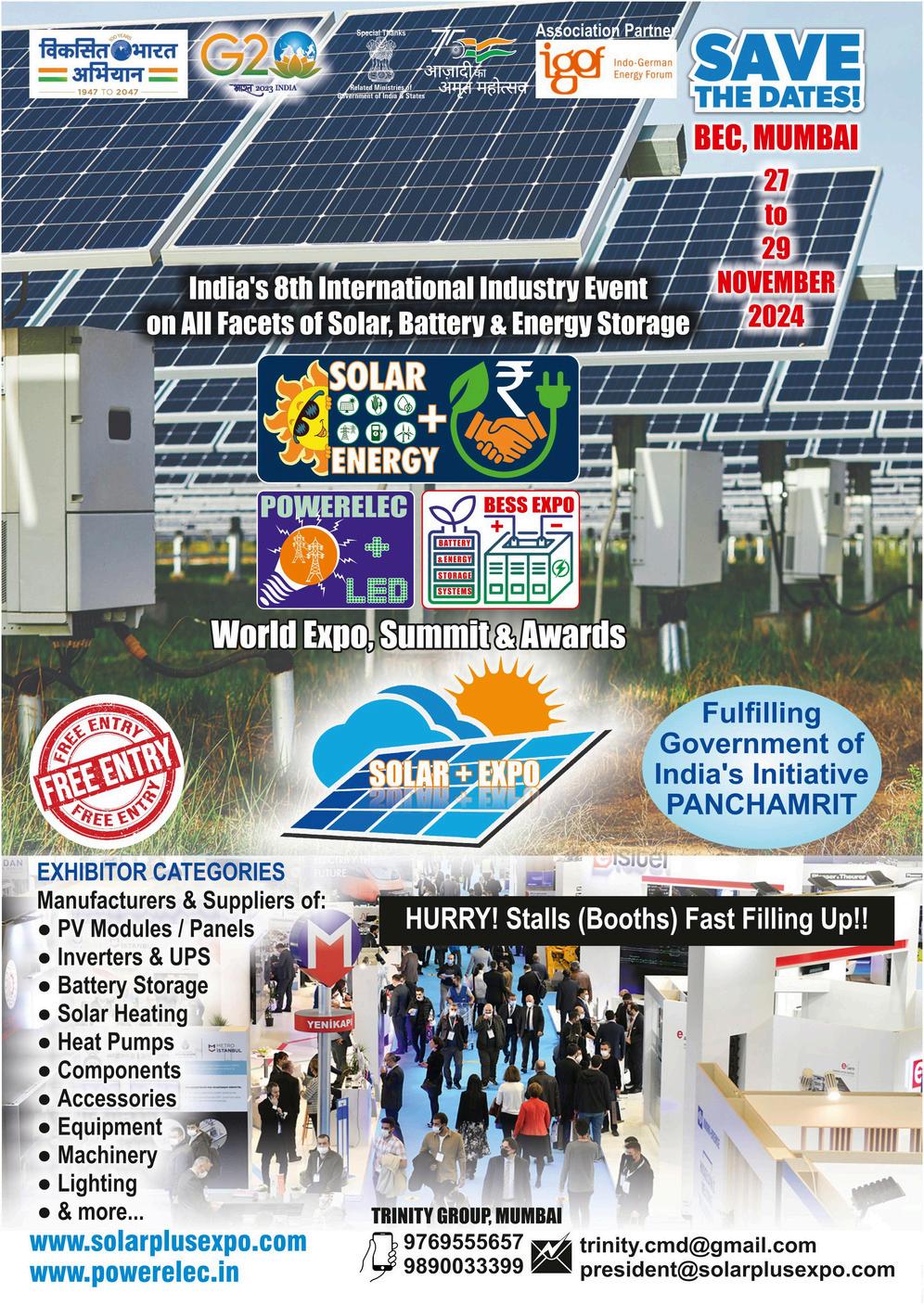

What innovative financing models is Freyr Energy utilizing to fund solar projects, and how do these models benefit both investors and endusers?
By partnering with numerous finance lenders, Freyr Energy offers attractive financing solutions, including zero-cost EMIs and 100% financing at very low-interest rates These financing options are available for variable tenure periods, catered to residential and MSME customers They make solar energy systems more accessible by reducing the financial burden of the initial investment In addition to this, for most MSME clients, solar system serves as the collateral, so borrowing becomes more straightforward Additionally, Freyr Energy ensures fair and competitive pricing, enhancing the value proposition for end-users
The benefit for Lenders is that these models open a largely untapped market, by removing cost-entry barriers and providing new growth opportunities This creates a win-win situation, driving the adoption of solar energy and contributing to a sustainable future
How does Freyr Energy approach risk management in its solar investments, particularly in the context of market volatility and policy changes?
On the policy end, there are no particular risks in the short and medium term. We do face risks of supply occasionally and also, price fluctuations We manage these by maintaining sufficient stocks in inventory so that our price
Government initiatives and solar loans have significantly boosted India's solar adoption and affordability
Innovative financing solutions, including zero-cost EMIs and 100% financing, make solar systems accessible, benefiting both Lenders and end-users.
Freyr Energy integrates ESG criteria, supporting local jobs, gender equality, and a 100% Indian supply chain
and project execution timelines for customers are fulfilled Finally, since Freyr operates on a Capex model, where the client owns the system from day one, we do not have long term cash flow risks from clients
How have recent government policies and incentives impacted the financing and growth of solar energy projects in India?
Initiatives such as the PM Surya Ghar Muft Bijli Yojana and increased subsidies under this scheme for smaller solar systems have turbo charged client interest and willingness to shift to solar Additionally, the government's push for rooftop solar has resulted in national banks, such as SBI, Bank of Baroda, etc offering solar loans to residential customers. Furthermore, many NBFCs are now providing solar loans at attractive and competitive interest rates, significantly boosting the solar transition in the residential sector This increased financial support has played a crucial role in making solar energy more affordable and accessible These policy changes along with other government initiatives in the past have resulted in India surpassing Japan to become the world’s third largest solar power generator. It also puts India on the path of achieving its goal of net zero carbon emissions by 2070
Can you discuss the role of sustainable finance in the solar sector, and how Freyr Energy integrates ESG (Environmental, Social, and Governance) criteria into its financial strategies?
sector, the environmental impact of our work is clear By working with local microentrepreneurs for installation and after sales service, we create a significant number of jobs in the local community In addition to this, our female employees make-up 50% of the leadership team and average salaries of female employees at Freyr is 30% higher than male employees salaries Finally, by ensuring that 100% of the supply chain is Indian, we are able to mitigate risks and meet global standards from a governance standpoint
We offer various financing options through partnerships with leading financial institutions to our customers and continue to work on offering more innovative ownership options This approach not only makes solar energy more accessible but also aligns with Our mission is to provide decentralised, democratised & decarbonised solar power to every home and small business across India
What challenges does Freyr Energy face when raising capital for solar projects, and how do you overcome them?
We are an asset light company that does not own solar assets So, we do not raise capital for building large scale solar projects. We have raised venture capital in the past for growing on our technology platform and building out our sales/marketing teams Approaching investors who are genuinely interested and experienced in the energy sector has played a very important role in our fund raising success
Opportunities
The debate between energy independence and grid integration is central to the evolving landscape of solar storage solutions As countries and corporations navigate the transition to renewable energy, the strategies they adopt will significantly impact their energy resilience, economic stability, and environmental footprint This article explores the diverging strategies in solar storage solutions, examining global and Indian market trends, LCOE, and other critical factors that shape the future of energy storage
GLOBAL MARKET TRENDS:
The global energy storage market has experienced remarkable growth, driven by advancements in technology and a shift towards sustainable energy sources In 2023, the market saw its capacity triple to 45 GW/97 GWh, with projections indicating that it will surpass 100 GWh in 2024. This growth reflects an annual expansion rate of 21%, with expectations to nearly triple 2024 capacity by 2030, reaching 137 GW/442 GWh
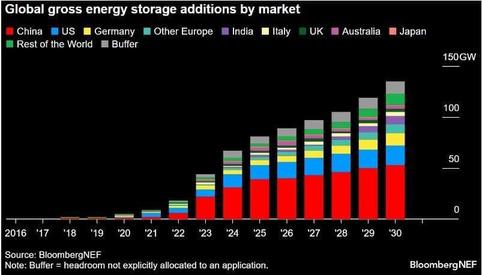
China:
China remains a leader in BESS deployments, capturing 55% of the global market. The country’s focus on large-scale projects and policy support has driven significant market expansion
United States:
The US, particularly Texas and California, benefits from federal incentives like the Investment Tax Credit (ITC) and state-level storage targets
Europe:
Europe leads in behind-the-meter installations, with high retail electricity prices and incentives for rooftop solar plus BESS driving adoption
TECHNOLOGICAL ADVANCEMENTS IN SOLAR STORAGE:
1. Lithium Iron Phosphate (LFP) Batteries
Lithium iron phosphate (LFP) batteries have emerged as a dominant force in the solar storage market due to their safety, longevity, and costeffectiveness
Cost Efficiency:
LFP batteries have seen significant cost reductions, with systemlevel costs dropping by 43% in China in 2023 This trend is expected to continue, making LFP batteries increasingly accessible
Safety and Stability:
LFP batteries are known for their thermal stability and lower risk of thermal runaway, enhancing safety for residential and commercial applications.
Market Share:
According to Bloomberg NEF, LFP batteries are projected to dominate the market, with NMC batteries expected to hold only a 1% share by 2030
2. Sodium-Ion Batteries
Sodium-ion technology represents a promising alternative to lithium-ion solutions. Key developments include:
Development in China:
A 10 MWh sodium-ion storage project in Nanning, China, began operations in May 2024, with plans to scale up to 100 MWh Additionally, a 50 MW/100 MWh sodium-ion project is underway in Qianjiang, Hubei Province
Cost and Availability:
Sodium-ion batteries benefit from lower material costs and abundant raw materials, positioning them as a competitive alternative to lithium-ion technology.
Manufacturing Capacity:
China leads in sodium-ion battery manufacturing, with capacity estimates significantly exceeding those in other regions
3 Vanadium Redox Flow Batteries
Vanadium redox flow batteries are gaining attention for their scalability and long-duration storage capabilities:
Large-Scale Projects:
China has commissioned the world’s largest vanadium redox flow battery project in Dalian, initially with a capacity of 100 MW/400 MWh, scaling up to 200 MW/800 MWh.
Flexibility:
These batteries are well-suited for grid-scale applications, providing stable energy supply over extended periods
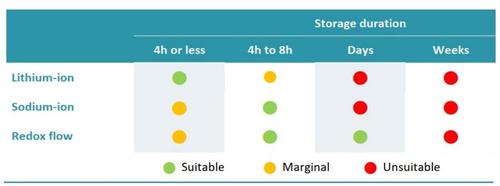
India’s energy storage sector is evolving rapidly, driven by policy support and market demand The country has seen substantial reductions in capital expenditures and tariffs for battery storage systems:
Market Growth:
India has developed a pipeline of approximately 6.44 GWh of standalone BESS projects Momentum begun with SECI Momentum begun in 2022 with SECI, 500 MW/1000 MWh tendering followed by series of ESS focused tenders, now crown presently owned by SECI (1GW/ 2 GWh) tender
Cost Trends:
Capital expenditures for battery storage in India have decreased significantly In 2021, standalone storage costs were $450/kWh, which dropped to $200/kWh in 2024 Co-located storage costs have also decreased to $150/kWh
Tariff Reductions:
In 2024, standalone BESS tariffs in India reached INR 3 72 lakhs/MW/month, reflecting a 66% decrease over two years The cost for solar plus BESS is competitive at INR 3 41/kWh
Demand & Investment:
To achieve the 500GW of non-fossil fuel by 2030 CEA has conducted a techno-economic analysis which comprises that an optimal mix of WSH with PSP & BESS would be the potential sources India’s ESS is expected grow 5x between with an estimated investment of INR 476 thousand crores
LCOE:
LCOE for standalone BESS is expected to decrease by 30% by 2030, with significant reductions for renewables coupled with battery projects, potentially reaching a 40% decrease This trend is expected to continue as technology advances and market conditions improve
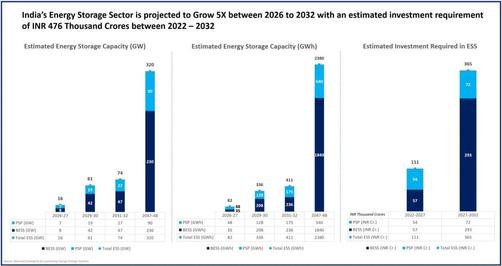
Energy independence refers to the capability of generating and storing energy within a localized system, reducing reliance on external grid infrastructure This strategy is appealing for its potential to enhance energy security and resilience, particularly in remote or underserved areas. Key factors include:
Cost Considerations:
While initial investments in standalone solar storage systems can be high, declining battery costs and advancements in technology are making this strategy increasingly feasible
Reliability:
Energy independence can offer greater reliability in areas prone to grid instability or outages, providing a more resilient energy supply
Technological Innovations:
Advances in battery storage, such as the development of highcapacity and long-duration storage solutions, are supporting the growth of energy independence
Grid integration involves connecting solar storage systems to the central grid, enabling the efficient management of energy supply and demand on a larger scale This strategy supports the stability of the grid and facilitates the integration of intermittent renewable sources Key factors include:
Economic Efficiency:
Grid-integrated systems benefit from economies of scale and can leverage grid infrastructure to optimize energy distribution and reduce costs.
Policy Support:
Many countries and regions have implemented policies and incentives to promote grid integration, such as capacity markets and ancillary services
Market Flexibility:
Grid integration allows for flexible energy management, enabling the storage and dispatch of energy to meet fluctuating demand and supply conditions
The choice between energy independence and grid integration in solar storage solutions represents a pivotal decision for energy policy and strategy. Each approach offers distinct advantages and challenges, influenced by technological advancements, market dynamics, and policy frameworks
As India continues to embrace renewable energy solutions, rooftop solar storage will play a pivotal role in enhancing energy security, reducing costs, and supporting the transition to an energy independence in a sustainable energy future
Whilst Government is more focused to promote the growth of utility scale ESS projects through various tenders like peak demand, FDRE, load following to achieve the rapidly increasing & fluctuating energy demand An accelerating the adoption of advanced storage technologies, Government funding through VGF for emerging technology, reduction in duties and adoptive policy framework leveraging both energy independence and grid integration will be essential in navigating the complexities of the renewable energy transition

The world is rapidly shifting towards renewable energy sources, and solar power is at the forefront of this transition However, the way we store and distribute this energy is a subject of intense debate Two primary strategies have emerged: energy independence and grid integration Each approach has its own merits and drawbacks, and the choice between them will significantly impact the future of solar energy
Energy Independence: The Appeal of SelfSufficiency
Energy independence, often associated with off-grid solar systems, emphasizes self-reliance and resilience Individuals or communities generate and store their own solar energy, reducing their dependence on the traditional power grid This approach offers several advantages:
Resilience:
Off-grid systems are less vulnerable to power outages and grid disruptions, providing a reliable source of energy even in emergencies. This is particularly crucial in regions with unreliable grid infrastructure or those prone to natural disasters
Energy Security:
By generating their own power, individuals and communities are less susceptible to fluctuations in energy prices and supply. This can lead to greater energy cost stability and predictability
Environmental Benefits:
Off-grid solar systems reduce reliance on fossil fuels, contributing to a cleaner and more sustainable energy future They help mitigate greenhouse gas emissions and reduce air pollution
Accessibility:
Off-grid solutions can bring electricity to remote or underserved areas where grid extension is impractical or expensive This can improve the quality of life and economic opportunities in these regions
However, energy independence also has its challenges:
High Upfront Costs:
The initial investment in off-grid solar systems and battery storage can be substantial, potentially limiting their accessibility for lowincome individuals and communities
Limited Scalability:
Off-grid systems are typically suitable for smaller-scale applications and may not be feasible for large communities or industrial needs Meeting the energy demands of larger entities often requires extensive and expensive battery storage solutions.
Maintenance and Replacement:
Batteries and other components require regular maintenance and eventual replacement, adding to the long-term cost and complexity of off-grid systems
Intermittency:
Solar energy generation is inherently intermittent, dependent on sunlight availability Off-grid systems need to be carefully designed with adequate battery storage to ensure a consistent power supply, especially during periods of low sunlight or extended cloudy weather
Grid integration focuses on connecting solar energy systems to the existing power grid This approach allows for the sharing and distribution of solar energy across a wider network, offering several benefits:
Efficiency:
Excess solar energy can be fed back into the grid, reducing overall energy waste and benefiting the entire community. This can help balance supply and demand, especially during peak solar generation hours
Cost Savings:
Grid-tied systems can take advantage of net metering policies, allowing users to offset their energy bills by exporting surplus power This can significantly reduce electricity costs and accelerate the return on investment for solar installations.
Scalability:
Grid integration is well-suited for large-scale solar installations, making it a viable option for powering entire cities or regions. It allows for the efficient utilization of vast solar farms and other largescale renewable energy projects
Grid Stability:
Advanced grid management systems can leverage solar energy to e t
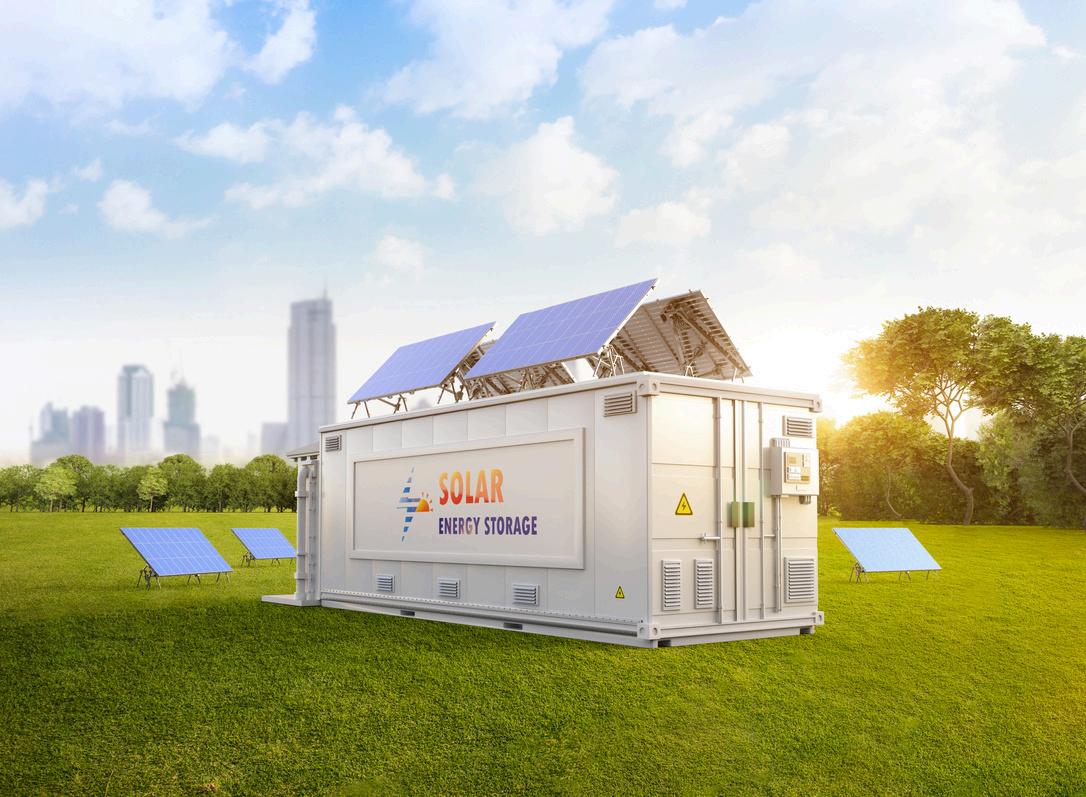
However, grid integration also faces certain challenges:

Grid Dependence:
Grid-tied systems are reliant on the grid's infrastructure and are susceptible to outages and disruptions. This can undermine the reliability of solar power during grid failures
Policy and Regulatory Hurdles:
The success of grid integration depends on supportive policies and regulations, such as net metering and feed-in tariffs. Inconsistent or unfavorable policies can hinder the adoption of grid-tied solar systems
Technical Challenges:
Integrating large amounts of variable renewable energy into the grid requires sophisticated grid management and energy storage solutions. Balancing the intermittent nature of solar power with the grid's demand requires careful planning and investment in infrastructure
Transmission and Distribution Losses:
Transporting solar energy over long distances through the grid can result in transmission and distribution losses, reducing the overall efficiency of the system
Energy storage technologies, such as batteries, play a crucial role in both energy independence and grid integration strategies. They allow for the storage of excess solar energy generated during the day for use at night or during periods of low sunlight This enhances the reliability and flexibility of solar power systems, making them a more viable alternative to traditional energy sources Advancements in battery technology, including increased capacity, longer lifespan, and reduced costs, are critical for the widespread adoption of solar energy storage solutions
The choice between energy independence and grid integration is not necessarily an either/or proposition A hybrid approach that combines the benefits of both strategies may be the most effective way to harness the full potential of solar energy This could involve:
Microgrids:
Smaller, localized grids that can operate independently or in conjunction with the main grid, providing resilience and flexibility
Community Solar:
Shared solar installations that allow multiple users to benefit from solar energy without individual rooftop installations. This can increase access to solar power for renters or those with unsuitable rooftops
Smart Grids:
Advanced grid management systems that can intelligently integrate and distribute solar energy, optimizing efficiency and reliability Smart grids can leverage real-time data and automation to balance supply and demand, maximizing the utilization of solar power
The debate between energy independence and grid integration highlights the complexities and opportunities in the solar storage landscape Both strategies have their own merits and challenges, and the optimal approach will vary depending on the specific context and needs. Factors such as geographic location, energy demand patterns, policy environment, and technological advancements will all influence the choice between these strategies
As technology advances and policies evolve, we can expect to see a more diversified and integrated solar energy future, where both energy independence and grid integration play a vital role in powering our world sustainably The key lies in finding the right balance between these approaches, leveraging their strengths and mitigating their weaknesses to create a resilient, efficient, and accessible solar energy ecosystem.

India is on a pivotal journey to significantly expand its renewable energy capacity, with ambitious targets set for 2030 and a vision for net-zero emissions by 2070 Achieving these goals requires not only a massive scale-up in renewable energy capacity but also a corresponding surge in financial investments IRENA and other global bodies have highlighted the urgent need for increased investments in renewable energy to meet climate goals, making financing a central challenge for India and other nations
Global investment in renewable energy has seen significant growth, reaching a record $0 5 trillion in 2022 While this figure marks a substantial increase, it still falls short of what is required to align with the 1 5°C climate target set by IRENA In fact, the current investment levels represent less than one-third of the annual investment necessary to keep global warming within safe limits In 2023, the total investment in energy transition technologies, which encompasses renewable energy and energy efficiency, approached $2 trillion This surge underscores the growing recognition of the need for urgent action to combat climate change However, to truly make a difference, annual investments need to quadruple This means that the world needs to mobilize approximately $4-5 trillion annually to effectively transition to a low-carbon economy and meet the climate targets set by international agreements
Debt financing plays a critical role in the global energy sector, constituting 46% of global energy investments This is particularly true for projects with predictable revenue streams, such as solar and wind energy, which have become increasingly attractive to investors due to their stable returns Public finance remains a cornerstone of energy investments, accounting for 37% of the total This is primarily driven by state-owned enterprises in emerging economies, where public funds are often used to de-risk investments and attract private capital
India’s renewable energy goals are among the most ambitious in the world By 2030, the country aims to add 500 GW of renewable energy capacity, a target that requires an estimated $500 billion in investments This financial requirement is spread across various sectors within renewable energy, including large-scale solar and wind projects, grid infrastructure, storage solutions, and decentralized energy systems To achieve its 2030 goals, India needs to mobilize approximately $30-40 billion annually However, the challenge does not end there Maintaining progress towards net-zero emissions by 2070 will require continuous investments, estimated at around $10-15 billion per year after 2030.
Historically, India’s renewable energy sector has been primarily financed through public sector banks and financial institutions
Entities like the Power Finance Corporation (PFC) and Rural Electrification Corporation (REC) have provided long-term, lowinterest loans that have been instrumental in financing large-scale projects However, as the sector expands and the demand for capital grows, there is an urgent need to diversify the financing mix Multilateral development banks, such as the World Bank and the Asian Development Bank (ADB), have played a significant role in providing loans, grants, and technical support for renewable energy projects in India These institutions can further contribute an
estimated $5-10 billion per year to support the country’s energy transition. Additionally, large Indian corporations such as Tata, Adani, and Reliance have been at the forefront of investing in renewable energy, driven by both regulatory requirements and strategic considerations These companies are expected to contribute around $10-20 billion annually to expand their renewable energy portfolios
To attract the necessary investments, India must adopt innovative financing models that have been successful globally Issuing green bonds is one of the most effective ways to raise funds from investors who are interested in sustainable investments Countries like Poland and France have successfully issued sovereign green bonds to support their environmental initiatives India can follow suit and aim to source around $5-10 billion per year through green bond issuances These bonds can be used to finance a wide range of projects, including renewable energy, energy efficiency, and climate adaptation Public-private partnerships (PPPs) also offer a viable solution by combining the strengths of the public and private sectors to finance large-scale renewable energy projects Public-private partnerships have proven effective in delivering large infrastructure projects by offering government guarantees and risk mitigation strategies that attract private investors The United Kingdom’s Private Finance Initiative (PFI) and Australia’s PPP framework are prime examples of how these partnerships can work in practice In India, PPPs can play a crucial role in financing the development of grid infrastructure, storage solutions, and large-scale solar and wind farms
Another innovative financing model is Renewable Energy Investment Trusts (RenITs), which provide a steady income stream and are traded on stock exchanges, making them accessible to a broad range of investors In the United States, Real Estate Investment Trusts (REITs) have shown significant promise for infrastructure projects By creating a similar structure for renewable energy, India can attract substantial private capital and democratize investment in this critical sector These can be particularly useful for financing smaller, decentralized renewable energy projects, which often struggle to attract traditional sources of funding. Additionally, blended finance, which combines concessional funding from international development banks with commercial finance, can lower the overall cost of renewable energy projects and attract private investments The Global Infrastructure Facility (GIF) and the GCF have successfully used blended finance to bridge the funding gap for largescale projects in developing countries In India, blended finance can be used to support high-risk projects, such as those involving new technologies or those located in less developed regions
Decentralized financing is also crucial for expanding energy access in rural and remote areas Financing for decentralized renewable energy systems, such as rooftop solar panels and mini grids, is vital for achieving energy access goals Innovative methods like microfinance and pay-asyou-go models have been successfully implemented in countries like Kenya and Bangladesh. These models allow households and small businesses to invest in renewable energy solutions without upfront costs, making clean energy accessible to a broader population In India, decentralized financing can play a key role in electrifying regions with low access to traditional energy sources
Institutional investors, including sovereign wealth funds and pension funds, represent substantial sources of long-term capital that can be tapped into for renewable energy investments These funds are typically

looking for stable, long-term returns, which makes renewable energy projects an attractive investment opportunity By offering stable and attractive returns, India can encourage these funds to invest in its renewable energy projects Norway’s Government Pension Fund Global (NGPFG) and the Canada Pension Plan Investment Board (CPPIB) have made significant investments in renewable energy globally Attracting these investors will require India to create a stable and predictable regulatory environment, as well as to develop financial instruments that meet the needs of institutional investors.
Public finance remains a crucial element in the global energy transition, particularly in emerging economies like India Stateowned enterprises (SOEs) and public financial institutions have historically played a key role in financing infrastructure projects, including those in the energy sector In India, public finance is expected to continue playing a significant role, especially in derisking investments and attracting private capital Institutions like the Power Finance Corporation (PFC), Rural Electrification Corporation (REC), and the Indian Renewable Energy Development Agency (IREDA) are expected to continue providing significant funding for renewable energy projects These institutions can help anchor financing for large-scale projects, providing the necessary liquidity and risk mitigation to attract private investors
International support is also crucial for India’s low-carbon transition, the World Bank has approved $1 5 billion to bolster India’s efforts This funding is aimed at scaling up renewable energy and developing green hydrogen, which is seen as a key technology for decarbonizing sectors that are difficult to electrify Moreover, the Indian government has acknowledged the need for substantial adaptation finance, estimating that around $10 1 trillion will be required for climate action by 2070. This includes investments in renewable energy, climate resilience, and infrastructure that can withstand the impacts of climate change
To meet its renewable energy targets by 2030 and achieve net-zero emissions by 2070, India needs about $500 billion in investments. The annual investment requirement is estimated to be $30-40 billion from 2024 to 2030 to add 500 GW of renewable energy capacity
After 2030, continuous investments of $10-15 billion per year will be necessary to maintain progress towards net-zero emissions The financing of these projects can be anchored by Indian banks and nonbanking financial companies (NBFCs), contributing around $10-15 billion per year. Additionally, large corporations and foreign investments, supplemented by green bonds, can raise an additional $510 billion annually The funds raised through these various sources will be channeled into different areas of the renewable energy sector, including large-scale solar and wind projects, mini-grids, rooftop solar, off-grid solutions, grid infrastructure, storage solutions, and research and development
India's renewable energy goals are ambitious but achievable through diversified financing, including green bonds, public-private partnerships, and renewable energy investment trusts. Attracting institutional investors and leveraging public finance are key International support, like the $1 5 billion from the World Bank, is crucial By adopting innovative approaches, such as renewable energy auctions, India can meet its targets and drive sustainable growth


India’s WSH (Wind Solar Hybrid) growth has witnessed more than 20x in last 4-5 years and gained traction due to their ability to provide more stable and reliable renewable energy supply. WSH projects have garnered significant interest in recent years due to growth in demand for firm green power from both DISCOMs and corporate customers WSH projects also promise greater transmission efficiency and lower CAPEX in comparison to their standalone counterparts
Though Wind dominated WSH have higher LCOE/ tariff when compared to solar dominated due to higher capex, but capable for meeting demand profile during evening hours in most of the states.
Major focus and strategy framed by policy makers / Regulators were to increase Wind and Solar PV deployment is through the co-location of wind and solar PV plants to form a single hybrid power plant By building wind and solar PV in the same location, hybrid plants have the potential to reduce transmission infrastructure costs and variability in the output power profile, compared to a stand-alone plant with a single technology
The wind and solar resource quality are comparable, or hourly resource profiles are complementary (anti-correlated), combining the two technologies results in more annual energy, relative to investment and operating cost, compared to developing either stand-alone resource Clipping losses during peak generation (beyond contracted capacity) from both sources, being considered for LCOE estimates
Despite Wind-solar hybrid projects gained traction of over last few years, but there are challenges related to project development/ feasibility, site selection, design & implementation, and operating these projects. Few of them summarised below:
WRA evacuation is mostly done based on met mast data for 2-3 yrs of period, with wind speed corrected with MERRA-2 and ERA-2 satellite data Vs solar EYA based on satellite data mostly The selected site must have adequate wind and solar resources, which may not always overlap, to minimise clipping losses and LCOE optimization
System Integration
for ensuring design of the individual system complement each other and layout optimization to minimize shading and turbulence Integrating WSH with energy storage (BESS or PSH) is often necessary
Land acquisition:
Solar power projects require flat surface while wind power projects require scattered land (may be on ridges sometimes) for installation in widely spread area, selected land for co-located wind and solar project is the biggest challenge which can be addressed by predevelopment / liaison with land developers.
Infrastructure development:
Solar land is contiguous, and comparatively compared with Wind where land to be secur also WTG logistics and Installation being longer lead time Due to this there commissioning of Solar and Wind Project challenging resulting deviation in schedulin till full plant is stabilised
Technical Integration:
Control Systems: Developing a robust control system to manage the operation of both wind and solar components and to optimize energy output
Communication: Establishing reliable communication systems for monitoring and control
1 Maintenance and Reliability
Component Wear and Tear: Regular maintenance of wind turbines and solar panels is essential to ensure long-term reliability
Spare Parts: Availability of spare parts and skilled technicians for maintenance is challenging, especially in remote areas
Efficiency Tracking: Continuous monitoring of both wind and solar generation to ensure that systems are performing as expected
Data Analysis: Analysing performance data to optimize operation and detect any issues early
Economics and Financial Viability 4 EClimate and Environmental Factors
Cost Management: Balancing initial capital investment with long-term operational costs and ensuring a return on investment
Weather Variability: Dealing with the impact of seasonal variations in wind and solar resources
Environmental Impact: Ensuring that the project does not adversely affect local wildlife or ecosystems
/ Policy
HRES (Hybrid RE sources) can boost efficiency up to 30% and cut grid balancing costs by a similar margin But existing policy frameworks are lagging They incentivize single-source renewables vs hybrids Policy advocacy may adopt new approaches like:1 Hybrid Tax Benefits offering a 510% bonus for combined tech 2 Portfolio Standards with carve-outs for hybrid systems Incentive Programs: Adapting to new incentive programs or changes in existing ones to optimize financial performance.Economics / Innovative Business Models
HRES achieves economies of scale, taps synergies between wind and solar resource availability Upfront capex remains high Optimizing component sizing and grid integration is complex. Rapidly evolving tech means constant skills upgrades Embrace cutting-edge control systems and financing models Partner with experienced developers to harness best-in-class tech and talent In summary, wind-solar hybrid projects in India present a promising approach to renewable energy, but they require careful consideration of design, implementation, and operational factors. Addressing these challenges effectively can lead to successful and sustainable energy projects of Projects



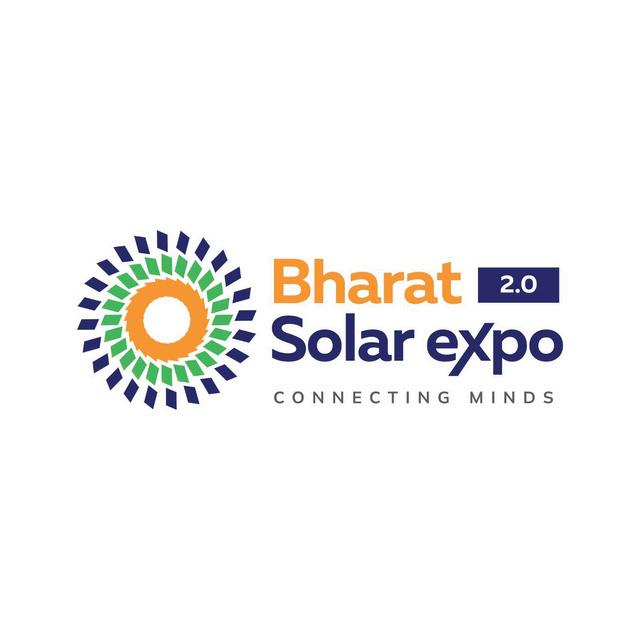














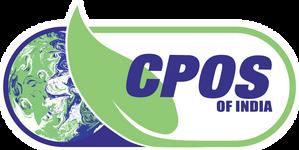












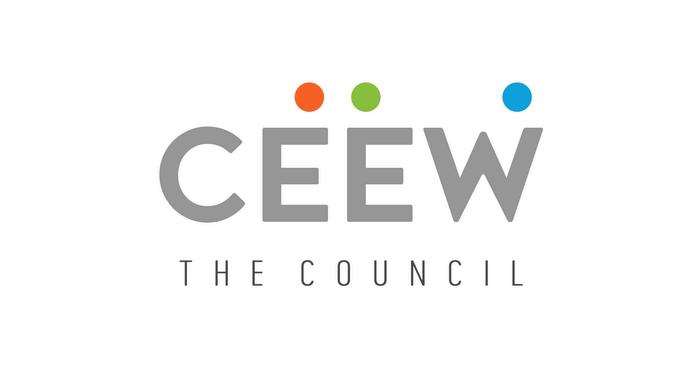










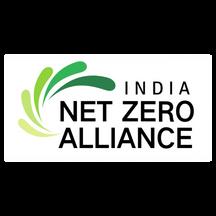



























The solar market's future looks promising, with solid growth prospects driven by technological, economic, and policy factors. The market is poised for significant growth driven by technological advancements, decreasing costs, and increasing global demand for renewable energy It enhances energy security, reduces reliance on the grid, and builds resilience during grid outages Energy storage systems play a crucial role in enhancing the viability and attractiveness of solar energy by improving reliability, reducing costs, and enabling broader adoption
Increased adoption of decentralized and off-grid solar solutions has opened up another vast area of growth for the solar Industry Some of the key aspects which make the future of the Solar Industry more attractive:
Continuous improvements in solar technology led to higher efficiencies and lower costs, making solar power more competitive
Supportive policies, subsidies, and incentives promote solar energy adoption, reducing financial barriers for investors
Increasing focus on sustainable energy sources boosts demand for solar power as countries aim to meet climate targets
Solar energy reduces dependency on fossil fuels, providing a stable and renewable energy source
Integration of Energy storage system increasing the reliability on solar power generation.
The captive, CNI, and Off-grid solar markets are playing crucial role for the growth of renewable energy adoption.
The Indian solar industry holds great potential, but there are some risks which requires strategic planning, policy stability, technological innovation, and financial support.
Unpredictable weather patterns, such as prolonged monsoons, dust storms, or reduced sunlight due to pollution, affecting solar power generation and impacting the financial performance of solar projects
The intermittent nature of solar power poses challenges in grid stability, especially in regions with high solar penetration
There are challenges related to waste management, particularly with the disposal of end-of-life solar panels.
India's heavy reliance on imported solar modules and other components, primarily from China, exposes the industry to supply chain disruptions and price fluctuations Any geopolitical tensions or trade restrictions can significantly impact the availability and cost of solar equipments.

Rapid advancements in solar technology are boosting the growth of industry, on the other hand it renders existing installations less competitive or obsolete It also creates problem in sourcing the required equipment for operating plants. There are some more challenges, like
Inconsistent policies
Delays in Approvals
Payment delays by DESCOMs
Tariff Volatility
Funding challenges, and Ǫuality Issues
Despite of several challenges, the future of Solar Industry seems promising Energy transition is the need of the time now Hence, solar Energy is not just an option but a necessity in the current global scenario. It addresses critical issues such as climate change, energy security, economic development, and environmental sustainability The continued growth and adoption of solar energy are essential to meet the global challenges of the 21st century

Availability of barren land suitable for large scale solar project development is another challenge and it will be more and more challenging in future Other land use may lead to conflicts with agriculture, forestry, and wildlife conservation efforts General Manager - Technical,
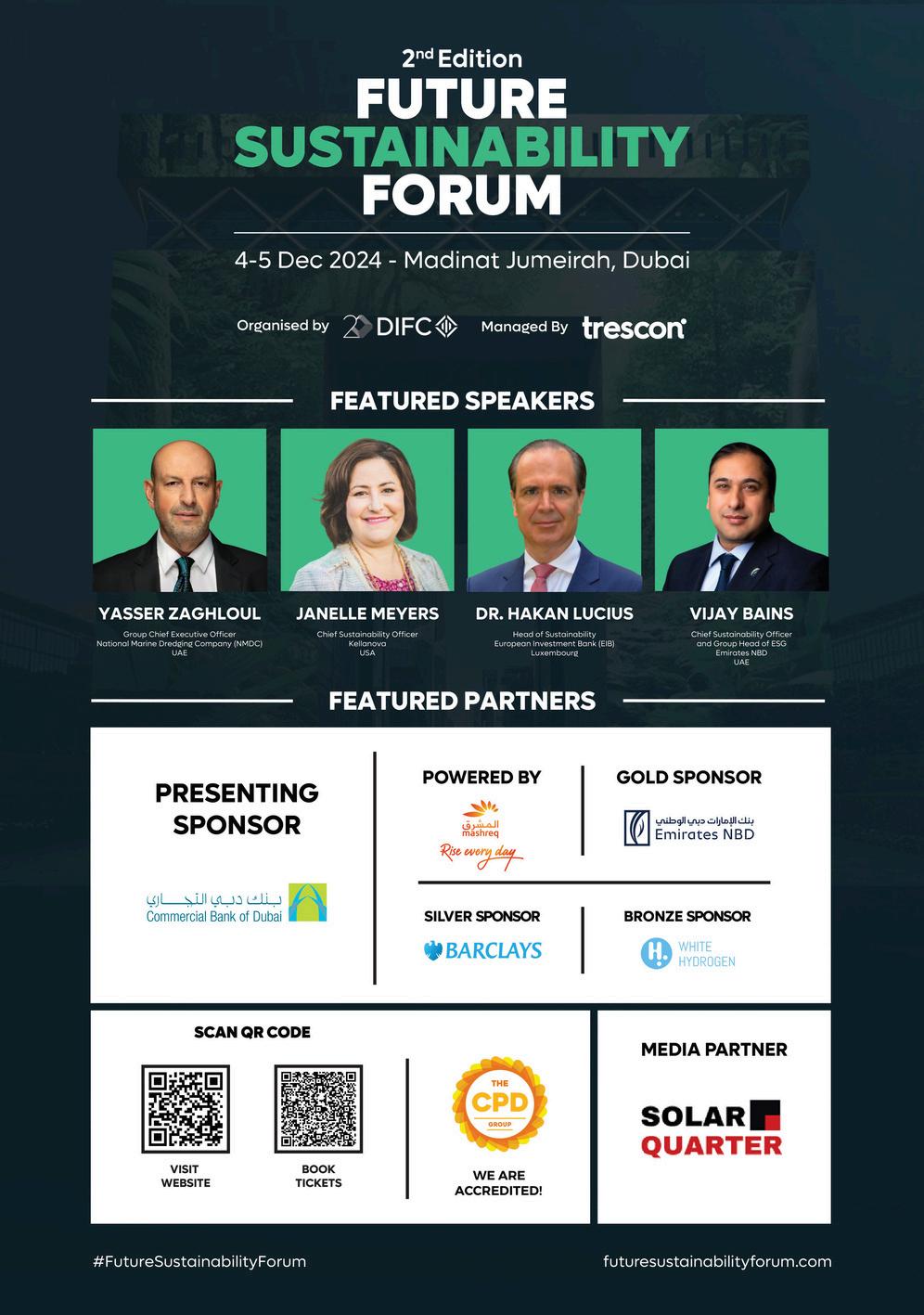

REI Expo 2024 emphasizes India's push for local solar manufacturing and global tech innovation
800+ suppliers, 50,000+ buyers, and highlights like BIO Energy, German Pavilion, and Investor Zone.
The expo highlights sustainability with solar power, EVs, and green practices
How will REI Expo 2024 differ from previous editions, and what can attendees expect?
The REI Expo aligns with national and international renewable energy goals, supporting government initiatives aimed at increasing the share of renewable in the energy mix and achieving sustainability targets The Expo brings together stakeholders from across the value chain; the expo creates opportunities for business growth, investment, and expansion in the renewable energy sector.
The 17th edition of Renewable Energy India Expo is all set to celebrate India’s Renewable Energy Achievements & the progress made by the industry Best of the brands exhibiting their latest innovations & technologies in the Renewable energy space More than 800+ suppliers are showcasing their products starting from Equipment’s, EPC Solutions, Solar Panels, Components, Inverters, Mounting Structures, Robotics, IOT Solutions & more Key attractions are BIO Energy Pavilion, German Pavilion, Investor Zone for start-up’s and a few more. Around 50,000+ Business Buyers are expected to attend the event in 3 days’ time (3rd to 5th October 2024, IEML, Greater Noida)
What's new this year! India Shining Independently with the support of many domestic suppliers India’s push for local solar manufacturing & Indigenous Solar production has become a reality for the country REI Expo to showcase the cutting-edge technology built by India enterprises for global market demand.
Power packed conference to welcome 300+ leading speakers from India & Overseas, 500+ delegates expected to attend the conference and Network The 2nd edition of The Battery show India is collocated with REI Expo with 250+ suppliers showcasing the battery materials, Chemistry & technology to address Energy storage & Mobility solution.
Which top brands are attending the REI Expo, and what innovations are they showcasing?
India has rapidly increased its solar power capacity, becoming one of the world's largest markets for solar energy India has set ambitious goals to transition from fossil fuels to renewable sources, with a particular focus on solar, wind, and bio-energy.
In this context, the industry made impressive progress in setting up manufacturing facilities, Technology transfer, Business Partnership, creating skill sets and more As a show organizer, we always believe REI Expo’s objective is to showcase Industry achievements on display 2024 edition to witness cutting edge technology, New Products & Solutions from top brands like Reliance, Waaree Energies, Adani Solar, Vikram Solar, Premier Energies, Havells, Gautam Solar, Goldi Solar, Grew Energy, DNV, Swelect, Emmvee to name a few
Check out for entire list: https://www.renewableenergyindiaexpo.com/
What new technologies will be showcased at REI Expo 2024, and how do they reflect industry trends?
REI Expo objective is to present the latest technological advancements to inspire and inform stakeholders, including businesses, government officials, and the investors Simultaneously, India’s focus on energy security is commendable to ensure a stable, reliable, and sustainable energy supply for its growing economy.
Demand for high quality products is driving the Industrial Revolution & welcoming the latest technology to India. REI being the industry preferred platform for many years, we are expecting many product launches, cutting edge technologies, High quality inverters & Storage solutions at the event Distributed solar is a key area to focus on; Exhibitors have great solutions for the Residential and Commercial & Industrial segments
The marketing team is making every possible effort to reach all the Residential and Commercial welfare associations, Industrial Associations & Chambers and Rural societies to take advantage of the government scheme and benefit the nation by adopting Solar as a Solution.
How does REI Expo 2024 support startups & which ones are featured?
The sector is filled with many new entities, REI Expo for many years made all possible efforts to support Small & Medium Enterprises Even in 2024, we have a start-up Pavilion, Fundraising activities for Start-ups and a strong success rate for beginners at the show The forum is created to ensure Small to large firms gain full benefits from the platform. The vendors of PM Surya Ghar Muft Bijli Yojana going to gain full benefits & Exposure about the products Special education & Contest “Solar Installers Premier League” hosted during the show by our event partner to showcase the efficiency of installation & Best Practices followed by Industry leaders. This activity is going to empower New Entrepreneurs to understand the Process, Product & Performance of this sector
How does REI Expo 2024 promote sustainability, and which brands lead?
Reducing the carbon footprint has become a critical necessity in today's world due to Climate Change Mitigation, Public Health, Economic Stability and Future Generation. Informa India is playing a very important role in greening the nation by hosting Renewable Energy India Expo & The Battery Show India together This combo is going to address the energy transition & Mobility Transition to a larger audience. As an exhibition organizer, we are very proud to host the event at IEML, Greater Noida, Powered by Solar Rooftop Encourage attendees to use Metro Transportation, EV Vehicles are used for internal mobility for visitors, Reusable materials for stall building, Water dispensers to avoid water bottles, Contactless Registration to avoid papers and more
In today’s world, we all understand that actions we take today will determine the quality of life for those who come after us It's a collective effort that requires action from individuals, businesses, and governments
How will REI Expo 2024 impact the industry and its future?
Joining with the world “Our Mission is NO Emission” – Reducing our carbon footprint is necessary to ensure a liveable planet for future generations India is doing a great job in this space of greening the nation As an organization, Organizer, Citizen of this great nation, we are committed to support all the initiatives taken by the Government REI Expo will make every possible effort to fast track our Net Zero Vision dream before the set target Make an effort to be with us at REI Expo, “Together we Sustain”



SOLARQUARTER
STATE LEADERSHIP AWARDS
2024

Leadership guides Karnataka toward a brighter tomorrow. By honoring visionary leaders, we celebrate the progress of our great state.




State Market Leader AwardInverter
SOLIS

State Market Leader AwardModules
Saatvik Green Energy Pvt. Ltd.

Atmanirbhar India State Business Leader - Inverter
FESTON S.E.V. PRIVATE LIMITED

Smart Technology Innovation of the Year - Solar Design Software
ARKA 360 (formerly Solar Labs)

Smart Innovative Project of the Year
Premium Renewables India Pvt. Ltd.

Emerging Module Manufacturer
Novasys Greenergy Pvt. Ltd.



State Market Leader Award (In DCR) - Modules
Mundra Solar Energy Limited


Smart Technology Innovation of the Year - Modules
Gautam Solar Private Limited

Smart Technology Innovation of the Year - Inverter
SolaX Power Network Technology (Zhejiang) Co., Ltd.

State Technology Leadership Award
iPLON India Pvt. Ltd.
Solar EPC Company of the Year - C&I
Best Project of the YearWind Solar Hybrid
NeoGreen Power Pvt. Ltd.

Solar System Integrator of the Year
Cranfinia Energy Pvt. Ltd.







Best Engineering Team of the Year
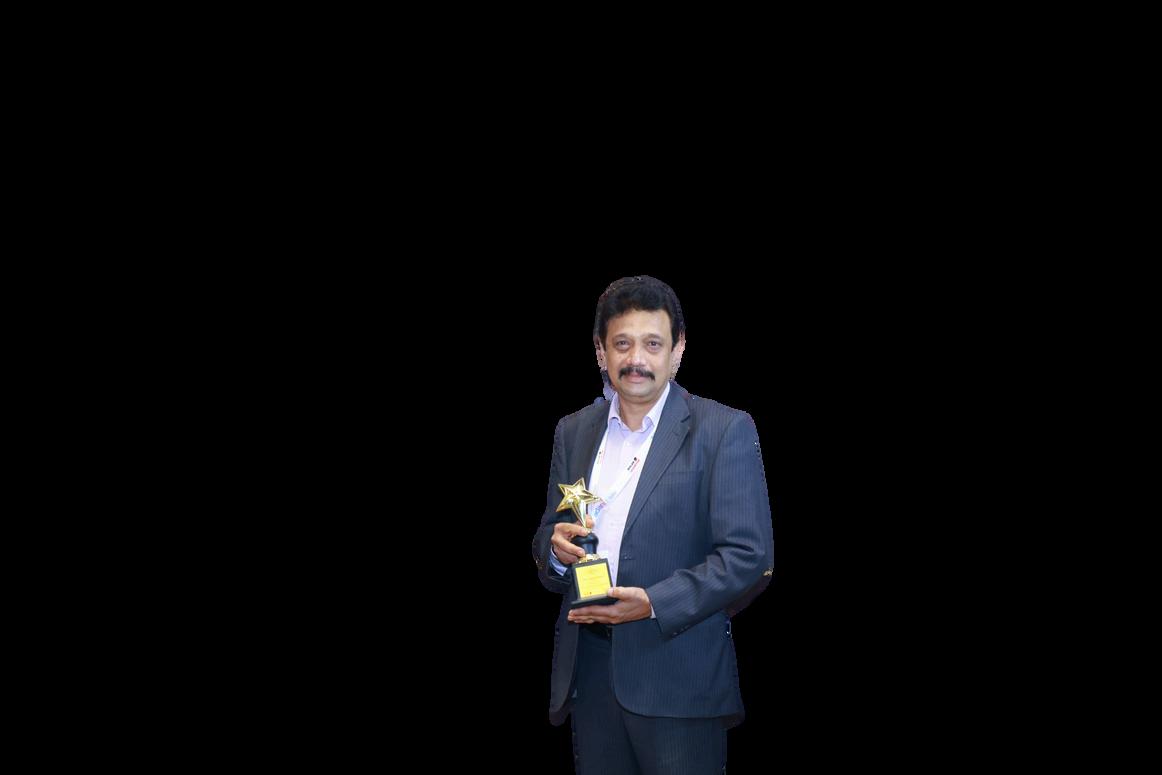





Net Zero Leaders of India 2023 2024, recognizing individuals and organizations at the forefront of India's transition to a low-carbon and sustainable economy This prestigious list highlights exemplary leadership, innovation, and commitment to achieving net-zero emissions across diverse sectors By honoring these leaders, INZA aims to inspire broader action and collaboration within India’s business, policy, and civil society to address the challenges posed by climate change.

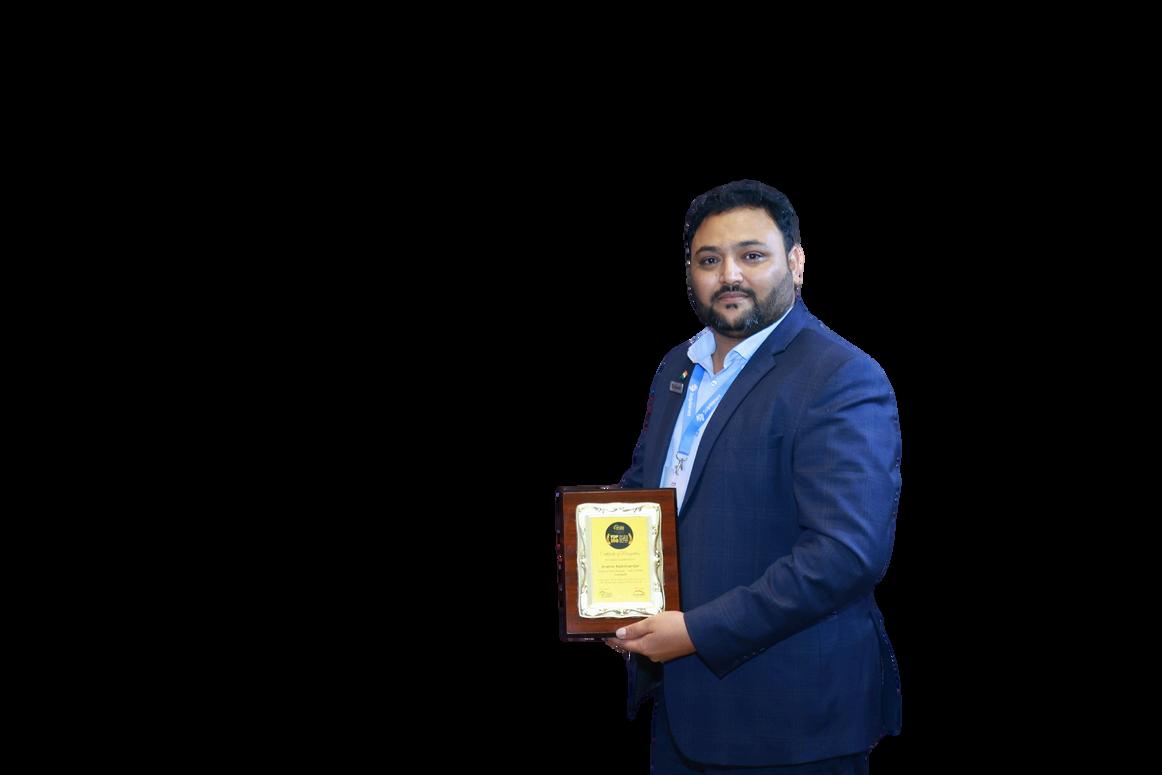
Regional



The Solar EPC Week 2024 is set to be a landmark event, celebrating excellence in the solar industry across India. This prestigious event brings together key stakeholders, including industry leaders, government officials, innovators, and influencers, to discuss the future of solar energy. As part of the week, the India Leadership Awards will recognize outstanding contributions in Engineering, Procurement, and Construction (EPC) within the solar sector. These awards highlight companies and individuals driving the nation's transition towards clean energy and sustainable development



Most Preferred Company of the Year: EPC (Ground Mount) - Platinum
Hartek Solar Private Limited
Most Preferred Company of the Year: EPC (Ground Mount) - Diamond
Saatvik Green Energy Pvt. Ltd.

Most Preferred EPC Company of the Year - Institutional
Natsakee Incorporation

10-Year Milestone of Inverter Excellence in India Award
Sungrow India Pvt. Ltd.

Most Preferred Company of the Year: Supply Chain Excellence





Most Preferred Company of the Year: EPC (Ground Mount) - Gold
Pack & Dec Industries
Most Preferred Company of the Year: EPC (Rooftop)Platinum
SunGreen Power & Renewable Energy Pvt Ltd
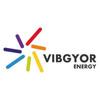

Most Preferred Company of the Year: EPC (Rooftop)Diamond
Vibgyor Energy
Most Preferred Solar EPC in the Telecom Industry
Most Preferred Company of the Year: Risk Management


Most Preferred Equipment Manufacturer of the YearSolar Modules Natsakee Incorporation
Gautam Solar
Most Preferred Equipment Manufacturer of the YearJunction Box
GenX PV
Most Preferred Equipment Manufacturer of the YearStructures
Purshotam Profiles Pvt. Ltd.

Most Preferred Equipment Manufacturer of the YearTrackers
GameChange Solar



India’s Largest Vertically Integrated Solar Manufacturing Company (Ingots – Modules)
Mundra Solar Energy Limited
Most Preferred Company of the Year - Customer Service Excellence
Savorka Solar

rational Leader of the Year
MRAN NAQVI
utive Director, Engineering Limited KUMAR

Most Preferred Company of the Year: Distributor
GP-Eco Solutions India Ltd.

n Leader of the Year
ead,
0 formerly The Solar Labs

RAJAN MUNJAL

Excellence in Module
Manufacturing
Novasys Greenergy Pvt. Ltd.


Excellence in Project Construction Management
Vibgyor Energy



Project Design Team of the Year
Vibgyor Energy
Project Construction T the Year
Natsakee Incorporation


Emerging Leader of the Year Leader - Channel Sales, Sungrow India Pvt. Ltd.
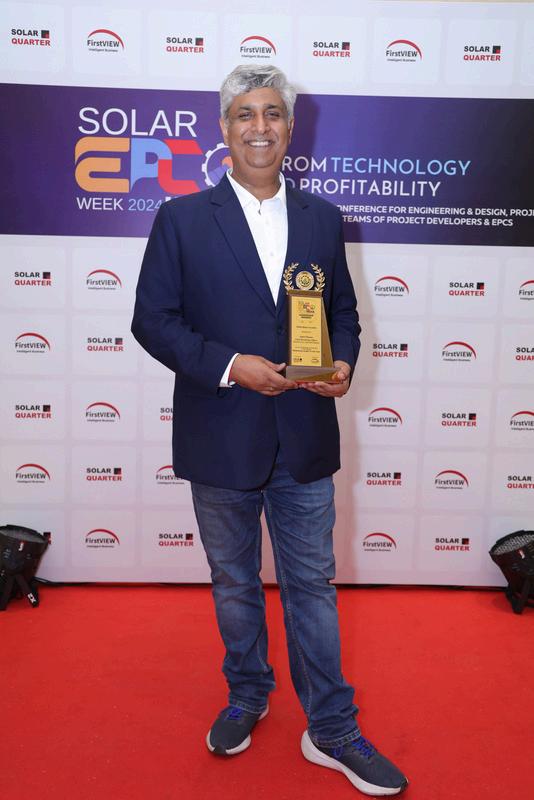
ng Leader of the Year
THUSSU,
arketing Officer,
N S.E.V. PVT. LTD.

Young Trailblazer of the Year
VIJAY K. PATODIA
Managing Director, S nGreen Power & Renewable ergy Pvt Ltd
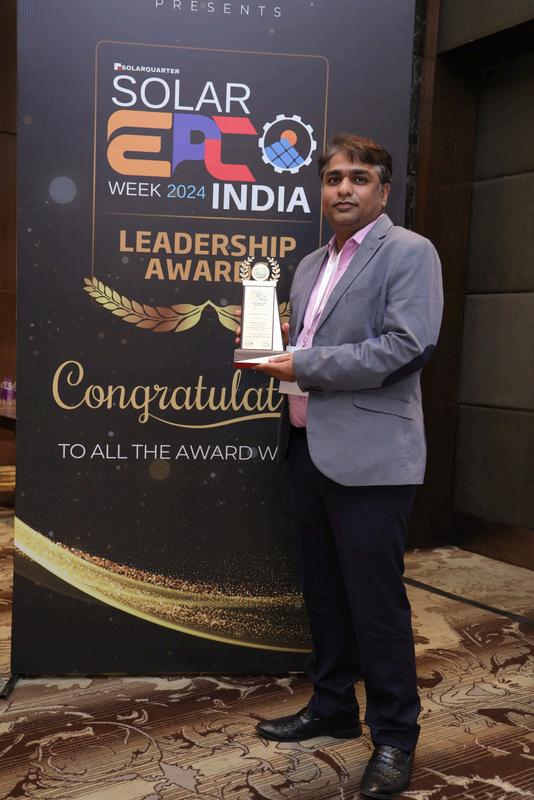
ung Visionary of the Year
NURAG SRIVASTAVA
under & CEO, odhyawasi Corporation OPC t. Ltd.


SIMARPREET SINGH,
Business Leader of the Year Director
Hartek Group
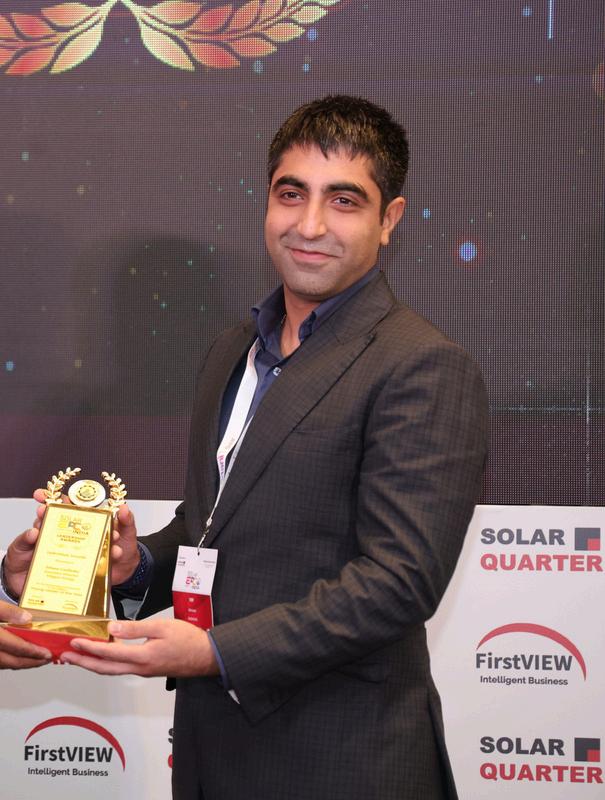
ng Leader of the Year
HAAN GADHOKE
cutive Director, gyor Energy

preneur of the Year
SH GARG
etor, kee Incorporation
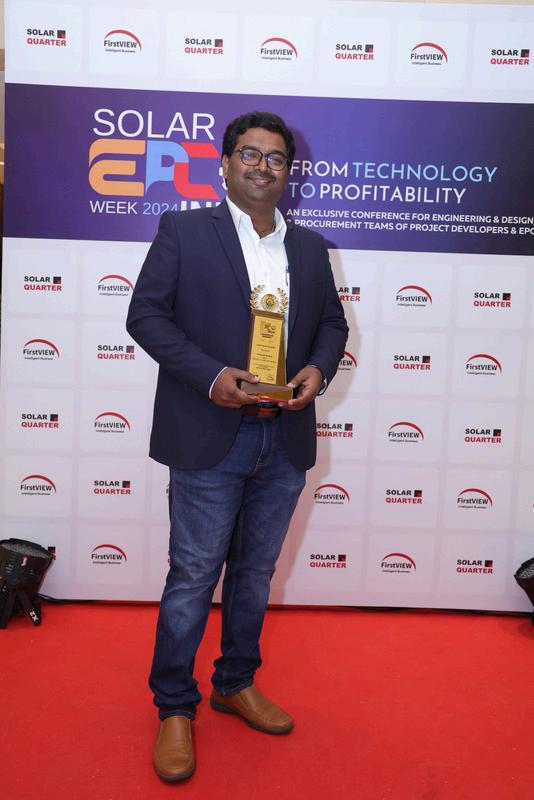
he Year
TH KUMAR
S.E.V. PVT. LTD.

Indian Energy Exchange, India’s premier electricity exchange, achieved the highest ever total volume (including certificates) of 13,250 MU in July 2024, marking a 56% year-over-year increase The electricity volume at 10,093 MU, increased 29% YoY Green electricity volume during the month at 1 BU, grew 259% YoY. The renewable energy certificates (REC) at 3,150 MU, increased 405% YoY. At ₹120 per certificate, the REC market recorded an all-time low price in the trading session held on 31st July 2024 These prices provide an opportunity to obligated entities (DISCOMS and Captive Power Producers) to meet their Renewable Purchase Obligations, and voluntary customers to meet their sustainability aspirations According to government data published in July 2024, the country's energy consumption reached 145.4 BUs, representing 4% increase year-on-year.
The imposition of Basic Customs Duty (BCD) on Solar PV modules and cells in India has introduced significant fluctuations in tariff rates for solar auctions. This challenge is further compounded by the volatility in currency exchange rates and the implementation of the Approved List of Models and Manufacturers (ALMM) since April 2024. Geopolitical tensions, particularly from the ongoing Russia-Ukraine conflict, have added to the strain on the solar sector. However, there is a silver lining for project developers, as the government has extended commissioning deadlines, acknowledging the disruptions in the solar supply chain
In 2024, India’s solar tariffs remain highly susceptible to fluctuations due to a variety of factors These include changes in the costs of solar panels and installation, global energy price shifts, and adjustments in governmental policies related to subsidies and renewable energy targets Additionally, variables specific to each project such as size, location, and grid connectivity play a crucial role in determining final tariff outcomes Technological advancements, intense competition in bidding processes, and the increasing focus on large-scale solar projects also contribute to the variability in tariffs Furthermore, policy shifts, the availability of viability gap funding, and growing interest in innovative solutions like floating solar projects continue to shape tariff rates, with long-term contracts offering some stability in an otherwise turbulent market

